Effectiveness of Health Education Interventions in Preventing Smoking in Adolescents
VerifiedAdded on 2023/01/07
|49
|14903
|63
AI Summary
This dissertation examines the effectiveness of health education interventions in preventing smoking among adolescents. It explores various strategies and interventions used in different studies and their impact on smoking cessation. The research also provides recommendations for future research in this area.
Contribute Materials
Your contribution can guide someone’s learning journey. Share your
documents today.

REVIEW QUESTION: ARE HEALTH EDUCATION INTERVENTION EFFECTIVE IN PREVENTING SMOKING IN
ADOLESCENTS?
WORD COUNTS: 8000 WORDS EXCLUDING TITLE PAGE, APPENDICES AND REFERENCES
ACKNOWLEDGEMENTS
1 | P a g e
ADOLESCENTS?
WORD COUNTS: 8000 WORDS EXCLUDING TITLE PAGE, APPENDICES AND REFERENCES
ACKNOWLEDGEMENTS
1 | P a g e
Secure Best Marks with AI Grader
Need help grading? Try our AI Grader for instant feedback on your assignments.

I give thanks and glory to the Almighty God who made this dream come true.
I would like to express my utmost thankfulness to my husband and children in supporting my vision.
ABSTRACT
2 | P a g e
I would like to express my utmost thankfulness to my husband and children in supporting my vision.
ABSTRACT
2 | P a g e
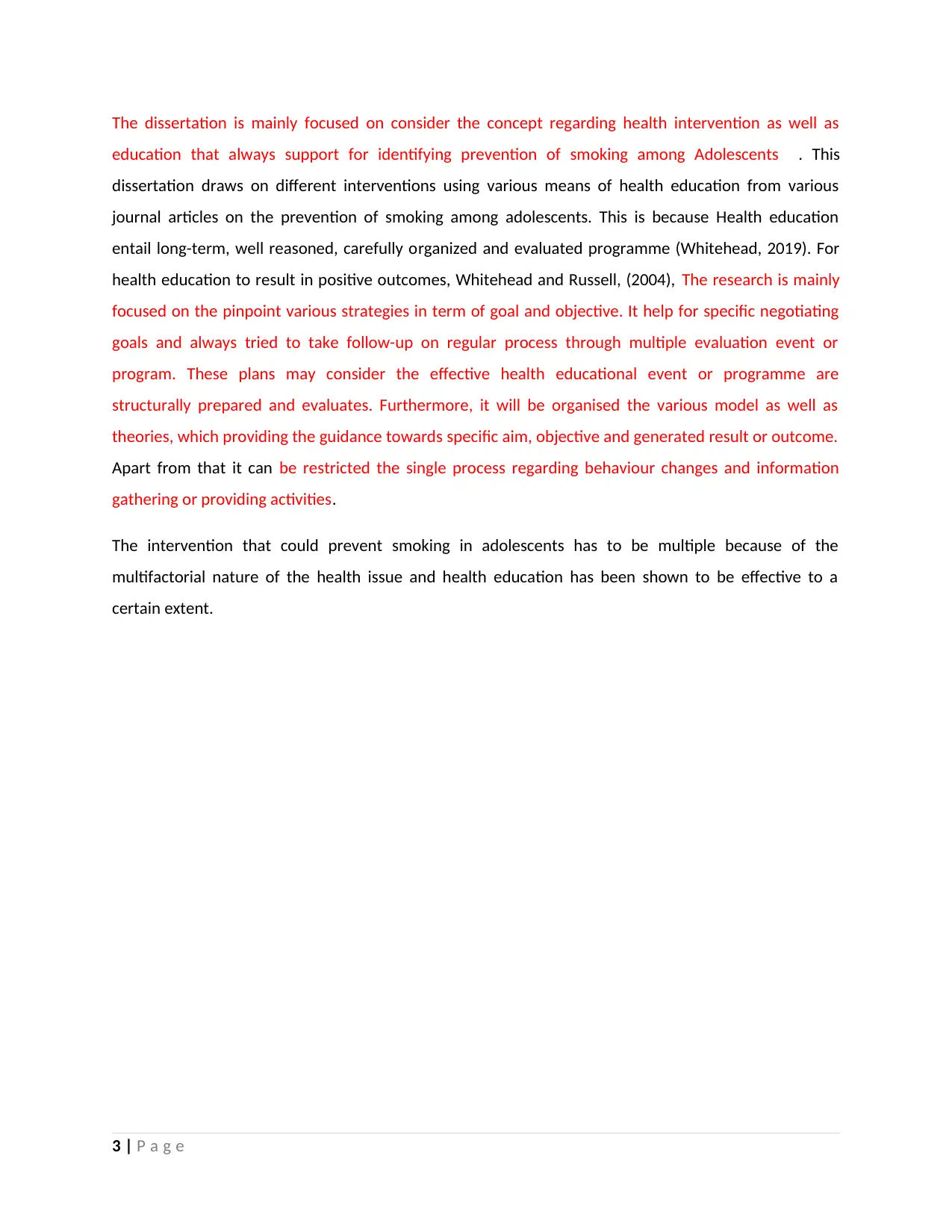
The dissertation is mainly focused on consider the concept regarding health intervention as well as
education that always support for identifying prevention of smoking among Adolescents . This
dissertation draws on different interventions using various means of health education from various
journal articles on the prevention of smoking among adolescents. This is because Health education
entail long-term, well reasoned, carefully organized and evaluated programme (Whitehead, 2019). For
health education to result in positive outcomes, Whitehead and Russell, (2004), The research is mainly
focused on the pinpoint various strategies in term of goal and objective. It help for specific negotiating
goals and always tried to take follow-up on regular process through multiple evaluation event or
program. These plans may consider the effective health educational event or programme are
structurally prepared and evaluates. Furthermore, it will be organised the various model as well as
theories, which providing the guidance towards specific aim, objective and generated result or outcome.
Apart from that it can be restricted the single process regarding behaviour changes and information
gathering or providing activities.
The intervention that could prevent smoking in adolescents has to be multiple because of the
multifactorial nature of the health issue and health education has been shown to be effective to a
certain extent.
3 | P a g e
education that always support for identifying prevention of smoking among Adolescents . This
dissertation draws on different interventions using various means of health education from various
journal articles on the prevention of smoking among adolescents. This is because Health education
entail long-term, well reasoned, carefully organized and evaluated programme (Whitehead, 2019). For
health education to result in positive outcomes, Whitehead and Russell, (2004), The research is mainly
focused on the pinpoint various strategies in term of goal and objective. It help for specific negotiating
goals and always tried to take follow-up on regular process through multiple evaluation event or
program. These plans may consider the effective health educational event or programme are
structurally prepared and evaluates. Furthermore, it will be organised the various model as well as
theories, which providing the guidance towards specific aim, objective and generated result or outcome.
Apart from that it can be restricted the single process regarding behaviour changes and information
gathering or providing activities.
The intervention that could prevent smoking in adolescents has to be multiple because of the
multifactorial nature of the health issue and health education has been shown to be effective to a
certain extent.
3 | P a g e
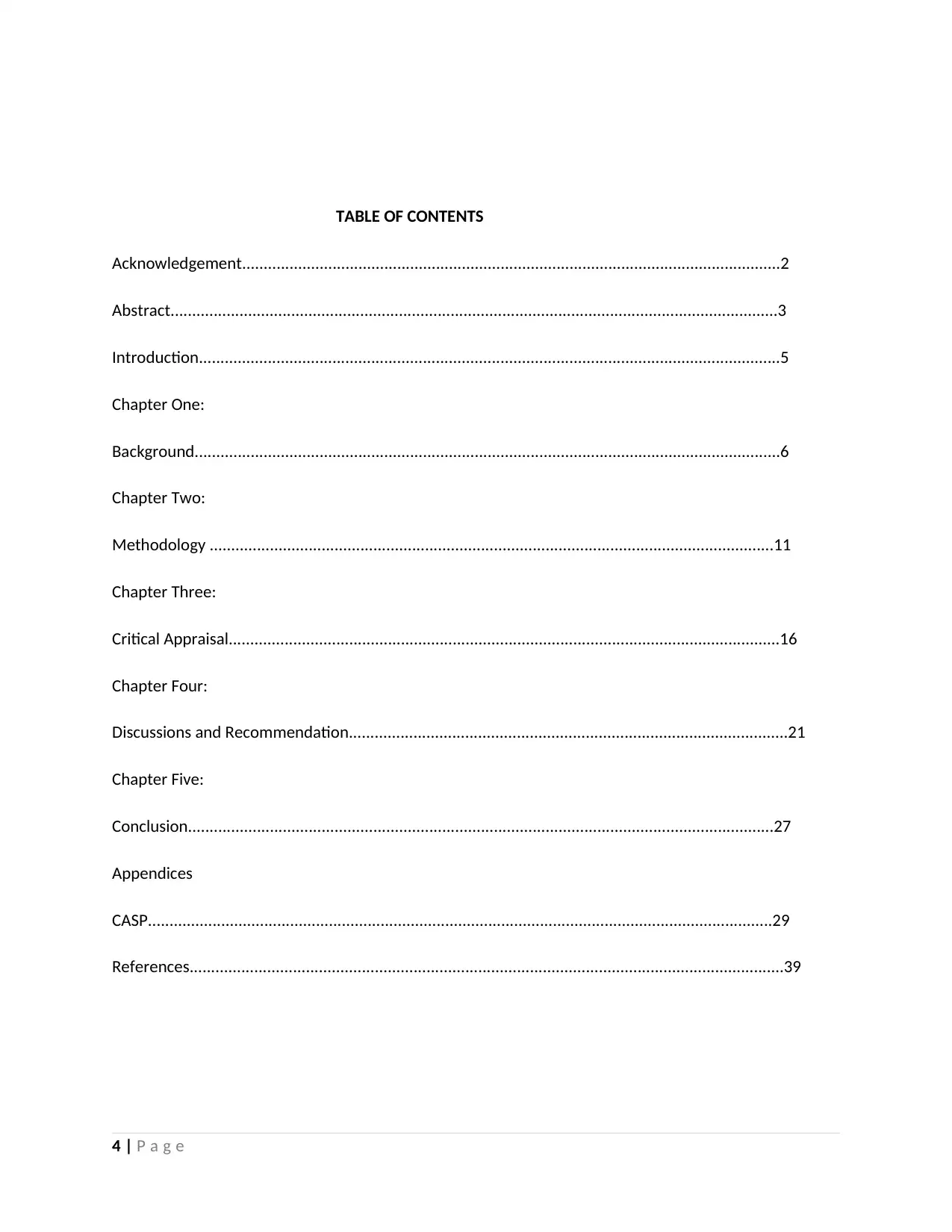
TABLE OF CONTENTS
Acknowledgement.............................................................................................................................2
Abstract.............................................................................................................................................3
Introduction.......................................................................................................................................5
Chapter One:
Background........................................................................................................................................6
Chapter Two:
Methodology ...................................................................................................................................11
Chapter Three:
Critical Appraisal................................................................................................................................16
Chapter Four:
Discussions and Recommendation......................................................................................................21
Chapter Five:
Conclusion........................................................................................................................................27
Appendices
CASP.................................................................................................................................................29
References..........................................................................................................................................39
4 | P a g e
Acknowledgement.............................................................................................................................2
Abstract.............................................................................................................................................3
Introduction.......................................................................................................................................5
Chapter One:
Background........................................................................................................................................6
Chapter Two:
Methodology ...................................................................................................................................11
Chapter Three:
Critical Appraisal................................................................................................................................16
Chapter Four:
Discussions and Recommendation......................................................................................................21
Chapter Five:
Conclusion........................................................................................................................................27
Appendices
CASP.................................................................................................................................................29
References..........................................................................................................................................39
4 | P a g e
Paraphrase This Document
Need a fresh take? Get an instant paraphrase of this document with our AI Paraphraser
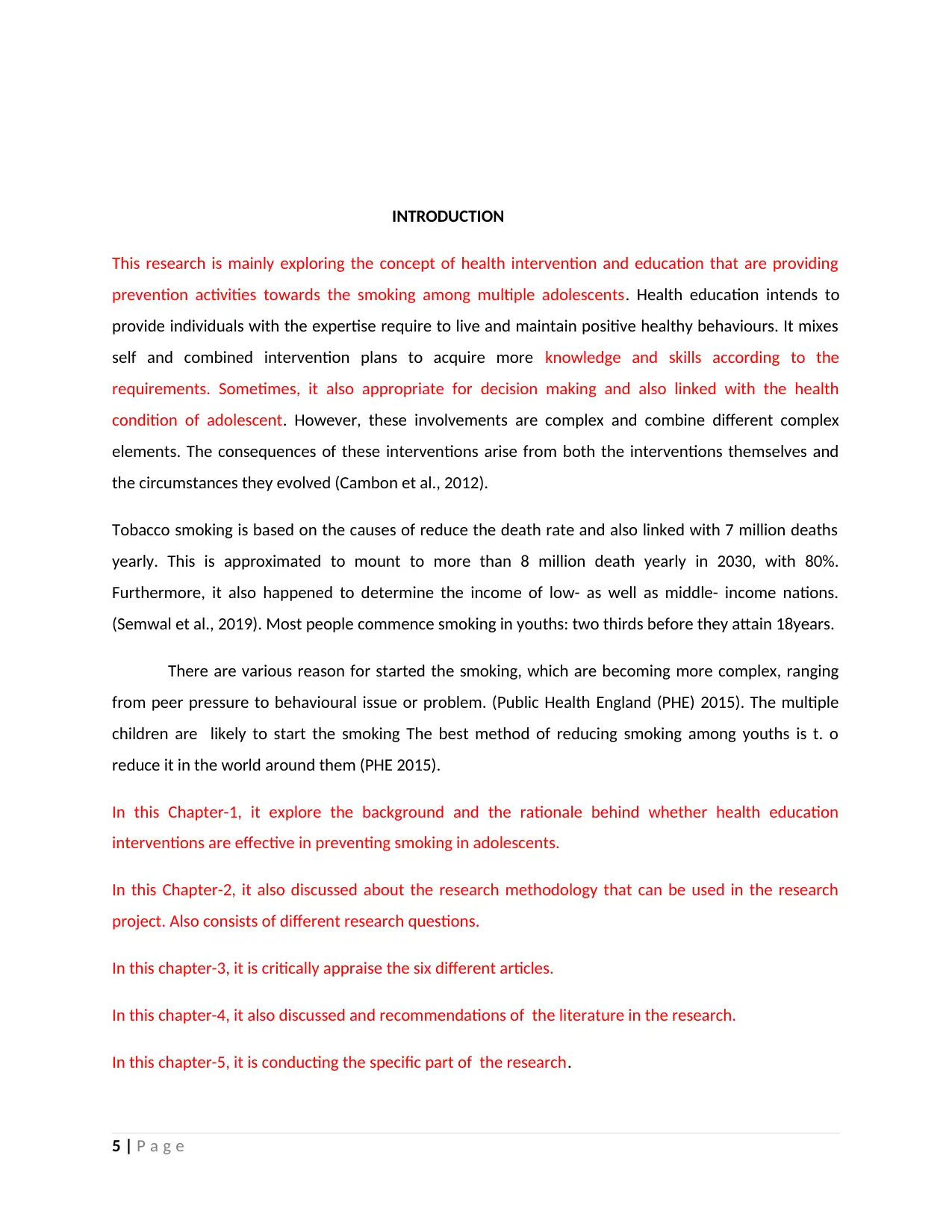
INTRODUCTION
This research is mainly exploring the concept of health intervention and education that are providing
prevention activities towards the smoking among multiple adolescents. Health education intends to
provide individuals with the expertise require to live and maintain positive healthy behaviours. It mixes
self and combined intervention plans to acquire more knowledge and skills according to the
requirements. Sometimes, it also appropriate for decision making and also linked with the health
condition of adolescent. However, these involvements are complex and combine different complex
elements. The consequences of these interventions arise from both the interventions themselves and
the circumstances they evolved (Cambon et al., 2012).
Tobacco smoking is based on the causes of reduce the death rate and also linked with 7 million deaths
yearly. This is approximated to mount to more than 8 million death yearly in 2030, with 80%.
Furthermore, it also happened to determine the income of low- as well as middle- income nations.
(Semwal et al., 2019). Most people commence smoking in youths: two thirds before they attain 18years.
There are various reason for started the smoking, which are becoming more complex, ranging
from peer pressure to behavioural issue or problem. (Public Health England (PHE) 2015). The multiple
children are likely to start the smoking The best method of reducing smoking among youths is t. o
reduce it in the world around them (PHE 2015).
In this Chapter-1, it explore the background and the rationale behind whether health education
interventions are effective in preventing smoking in adolescents.
In this Chapter-2, it also discussed about the research methodology that can be used in the research
project. Also consists of different research questions.
In this chapter-3, it is critically appraise the six different articles.
In this chapter-4, it also discussed and recommendations of the literature in the research.
In this chapter-5, it is conducting the specific part of the research.
5 | P a g e
This research is mainly exploring the concept of health intervention and education that are providing
prevention activities towards the smoking among multiple adolescents. Health education intends to
provide individuals with the expertise require to live and maintain positive healthy behaviours. It mixes
self and combined intervention plans to acquire more knowledge and skills according to the
requirements. Sometimes, it also appropriate for decision making and also linked with the health
condition of adolescent. However, these involvements are complex and combine different complex
elements. The consequences of these interventions arise from both the interventions themselves and
the circumstances they evolved (Cambon et al., 2012).
Tobacco smoking is based on the causes of reduce the death rate and also linked with 7 million deaths
yearly. This is approximated to mount to more than 8 million death yearly in 2030, with 80%.
Furthermore, it also happened to determine the income of low- as well as middle- income nations.
(Semwal et al., 2019). Most people commence smoking in youths: two thirds before they attain 18years.
There are various reason for started the smoking, which are becoming more complex, ranging
from peer pressure to behavioural issue or problem. (Public Health England (PHE) 2015). The multiple
children are likely to start the smoking The best method of reducing smoking among youths is t. o
reduce it in the world around them (PHE 2015).
In this Chapter-1, it explore the background and the rationale behind whether health education
interventions are effective in preventing smoking in adolescents.
In this Chapter-2, it also discussed about the research methodology that can be used in the research
project. Also consists of different research questions.
In this chapter-3, it is critically appraise the six different articles.
In this chapter-4, it also discussed and recommendations of the literature in the research.
In this chapter-5, it is conducting the specific part of the research.
5 | P a g e
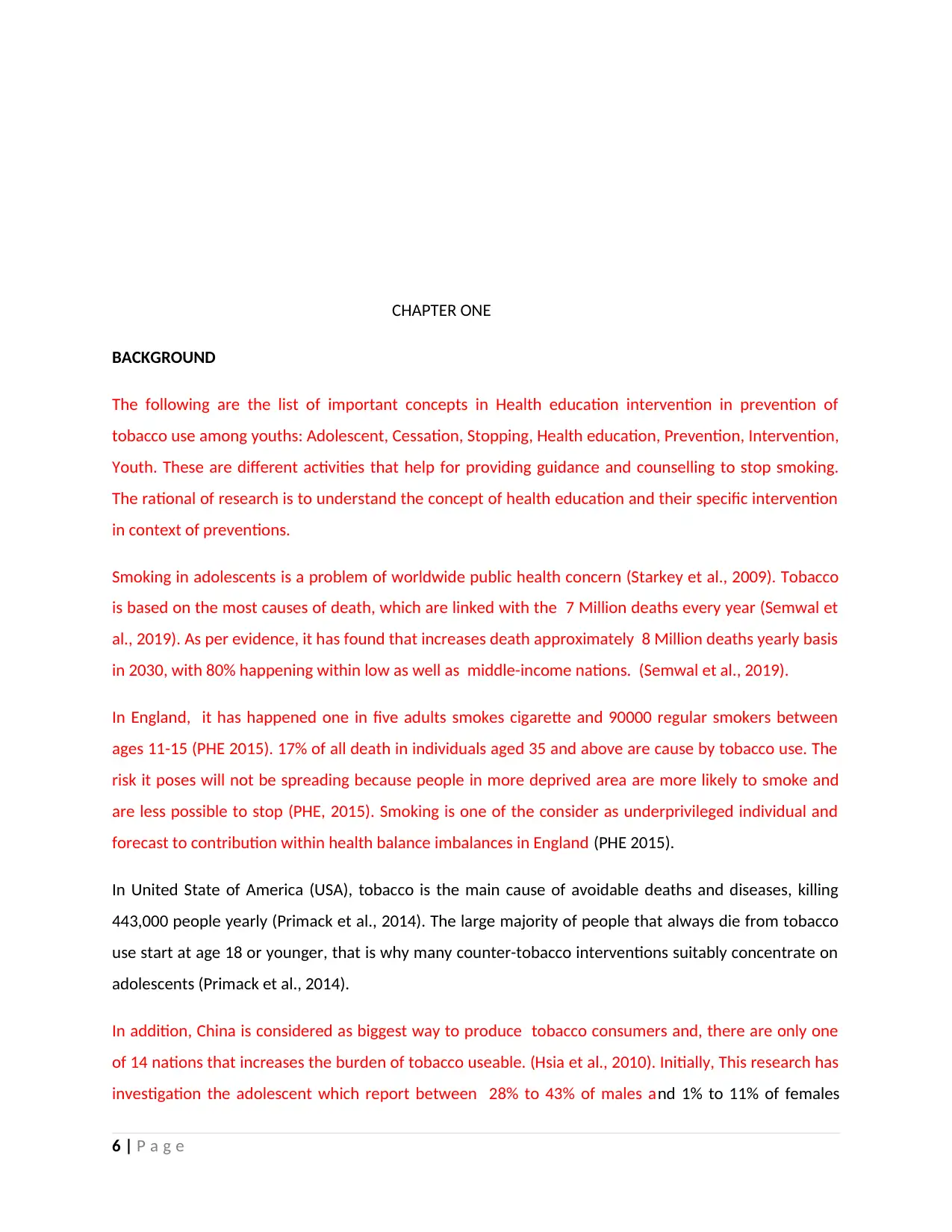
CHAPTER ONE
BACKGROUND
The following are the list of important concepts in Health education intervention in prevention of
tobacco use among youths: Adolescent, Cessation, Stopping, Health education, Prevention, Intervention,
Youth. These are different activities that help for providing guidance and counselling to stop smoking.
The rational of research is to understand the concept of health education and their specific intervention
in context of preventions.
Smoking in adolescents is a problem of worldwide public health concern (Starkey et al., 2009). Tobacco
is based on the most causes of death, which are linked with the 7 Million deaths every year (Semwal et
al., 2019). As per evidence, it has found that increases death approximately 8 Million deaths yearly basis
in 2030, with 80% happening within low as well as middle-income nations. (Semwal et al., 2019).
In England, it has happened one in five adults smokes cigarette and 90000 regular smokers between
ages 11-15 (PHE 2015). 17% of all death in individuals aged 35 and above are cause by tobacco use. The
risk it poses will not be spreading because people in more deprived area are more likely to smoke and
are less possible to stop (PHE, 2015). Smoking is one of the consider as underprivileged individual and
forecast to contribution within health balance imbalances in England (PHE 2015).
In United State of America (USA), tobacco is the main cause of avoidable deaths and diseases, killing
443,000 people yearly (Primack et al., 2014). The large majority of people that always die from tobacco
use start at age 18 or younger, that is why many counter-tobacco interventions suitably concentrate on
adolescents (Primack et al., 2014).
In addition, China is considered as biggest way to produce tobacco consumers and, there are only one
of 14 nations that increases the burden of tobacco useable. (Hsia et al., 2010). Initially, This research has
investigation the adolescent which report between 28% to 43% of males and 1% to 11% of females
6 | P a g e
BACKGROUND
The following are the list of important concepts in Health education intervention in prevention of
tobacco use among youths: Adolescent, Cessation, Stopping, Health education, Prevention, Intervention,
Youth. These are different activities that help for providing guidance and counselling to stop smoking.
The rational of research is to understand the concept of health education and their specific intervention
in context of preventions.
Smoking in adolescents is a problem of worldwide public health concern (Starkey et al., 2009). Tobacco
is based on the most causes of death, which are linked with the 7 Million deaths every year (Semwal et
al., 2019). As per evidence, it has found that increases death approximately 8 Million deaths yearly basis
in 2030, with 80% happening within low as well as middle-income nations. (Semwal et al., 2019).
In England, it has happened one in five adults smokes cigarette and 90000 regular smokers between
ages 11-15 (PHE 2015). 17% of all death in individuals aged 35 and above are cause by tobacco use. The
risk it poses will not be spreading because people in more deprived area are more likely to smoke and
are less possible to stop (PHE, 2015). Smoking is one of the consider as underprivileged individual and
forecast to contribution within health balance imbalances in England (PHE 2015).
In United State of America (USA), tobacco is the main cause of avoidable deaths and diseases, killing
443,000 people yearly (Primack et al., 2014). The large majority of people that always die from tobacco
use start at age 18 or younger, that is why many counter-tobacco interventions suitably concentrate on
adolescents (Primack et al., 2014).
In addition, China is considered as biggest way to produce tobacco consumers and, there are only one
of 14 nations that increases the burden of tobacco useable. (Hsia et al., 2010). Initially, This research has
investigation the adolescent which report between 28% to 43% of males and 1% to 11% of females
6 | P a g e
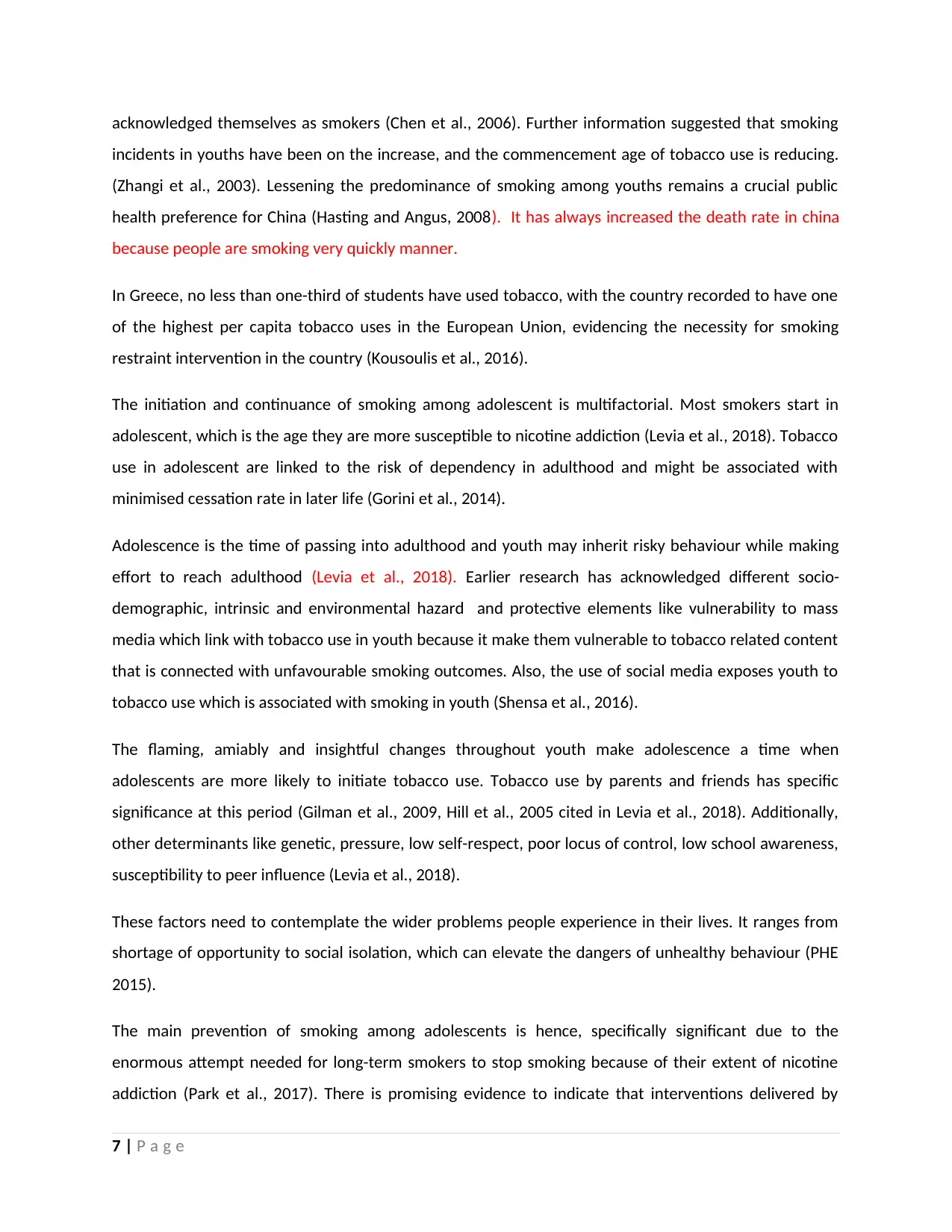
acknowledged themselves as smokers (Chen et al., 2006). Further information suggested that smoking
incidents in youths have been on the increase, and the commencement age of tobacco use is reducing.
(Zhangi et al., 2003). Lessening the predominance of smoking among youths remains a crucial public
health preference for China (Hasting and Angus, 2008). It has always increased the death rate in china
because people are smoking very quickly manner.
In Greece, no less than one-third of students have used tobacco, with the country recorded to have one
of the highest per capita tobacco uses in the European Union, evidencing the necessity for smoking
restraint intervention in the country (Kousoulis et al., 2016).
The initiation and continuance of smoking among adolescent is multifactorial. Most smokers start in
adolescent, which is the age they are more susceptible to nicotine addiction (Levia et al., 2018). Tobacco
use in adolescent are linked to the risk of dependency in adulthood and might be associated with
minimised cessation rate in later life (Gorini et al., 2014).
Adolescence is the time of passing into adulthood and youth may inherit risky behaviour while making
effort to reach adulthood (Levia et al., 2018). Earlier research has acknowledged different socio-
demographic, intrinsic and environmental hazard and protective elements like vulnerability to mass
media which link with tobacco use in youth because it make them vulnerable to tobacco related content
that is connected with unfavourable smoking outcomes. Also, the use of social media exposes youth to
tobacco use which is associated with smoking in youth (Shensa et al., 2016).
The flaming, amiably and insightful changes throughout youth make adolescence a time when
adolescents are more likely to initiate tobacco use. Tobacco use by parents and friends has specific
significance at this period (Gilman et al., 2009, Hill et al., 2005 cited in Levia et al., 2018). Additionally,
other determinants like genetic, pressure, low self-respect, poor locus of control, low school awareness,
susceptibility to peer influence (Levia et al., 2018).
These factors need to contemplate the wider problems people experience in their lives. It ranges from
shortage of opportunity to social isolation, which can elevate the dangers of unhealthy behaviour (PHE
2015).
The main prevention of smoking among adolescents is hence, specifically significant due to the
enormous attempt needed for long-term smokers to stop smoking because of their extent of nicotine
addiction (Park et al., 2017). There is promising evidence to indicate that interventions delivered by
7 | P a g e
incidents in youths have been on the increase, and the commencement age of tobacco use is reducing.
(Zhangi et al., 2003). Lessening the predominance of smoking among youths remains a crucial public
health preference for China (Hasting and Angus, 2008). It has always increased the death rate in china
because people are smoking very quickly manner.
In Greece, no less than one-third of students have used tobacco, with the country recorded to have one
of the highest per capita tobacco uses in the European Union, evidencing the necessity for smoking
restraint intervention in the country (Kousoulis et al., 2016).
The initiation and continuance of smoking among adolescent is multifactorial. Most smokers start in
adolescent, which is the age they are more susceptible to nicotine addiction (Levia et al., 2018). Tobacco
use in adolescent are linked to the risk of dependency in adulthood and might be associated with
minimised cessation rate in later life (Gorini et al., 2014).
Adolescence is the time of passing into adulthood and youth may inherit risky behaviour while making
effort to reach adulthood (Levia et al., 2018). Earlier research has acknowledged different socio-
demographic, intrinsic and environmental hazard and protective elements like vulnerability to mass
media which link with tobacco use in youth because it make them vulnerable to tobacco related content
that is connected with unfavourable smoking outcomes. Also, the use of social media exposes youth to
tobacco use which is associated with smoking in youth (Shensa et al., 2016).
The flaming, amiably and insightful changes throughout youth make adolescence a time when
adolescents are more likely to initiate tobacco use. Tobacco use by parents and friends has specific
significance at this period (Gilman et al., 2009, Hill et al., 2005 cited in Levia et al., 2018). Additionally,
other determinants like genetic, pressure, low self-respect, poor locus of control, low school awareness,
susceptibility to peer influence (Levia et al., 2018).
These factors need to contemplate the wider problems people experience in their lives. It ranges from
shortage of opportunity to social isolation, which can elevate the dangers of unhealthy behaviour (PHE
2015).
The main prevention of smoking among adolescents is hence, specifically significant due to the
enormous attempt needed for long-term smokers to stop smoking because of their extent of nicotine
addiction (Park et al., 2017). There is promising evidence to indicate that interventions delivered by
7 | P a g e
Secure Best Marks with AI Grader
Need help grading? Try our AI Grader for instant feedback on your assignments.

health professionals are efficacious in preventing and stopping smoking. Health professionals’ advice has
been demonstrated to elevate efforts to stop smoking and use medicines intended at stopping smoking
(Semwal et al., 2019). The effective intervention that mainly explained the result or outcome.
Furthermore, It also explained the brief overview, which is mainly identified the cessation level.
However, the shortage of relevant knowledge and skills is an important obstacles. According to report, it
has been identified the health condition while preventing by different health professionals, which mainly
giving a better counselling to prevent preventing them from smoking cessation. However, it will give an
effective advice of individual person, who are already consume the Tobacco and many more patients
suffered from it. (Semwal et al., 2019).
Timely and cost-effective training and education are significant to make sure that health professionals
have suitable knowledge and expertise to deliver smoking cessation-connected intervention. For
Example- Government should create an effective program or event. In order to educate the causes of
tobacco. E-learning or Digital education will be provided through different digital technology have the
possibility to elevate educational opportunities, augment teaching activities and minimise the different
obstacles in term of health profession event or program. (Semwal et al., 2019).
Research recommends that efficacious programs on prevention of smoking combine various elements,
include age-appropriate educational modality, group and community-based view points and youth
empowerment (Bottorff et al., 2014). Embracing approaches that integrate these various elements
assists adolescents to be extra actively involved in health education and smoking prevention
programmes which are therefore more possible to yield successful results (Peppler and Kafai, 2007).
Digital Media provide various possible advantages as an operative health education instrument for
encouraging adolescent health together with prevention of smoking (Norman and Yipp, 2012).
Supporting people who smoke to cease smoking is one field of the government’s tobacco control
strategy for England. The other components are making tobacco expensive, preventing the
advertisement of tobacco, effective regulation of tobacco product, encouraging awareness of the risk
tobacco use posed, and reducing vulnerability to passive smoker (PHE 2015).
Health education is a significant subset of public health. Health education is influenced primarily by
behavioural sciences. It is from behavioural sciences that the practice of health education borrows the
strategic planning of its method (Sharma et al., 2016).
8 | P a g e
been demonstrated to elevate efforts to stop smoking and use medicines intended at stopping smoking
(Semwal et al., 2019). The effective intervention that mainly explained the result or outcome.
Furthermore, It also explained the brief overview, which is mainly identified the cessation level.
However, the shortage of relevant knowledge and skills is an important obstacles. According to report, it
has been identified the health condition while preventing by different health professionals, which mainly
giving a better counselling to prevent preventing them from smoking cessation. However, it will give an
effective advice of individual person, who are already consume the Tobacco and many more patients
suffered from it. (Semwal et al., 2019).
Timely and cost-effective training and education are significant to make sure that health professionals
have suitable knowledge and expertise to deliver smoking cessation-connected intervention. For
Example- Government should create an effective program or event. In order to educate the causes of
tobacco. E-learning or Digital education will be provided through different digital technology have the
possibility to elevate educational opportunities, augment teaching activities and minimise the different
obstacles in term of health profession event or program. (Semwal et al., 2019).
Research recommends that efficacious programs on prevention of smoking combine various elements,
include age-appropriate educational modality, group and community-based view points and youth
empowerment (Bottorff et al., 2014). Embracing approaches that integrate these various elements
assists adolescents to be extra actively involved in health education and smoking prevention
programmes which are therefore more possible to yield successful results (Peppler and Kafai, 2007).
Digital Media provide various possible advantages as an operative health education instrument for
encouraging adolescent health together with prevention of smoking (Norman and Yipp, 2012).
Supporting people who smoke to cease smoking is one field of the government’s tobacco control
strategy for England. The other components are making tobacco expensive, preventing the
advertisement of tobacco, effective regulation of tobacco product, encouraging awareness of the risk
tobacco use posed, and reducing vulnerability to passive smoker (PHE 2015).
Health education is a significant subset of public health. Health education is influenced primarily by
behavioural sciences. It is from behavioural sciences that the practice of health education borrows the
strategic planning of its method (Sharma et al., 2016).
8 | P a g e

The Theory of Reasoned Action (TRA) and Theory of Planned Behaviour (TPB) are relevant to prevention
of smoking in adolescent (Sharma, 2016). The important attributes of both theories is their assertion
that behavioural intention is the most significant factor of behaviour. The TRA and TPB argue and
explained the individuals consider the consequences of their actions before embarking on or abstain
from any specific behaviour (Sharma, 2016). These two theories stresses the role of thoughts in decision
making about involving in behaviour and they states that an individual’s intention is decided by two
antecedents, comprising of personal factors and social influences. The TPB include a third predictor, that
of control over the behaviour (Sharma, 2016).
These two theories have been criticized in that they project behavioural intention and behaviour but do
not necessarily clarify behaviour modification which is the primary responsibility of health education and
health promotion programs (Sharma, 2016). In addition, they failed to view personality-connected
elements, ethnic elements and demographic variables that structure behaviour.
Peer-led approach intervention programs aimed to include or recognized school-based classroom and
training session in both older as well as same age group, which help for prevention of smoking among
adolescents (Starkey et al., 2009). The reason for employing peer-led approached comprises the view
that peer education draw into youths’ natural manner. it has been performed the different activities
regarding the information sharing process, Also utilizing the certain impact of social network on
adolescents behaviour for favourable ends. Diffusion of innovations theory has been used as a key to
comprehending how opinions and practices circulate all over a community. The most important part of
the diffusion activities which help for modelling and applicable for implementing the innovations that
has been already embraced by influential individuals (Starkey et al., 2009). This type of theory, which
mainly applied in the different areas, also applied in the area of public health by Kelly who emphasizes
the significance of recognizing ‘natural influential’ opinion leaders, ‘those persons who are most
popular, well-liked, and trusted by others’, to affirm and promote health behaviours in the target
population. Opinion leaders are only peer but those whose opinions, attitudes and behaviour can impact
others because of their social standing’ (Kelly).
A participatory video production program by adolescents themselves is use as an intervention to slow
down or avert smoking commencement among youths (Park et al., 2017). This intervention is based on
theoretical model, emanated from both Self- determinations Theory (SDT) and the Global Youth Voices
model with smoking (Park et al., 2017). This theory is helping for applicable different principal crucial
constructs, autonomy, competence and connectedness in context of smoking. On other hand, from SDT
9 | P a g e
of smoking in adolescent (Sharma, 2016). The important attributes of both theories is their assertion
that behavioural intention is the most significant factor of behaviour. The TRA and TPB argue and
explained the individuals consider the consequences of their actions before embarking on or abstain
from any specific behaviour (Sharma, 2016). These two theories stresses the role of thoughts in decision
making about involving in behaviour and they states that an individual’s intention is decided by two
antecedents, comprising of personal factors and social influences. The TPB include a third predictor, that
of control over the behaviour (Sharma, 2016).
These two theories have been criticized in that they project behavioural intention and behaviour but do
not necessarily clarify behaviour modification which is the primary responsibility of health education and
health promotion programs (Sharma, 2016). In addition, they failed to view personality-connected
elements, ethnic elements and demographic variables that structure behaviour.
Peer-led approach intervention programs aimed to include or recognized school-based classroom and
training session in both older as well as same age group, which help for prevention of smoking among
adolescents (Starkey et al., 2009). The reason for employing peer-led approached comprises the view
that peer education draw into youths’ natural manner. it has been performed the different activities
regarding the information sharing process, Also utilizing the certain impact of social network on
adolescents behaviour for favourable ends. Diffusion of innovations theory has been used as a key to
comprehending how opinions and practices circulate all over a community. The most important part of
the diffusion activities which help for modelling and applicable for implementing the innovations that
has been already embraced by influential individuals (Starkey et al., 2009). This type of theory, which
mainly applied in the different areas, also applied in the area of public health by Kelly who emphasizes
the significance of recognizing ‘natural influential’ opinion leaders, ‘those persons who are most
popular, well-liked, and trusted by others’, to affirm and promote health behaviours in the target
population. Opinion leaders are only peer but those whose opinions, attitudes and behaviour can impact
others because of their social standing’ (Kelly).
A participatory video production program by adolescents themselves is use as an intervention to slow
down or avert smoking commencement among youths (Park et al., 2017). This intervention is based on
theoretical model, emanated from both Self- determinations Theory (SDT) and the Global Youth Voices
model with smoking (Park et al., 2017). This theory is helping for applicable different principal crucial
constructs, autonomy, competence and connectedness in context of smoking. On other hand, from SDT
9 | P a g e
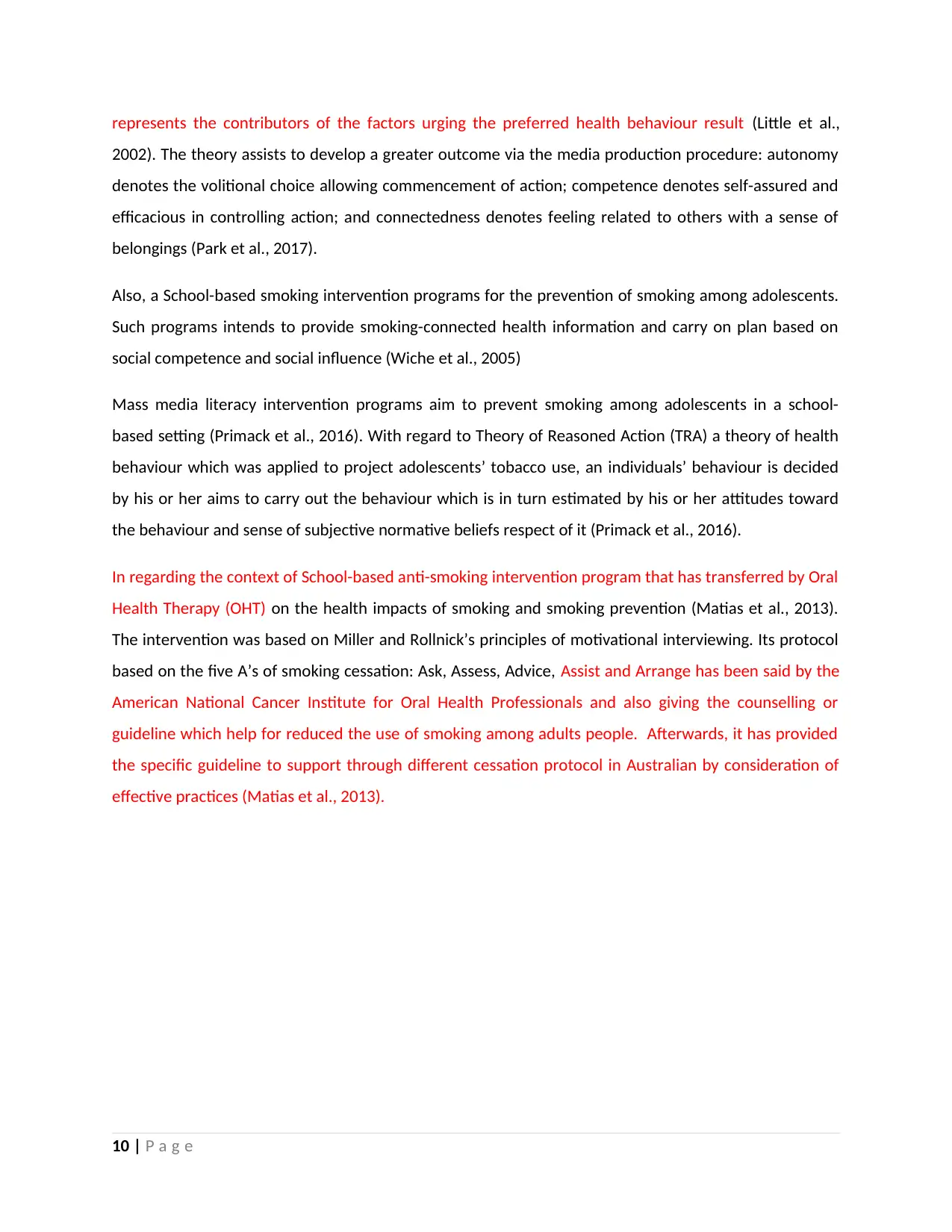
represents the contributors of the factors urging the preferred health behaviour result (Little et al.,
2002). The theory assists to develop a greater outcome via the media production procedure: autonomy
denotes the volitional choice allowing commencement of action; competence denotes self-assured and
efficacious in controlling action; and connectedness denotes feeling related to others with a sense of
belongings (Park et al., 2017).
Also, a School-based smoking intervention programs for the prevention of smoking among adolescents.
Such programs intends to provide smoking-connected health information and carry on plan based on
social competence and social influence (Wiche et al., 2005)
Mass media literacy intervention programs aim to prevent smoking among adolescents in a school-
based setting (Primack et al., 2016). With regard to Theory of Reasoned Action (TRA) a theory of health
behaviour which was applied to project adolescents’ tobacco use, an individuals’ behaviour is decided
by his or her aims to carry out the behaviour which is in turn estimated by his or her attitudes toward
the behaviour and sense of subjective normative beliefs respect of it (Primack et al., 2016).
In regarding the context of School-based anti-smoking intervention program that has transferred by Oral
Health Therapy (OHT) on the health impacts of smoking and smoking prevention (Matias et al., 2013).
The intervention was based on Miller and Rollnick’s principles of motivational interviewing. Its protocol
based on the five A’s of smoking cessation: Ask, Assess, Advice, Assist and Arrange has been said by the
American National Cancer Institute for Oral Health Professionals and also giving the counselling or
guideline which help for reduced the use of smoking among adults people. Afterwards, it has provided
the specific guideline to support through different cessation protocol in Australian by consideration of
effective practices (Matias et al., 2013).
10 | P a g e
2002). The theory assists to develop a greater outcome via the media production procedure: autonomy
denotes the volitional choice allowing commencement of action; competence denotes self-assured and
efficacious in controlling action; and connectedness denotes feeling related to others with a sense of
belongings (Park et al., 2017).
Also, a School-based smoking intervention programs for the prevention of smoking among adolescents.
Such programs intends to provide smoking-connected health information and carry on plan based on
social competence and social influence (Wiche et al., 2005)
Mass media literacy intervention programs aim to prevent smoking among adolescents in a school-
based setting (Primack et al., 2016). With regard to Theory of Reasoned Action (TRA) a theory of health
behaviour which was applied to project adolescents’ tobacco use, an individuals’ behaviour is decided
by his or her aims to carry out the behaviour which is in turn estimated by his or her attitudes toward
the behaviour and sense of subjective normative beliefs respect of it (Primack et al., 2016).
In regarding the context of School-based anti-smoking intervention program that has transferred by Oral
Health Therapy (OHT) on the health impacts of smoking and smoking prevention (Matias et al., 2013).
The intervention was based on Miller and Rollnick’s principles of motivational interviewing. Its protocol
based on the five A’s of smoking cessation: Ask, Assess, Advice, Assist and Arrange has been said by the
American National Cancer Institute for Oral Health Professionals and also giving the counselling or
guideline which help for reduced the use of smoking among adults people. Afterwards, it has provided
the specific guideline to support through different cessation protocol in Australian by consideration of
effective practices (Matias et al., 2013).
10 | P a g e
Paraphrase This Document
Need a fresh take? Get an instant paraphrase of this document with our AI Paraphraser
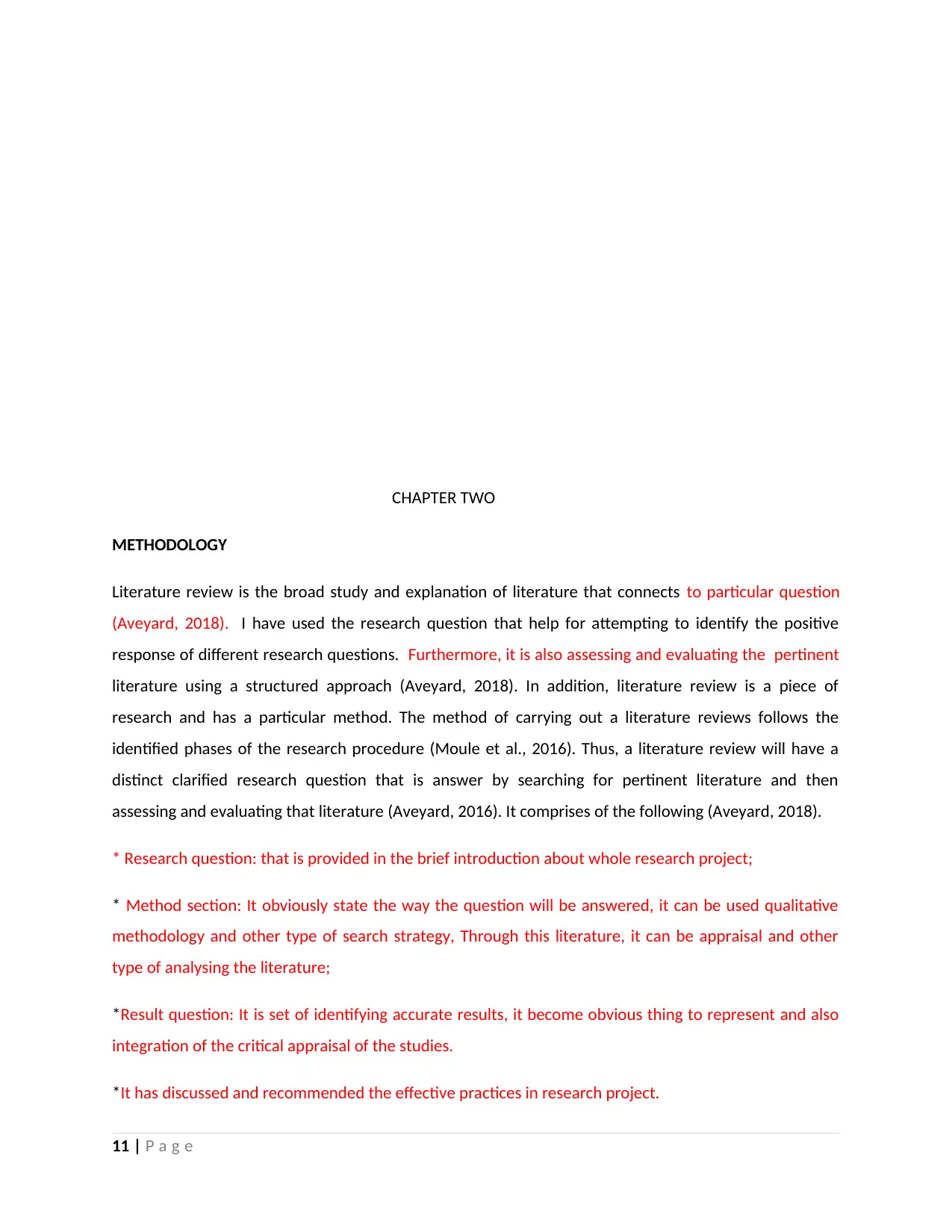
CHAPTER TWO
METHODOLOGY
Literature review is the broad study and explanation of literature that connects to particular question
(Aveyard, 2018). I have used the research question that help for attempting to identify the positive
response of different research questions. Furthermore, it is also assessing and evaluating the pertinent
literature using a structured approach (Aveyard, 2018). In addition, literature review is a piece of
research and has a particular method. The method of carrying out a literature reviews follows the
identified phases of the research procedure (Moule et al., 2016). Thus, a literature review will have a
distinct clarified research question that is answer by searching for pertinent literature and then
assessing and evaluating that literature (Aveyard, 2016). It comprises of the following (Aveyard, 2018).
* Research question: that is provided in the brief introduction about whole research project;
* Method section: It obviously state the way the question will be answered, it can be used qualitative
methodology and other type of search strategy, Through this literature, it can be appraisal and other
type of analysing the literature;
*Result question: It is set of identifying accurate results, it become obvious thing to represent and also
integration of the critical appraisal of the studies.
*It has discussed and recommended the effective practices in research project.
11 | P a g e
METHODOLOGY
Literature review is the broad study and explanation of literature that connects to particular question
(Aveyard, 2018). I have used the research question that help for attempting to identify the positive
response of different research questions. Furthermore, it is also assessing and evaluating the pertinent
literature using a structured approach (Aveyard, 2018). In addition, literature review is a piece of
research and has a particular method. The method of carrying out a literature reviews follows the
identified phases of the research procedure (Moule et al., 2016). Thus, a literature review will have a
distinct clarified research question that is answer by searching for pertinent literature and then
assessing and evaluating that literature (Aveyard, 2016). It comprises of the following (Aveyard, 2018).
* Research question: that is provided in the brief introduction about whole research project;
* Method section: It obviously state the way the question will be answered, it can be used qualitative
methodology and other type of search strategy, Through this literature, it can be appraisal and other
type of analysing the literature;
*Result question: It is set of identifying accurate results, it become obvious thing to represent and also
integration of the critical appraisal of the studies.
*It has discussed and recommended the effective practices in research project.
11 | P a g e
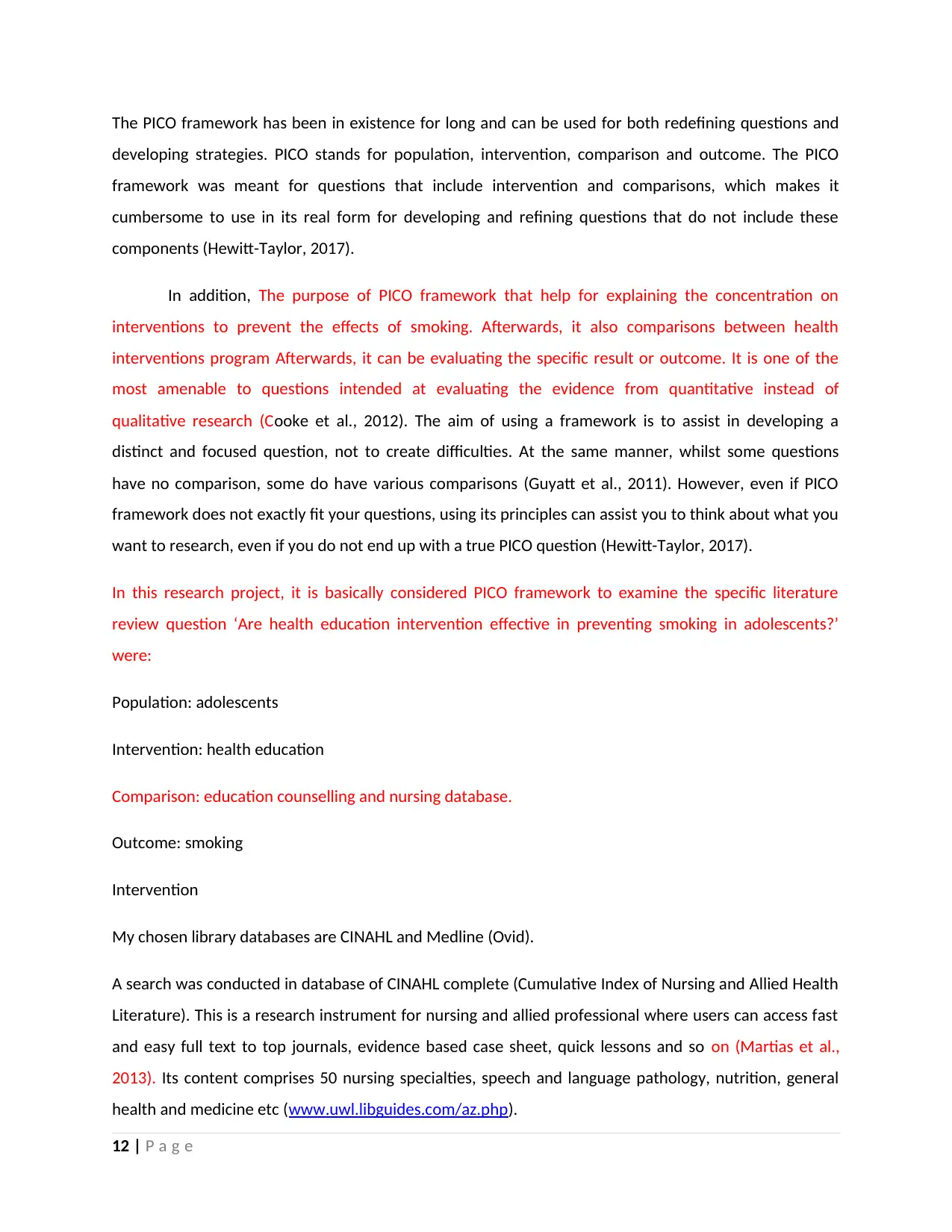
The PICO framework has been in existence for long and can be used for both redefining questions and
developing strategies. PICO stands for population, intervention, comparison and outcome. The PICO
framework was meant for questions that include intervention and comparisons, which makes it
cumbersome to use in its real form for developing and refining questions that do not include these
components (Hewitt-Taylor, 2017).
In addition, The purpose of PICO framework that help for explaining the concentration on
interventions to prevent the effects of smoking. Afterwards, it also comparisons between health
interventions program Afterwards, it can be evaluating the specific result or outcome. It is one of the
most amenable to questions intended at evaluating the evidence from quantitative instead of
qualitative research (Cooke et al., 2012). The aim of using a framework is to assist in developing a
distinct and focused question, not to create difficulties. At the same manner, whilst some questions
have no comparison, some do have various comparisons (Guyatt et al., 2011). However, even if PICO
framework does not exactly fit your questions, using its principles can assist you to think about what you
want to research, even if you do not end up with a true PICO question (Hewitt-Taylor, 2017).
In this research project, it is basically considered PICO framework to examine the specific literature
review question ‘Are health education intervention effective in preventing smoking in adolescents?’
were:
Population: adolescents
Intervention: health education
Comparison: education counselling and nursing database.
Outcome: smoking
Intervention
My chosen library databases are CINAHL and Medline (Ovid).
A search was conducted in database of CINAHL complete (Cumulative Index of Nursing and Allied Health
Literature). This is a research instrument for nursing and allied professional where users can access fast
and easy full text to top journals, evidence based case sheet, quick lessons and so on (Martias et al.,
2013). Its content comprises 50 nursing specialties, speech and language pathology, nutrition, general
health and medicine etc (www.uwl.libguides.com/az.php).
12 | P a g e
developing strategies. PICO stands for population, intervention, comparison and outcome. The PICO
framework was meant for questions that include intervention and comparisons, which makes it
cumbersome to use in its real form for developing and refining questions that do not include these
components (Hewitt-Taylor, 2017).
In addition, The purpose of PICO framework that help for explaining the concentration on
interventions to prevent the effects of smoking. Afterwards, it also comparisons between health
interventions program Afterwards, it can be evaluating the specific result or outcome. It is one of the
most amenable to questions intended at evaluating the evidence from quantitative instead of
qualitative research (Cooke et al., 2012). The aim of using a framework is to assist in developing a
distinct and focused question, not to create difficulties. At the same manner, whilst some questions
have no comparison, some do have various comparisons (Guyatt et al., 2011). However, even if PICO
framework does not exactly fit your questions, using its principles can assist you to think about what you
want to research, even if you do not end up with a true PICO question (Hewitt-Taylor, 2017).
In this research project, it is basically considered PICO framework to examine the specific literature
review question ‘Are health education intervention effective in preventing smoking in adolescents?’
were:
Population: adolescents
Intervention: health education
Comparison: education counselling and nursing database.
Outcome: smoking
Intervention
My chosen library databases are CINAHL and Medline (Ovid).
A search was conducted in database of CINAHL complete (Cumulative Index of Nursing and Allied Health
Literature). This is a research instrument for nursing and allied professional where users can access fast
and easy full text to top journals, evidence based case sheet, quick lessons and so on (Martias et al.,
2013). Its content comprises 50 nursing specialties, speech and language pathology, nutrition, general
health and medicine etc (www.uwl.libguides.com/az.php).
12 | P a g e
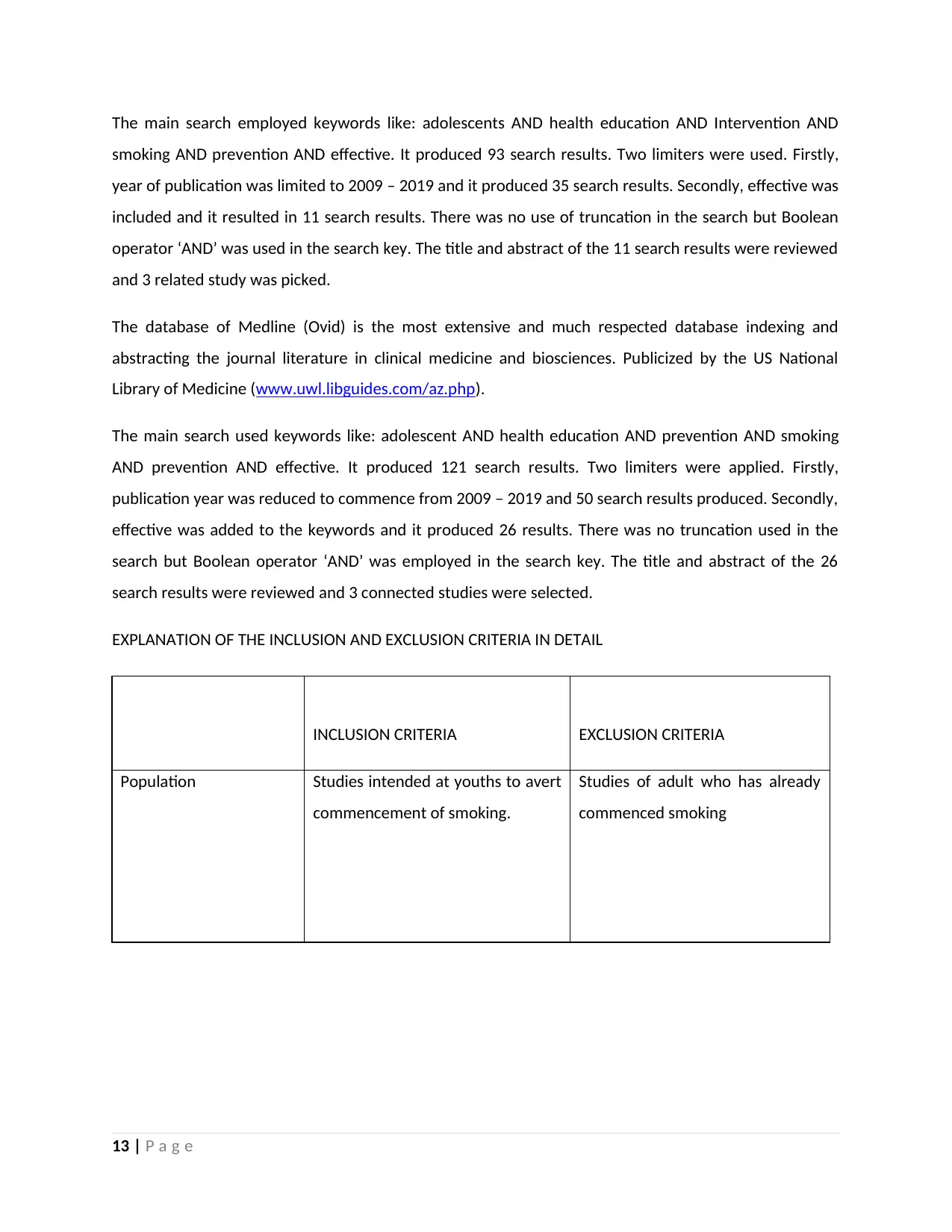
The main search employed keywords like: adolescents AND health education AND Intervention AND
smoking AND prevention AND effective. It produced 93 search results. Two limiters were used. Firstly,
year of publication was limited to 2009 – 2019 and it produced 35 search results. Secondly, effective was
included and it resulted in 11 search results. There was no use of truncation in the search but Boolean
operator ‘AND’ was used in the search key. The title and abstract of the 11 search results were reviewed
and 3 related study was picked.
The database of Medline (Ovid) is the most extensive and much respected database indexing and
abstracting the journal literature in clinical medicine and biosciences. Publicized by the US National
Library of Medicine (www.uwl.libguides.com/az.php).
The main search used keywords like: adolescent AND health education AND prevention AND smoking
AND prevention AND effective. It produced 121 search results. Two limiters were applied. Firstly,
publication year was reduced to commence from 2009 – 2019 and 50 search results produced. Secondly,
effective was added to the keywords and it produced 26 results. There was no truncation used in the
search but Boolean operator ‘AND’ was employed in the search key. The title and abstract of the 26
search results were reviewed and 3 connected studies were selected.
EXPLANATION OF THE INCLUSION AND EXCLUSION CRITERIA IN DETAIL
INCLUSION CRITERIA EXCLUSION CRITERIA
Population Studies intended at youths to avert
commencement of smoking.
Studies of adult who has already
commenced smoking
13 | P a g e
smoking AND prevention AND effective. It produced 93 search results. Two limiters were used. Firstly,
year of publication was limited to 2009 – 2019 and it produced 35 search results. Secondly, effective was
included and it resulted in 11 search results. There was no use of truncation in the search but Boolean
operator ‘AND’ was used in the search key. The title and abstract of the 11 search results were reviewed
and 3 related study was picked.
The database of Medline (Ovid) is the most extensive and much respected database indexing and
abstracting the journal literature in clinical medicine and biosciences. Publicized by the US National
Library of Medicine (www.uwl.libguides.com/az.php).
The main search used keywords like: adolescent AND health education AND prevention AND smoking
AND prevention AND effective. It produced 121 search results. Two limiters were applied. Firstly,
publication year was reduced to commence from 2009 – 2019 and 50 search results produced. Secondly,
effective was added to the keywords and it produced 26 results. There was no truncation used in the
search but Boolean operator ‘AND’ was employed in the search key. The title and abstract of the 26
search results were reviewed and 3 connected studies were selected.
EXPLANATION OF THE INCLUSION AND EXCLUSION CRITERIA IN DETAIL
INCLUSION CRITERIA EXCLUSION CRITERIA
Population Studies intended at youths to avert
commencement of smoking.
Studies of adult who has already
commenced smoking
13 | P a g e
Secure Best Marks with AI Grader
Need help grading? Try our AI Grader for instant feedback on your assignments.
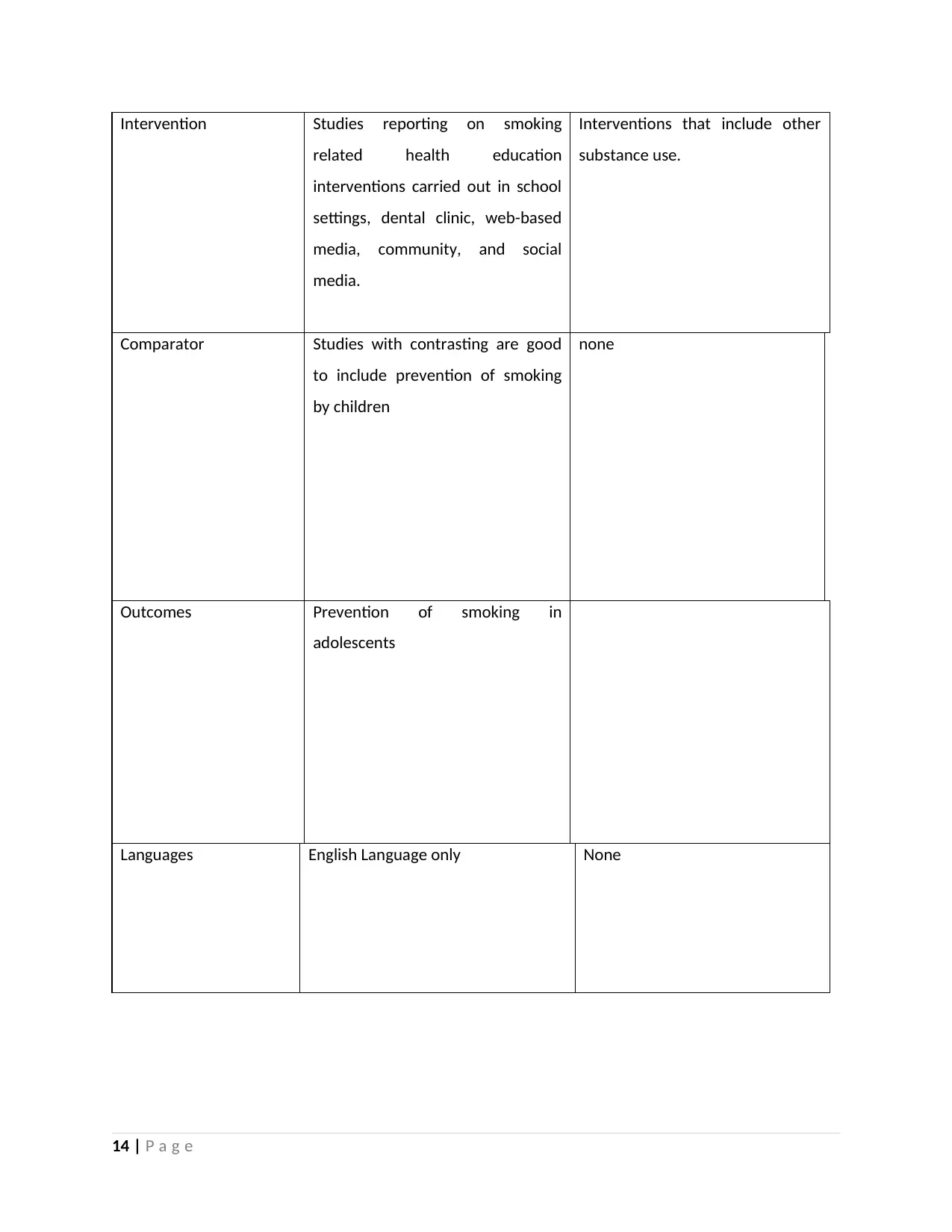
Intervention Studies reporting on smoking
related health education
interventions carried out in school
settings, dental clinic, web-based
media, community, and social
media.
Interventions that include other
substance use.
Comparator Studies with contrasting are good
to include prevention of smoking
by children
none
Outcomes Prevention of smoking in
adolescents
Languages English Language only None
14 | P a g e
related health education
interventions carried out in school
settings, dental clinic, web-based
media, community, and social
media.
Interventions that include other
substance use.
Comparator Studies with contrasting are good
to include prevention of smoking
by children
none
Outcomes Prevention of smoking in
adolescents
Languages English Language only None
14 | P a g e
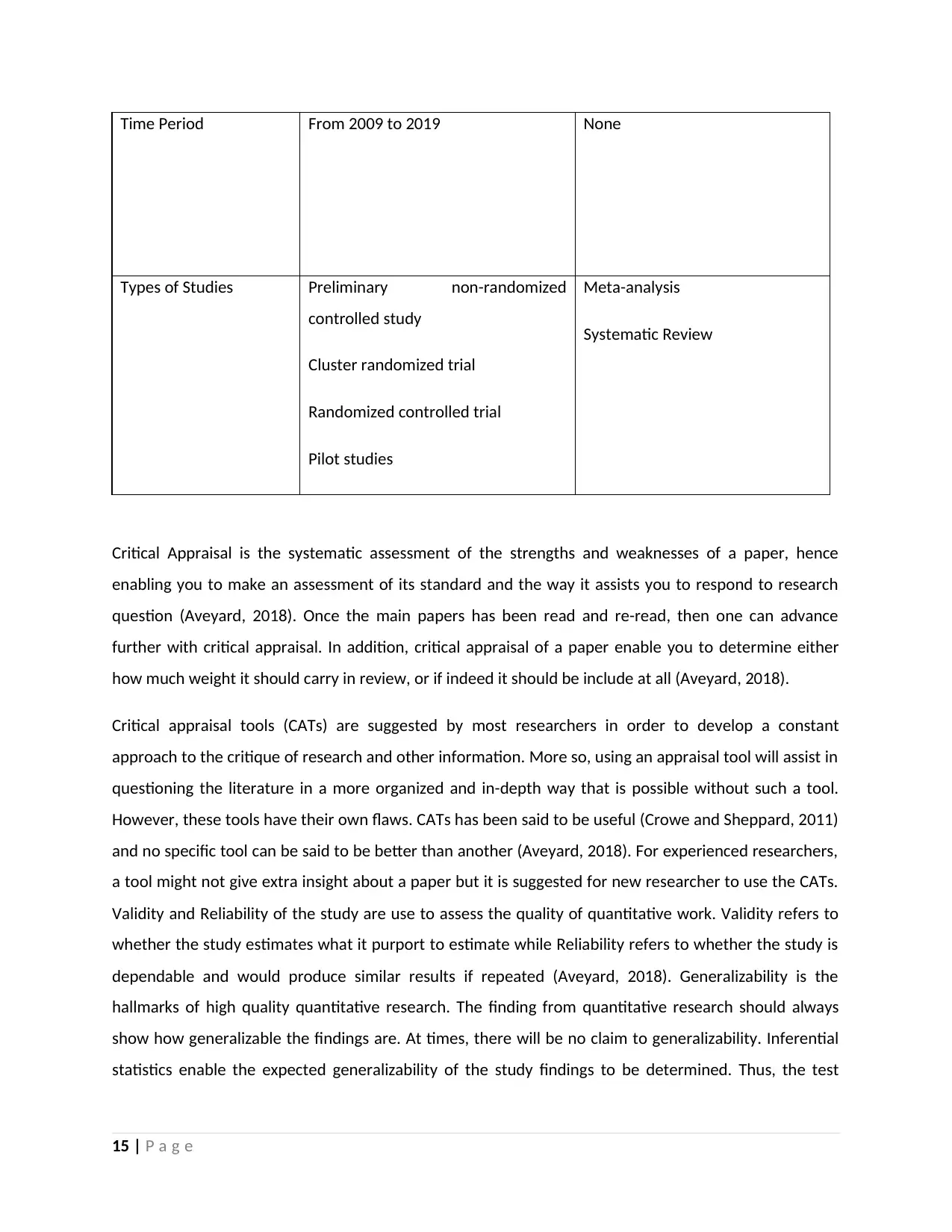
Time Period From 2009 to 2019 None
Types of Studies Preliminary non-randomized
controlled study
Cluster randomized trial
Randomized controlled trial
Pilot studies
Meta-analysis
Systematic Review
Critical Appraisal is the systematic assessment of the strengths and weaknesses of a paper, hence
enabling you to make an assessment of its standard and the way it assists you to respond to research
question (Aveyard, 2018). Once the main papers has been read and re-read, then one can advance
further with critical appraisal. In addition, critical appraisal of a paper enable you to determine either
how much weight it should carry in review, or if indeed it should be include at all (Aveyard, 2018).
Critical appraisal tools (CATs) are suggested by most researchers in order to develop a constant
approach to the critique of research and other information. More so, using an appraisal tool will assist in
questioning the literature in a more organized and in-depth way that is possible without such a tool.
However, these tools have their own flaws. CATs has been said to be useful (Crowe and Sheppard, 2011)
and no specific tool can be said to be better than another (Aveyard, 2018). For experienced researchers,
a tool might not give extra insight about a paper but it is suggested for new researcher to use the CATs.
Validity and Reliability of the study are use to assess the quality of quantitative work. Validity refers to
whether the study estimates what it purport to estimate while Reliability refers to whether the study is
dependable and would produce similar results if repeated (Aveyard, 2018). Generalizability is the
hallmarks of high quality quantitative research. The finding from quantitative research should always
show how generalizable the findings are. At times, there will be no claim to generalizability. Inferential
statistics enable the expected generalizability of the study findings to be determined. Thus, the test
15 | P a g e
Types of Studies Preliminary non-randomized
controlled study
Cluster randomized trial
Randomized controlled trial
Pilot studies
Meta-analysis
Systematic Review
Critical Appraisal is the systematic assessment of the strengths and weaknesses of a paper, hence
enabling you to make an assessment of its standard and the way it assists you to respond to research
question (Aveyard, 2018). Once the main papers has been read and re-read, then one can advance
further with critical appraisal. In addition, critical appraisal of a paper enable you to determine either
how much weight it should carry in review, or if indeed it should be include at all (Aveyard, 2018).
Critical appraisal tools (CATs) are suggested by most researchers in order to develop a constant
approach to the critique of research and other information. More so, using an appraisal tool will assist in
questioning the literature in a more organized and in-depth way that is possible without such a tool.
However, these tools have their own flaws. CATs has been said to be useful (Crowe and Sheppard, 2011)
and no specific tool can be said to be better than another (Aveyard, 2018). For experienced researchers,
a tool might not give extra insight about a paper but it is suggested for new researcher to use the CATs.
Validity and Reliability of the study are use to assess the quality of quantitative work. Validity refers to
whether the study estimates what it purport to estimate while Reliability refers to whether the study is
dependable and would produce similar results if repeated (Aveyard, 2018). Generalizability is the
hallmarks of high quality quantitative research. The finding from quantitative research should always
show how generalizable the findings are. At times, there will be no claim to generalizability. Inferential
statistics enable the expected generalizability of the study findings to be determined. Thus, the test
15 | P a g e
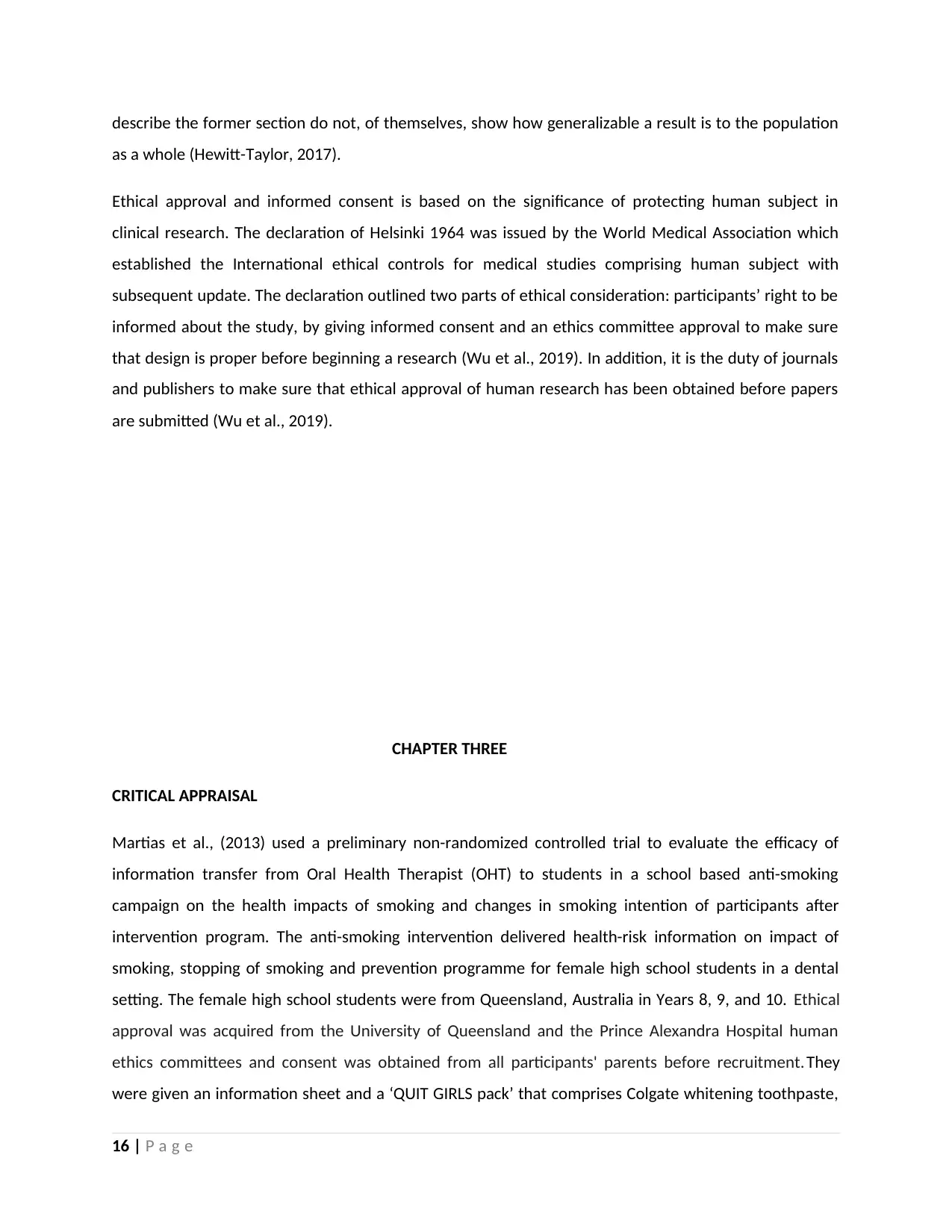
describe the former section do not, of themselves, show how generalizable a result is to the population
as a whole (Hewitt-Taylor, 2017).
Ethical approval and informed consent is based on the significance of protecting human subject in
clinical research. The declaration of Helsinki 1964 was issued by the World Medical Association which
established the International ethical controls for medical studies comprising human subject with
subsequent update. The declaration outlined two parts of ethical consideration: participants’ right to be
informed about the study, by giving informed consent and an ethics committee approval to make sure
that design is proper before beginning a research (Wu et al., 2019). In addition, it is the duty of journals
and publishers to make sure that ethical approval of human research has been obtained before papers
are submitted (Wu et al., 2019).
CHAPTER THREE
CRITICAL APPRAISAL
Martias et al., (2013) used a preliminary non-randomized controlled trial to evaluate the efficacy of
information transfer from Oral Health Therapist (OHT) to students in a school based anti-smoking
campaign on the health impacts of smoking and changes in smoking intention of participants after
intervention program. The anti-smoking intervention delivered health-risk information on impact of
smoking, stopping of smoking and prevention programme for female high school students in a dental
setting. The female high school students were from Queensland, Australia in Years 8, 9, and 10. Ethical
approval was acquired from the University of Queensland and the Prince Alexandra Hospital human
ethics committees and consent was obtained from all participants' parents before recruitment. They
were given an information sheet and a ‘QUIT GIRLS pack’ that comprises Colgate whitening toothpaste,
16 | P a g e
as a whole (Hewitt-Taylor, 2017).
Ethical approval and informed consent is based on the significance of protecting human subject in
clinical research. The declaration of Helsinki 1964 was issued by the World Medical Association which
established the International ethical controls for medical studies comprising human subject with
subsequent update. The declaration outlined two parts of ethical consideration: participants’ right to be
informed about the study, by giving informed consent and an ethics committee approval to make sure
that design is proper before beginning a research (Wu et al., 2019). In addition, it is the duty of journals
and publishers to make sure that ethical approval of human research has been obtained before papers
are submitted (Wu et al., 2019).
CHAPTER THREE
CRITICAL APPRAISAL
Martias et al., (2013) used a preliminary non-randomized controlled trial to evaluate the efficacy of
information transfer from Oral Health Therapist (OHT) to students in a school based anti-smoking
campaign on the health impacts of smoking and changes in smoking intention of participants after
intervention program. The anti-smoking intervention delivered health-risk information on impact of
smoking, stopping of smoking and prevention programme for female high school students in a dental
setting. The female high school students were from Queensland, Australia in Years 8, 9, and 10. Ethical
approval was acquired from the University of Queensland and the Prince Alexandra Hospital human
ethics committees and consent was obtained from all participants' parents before recruitment. They
were given an information sheet and a ‘QUIT GIRLS pack’ that comprises Colgate whitening toothpaste,
16 | P a g e
Paraphrase This Document
Need a fresh take? Get an instant paraphrase of this document with our AI Paraphraser
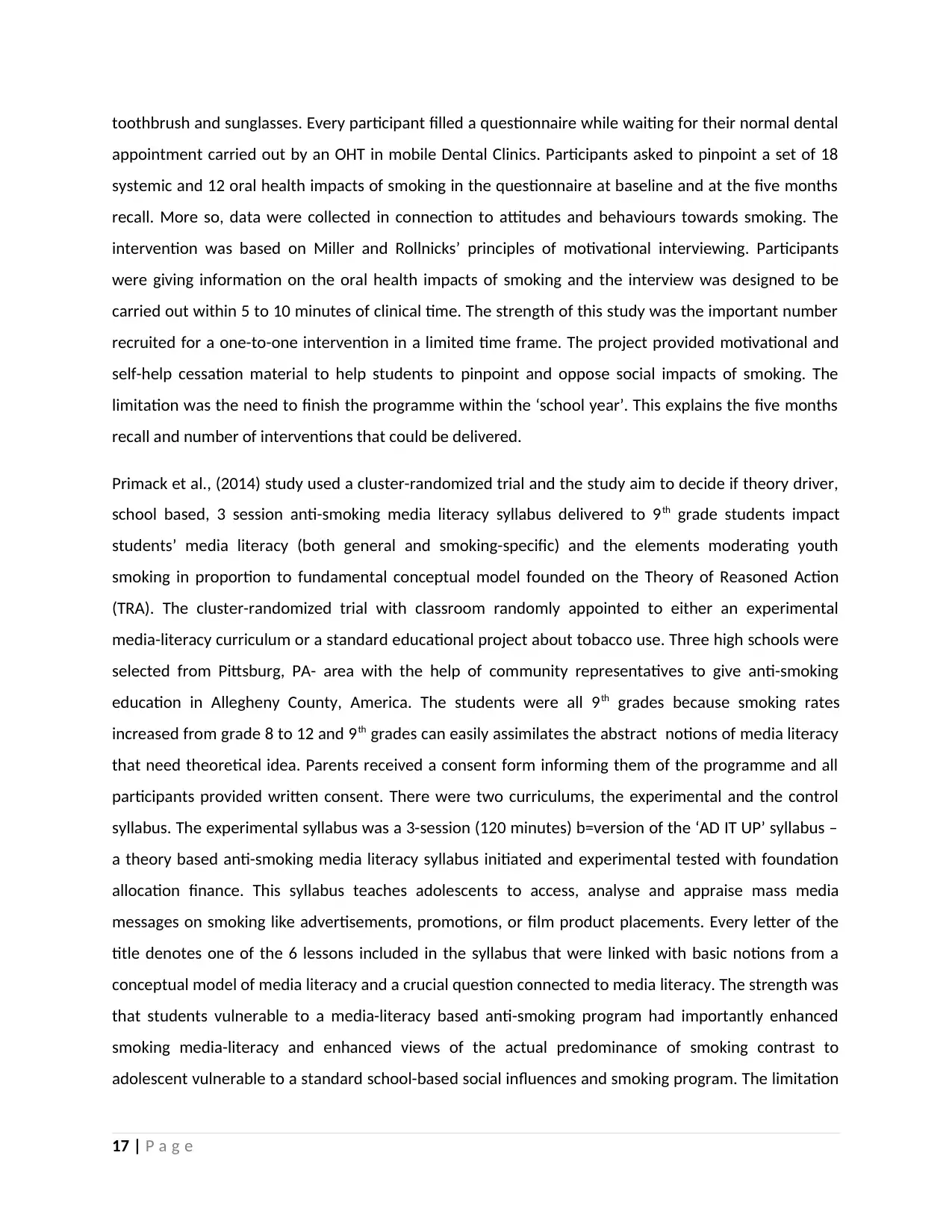
toothbrush and sunglasses. Every participant filled a questionnaire while waiting for their normal dental
appointment carried out by an OHT in mobile Dental Clinics. Participants asked to pinpoint a set of 18
systemic and 12 oral health impacts of smoking in the questionnaire at baseline and at the five months
recall. More so, data were collected in connection to attitudes and behaviours towards smoking. The
intervention was based on Miller and Rollnicks’ principles of motivational interviewing. Participants
were giving information on the oral health impacts of smoking and the interview was designed to be
carried out within 5 to 10 minutes of clinical time. The strength of this study was the important number
recruited for a one-to-one intervention in a limited time frame. The project provided motivational and
self-help cessation material to help students to pinpoint and oppose social impacts of smoking. The
limitation was the need to finish the programme within the ‘school year’. This explains the five months
recall and number of interventions that could be delivered.
Primack et al., (2014) study used a cluster-randomized trial and the study aim to decide if theory driver,
school based, 3 session anti-smoking media literacy syllabus delivered to 9th grade students impact
students’ media literacy (both general and smoking-specific) and the elements moderating youth
smoking in proportion to fundamental conceptual model founded on the Theory of Reasoned Action
(TRA). The cluster-randomized trial with classroom randomly appointed to either an experimental
media-literacy curriculum or a standard educational project about tobacco use. Three high schools were
selected from Pittsburg, PA- area with the help of community representatives to give anti-smoking
education in Allegheny County, America. The students were all 9th grades because smoking rates
increased from grade 8 to 12 and 9th grades can easily assimilates the abstract notions of media literacy
that need theoretical idea. Parents received a consent form informing them of the programme and all
participants provided written consent. There were two curriculums, the experimental and the control
syllabus. The experimental syllabus was a 3-session (120 minutes) b=version of the ‘AD IT UP’ syllabus –
a theory based anti-smoking media literacy syllabus initiated and experimental tested with foundation
allocation finance. This syllabus teaches adolescents to access, analyse and appraise mass media
messages on smoking like advertisements, promotions, or film product placements. Every letter of the
title denotes one of the 6 lessons included in the syllabus that were linked with basic notions from a
conceptual model of media literacy and a crucial question connected to media literacy. The strength was
that students vulnerable to a media-literacy based anti-smoking program had importantly enhanced
smoking media-literacy and enhanced views of the actual predominance of smoking contrast to
adolescent vulnerable to a standard school-based social influences and smoking program. The limitation
17 | P a g e
appointment carried out by an OHT in mobile Dental Clinics. Participants asked to pinpoint a set of 18
systemic and 12 oral health impacts of smoking in the questionnaire at baseline and at the five months
recall. More so, data were collected in connection to attitudes and behaviours towards smoking. The
intervention was based on Miller and Rollnicks’ principles of motivational interviewing. Participants
were giving information on the oral health impacts of smoking and the interview was designed to be
carried out within 5 to 10 minutes of clinical time. The strength of this study was the important number
recruited for a one-to-one intervention in a limited time frame. The project provided motivational and
self-help cessation material to help students to pinpoint and oppose social impacts of smoking. The
limitation was the need to finish the programme within the ‘school year’. This explains the five months
recall and number of interventions that could be delivered.
Primack et al., (2014) study used a cluster-randomized trial and the study aim to decide if theory driver,
school based, 3 session anti-smoking media literacy syllabus delivered to 9th grade students impact
students’ media literacy (both general and smoking-specific) and the elements moderating youth
smoking in proportion to fundamental conceptual model founded on the Theory of Reasoned Action
(TRA). The cluster-randomized trial with classroom randomly appointed to either an experimental
media-literacy curriculum or a standard educational project about tobacco use. Three high schools were
selected from Pittsburg, PA- area with the help of community representatives to give anti-smoking
education in Allegheny County, America. The students were all 9th grades because smoking rates
increased from grade 8 to 12 and 9th grades can easily assimilates the abstract notions of media literacy
that need theoretical idea. Parents received a consent form informing them of the programme and all
participants provided written consent. There were two curriculums, the experimental and the control
syllabus. The experimental syllabus was a 3-session (120 minutes) b=version of the ‘AD IT UP’ syllabus –
a theory based anti-smoking media literacy syllabus initiated and experimental tested with foundation
allocation finance. This syllabus teaches adolescents to access, analyse and appraise mass media
messages on smoking like advertisements, promotions, or film product placements. Every letter of the
title denotes one of the 6 lessons included in the syllabus that were linked with basic notions from a
conceptual model of media literacy and a crucial question connected to media literacy. The strength was
that students vulnerable to a media-literacy based anti-smoking program had importantly enhanced
smoking media-literacy and enhanced views of the actual predominance of smoking contrast to
adolescent vulnerable to a standard school-based social influences and smoking program. The limitation
17 | P a g e
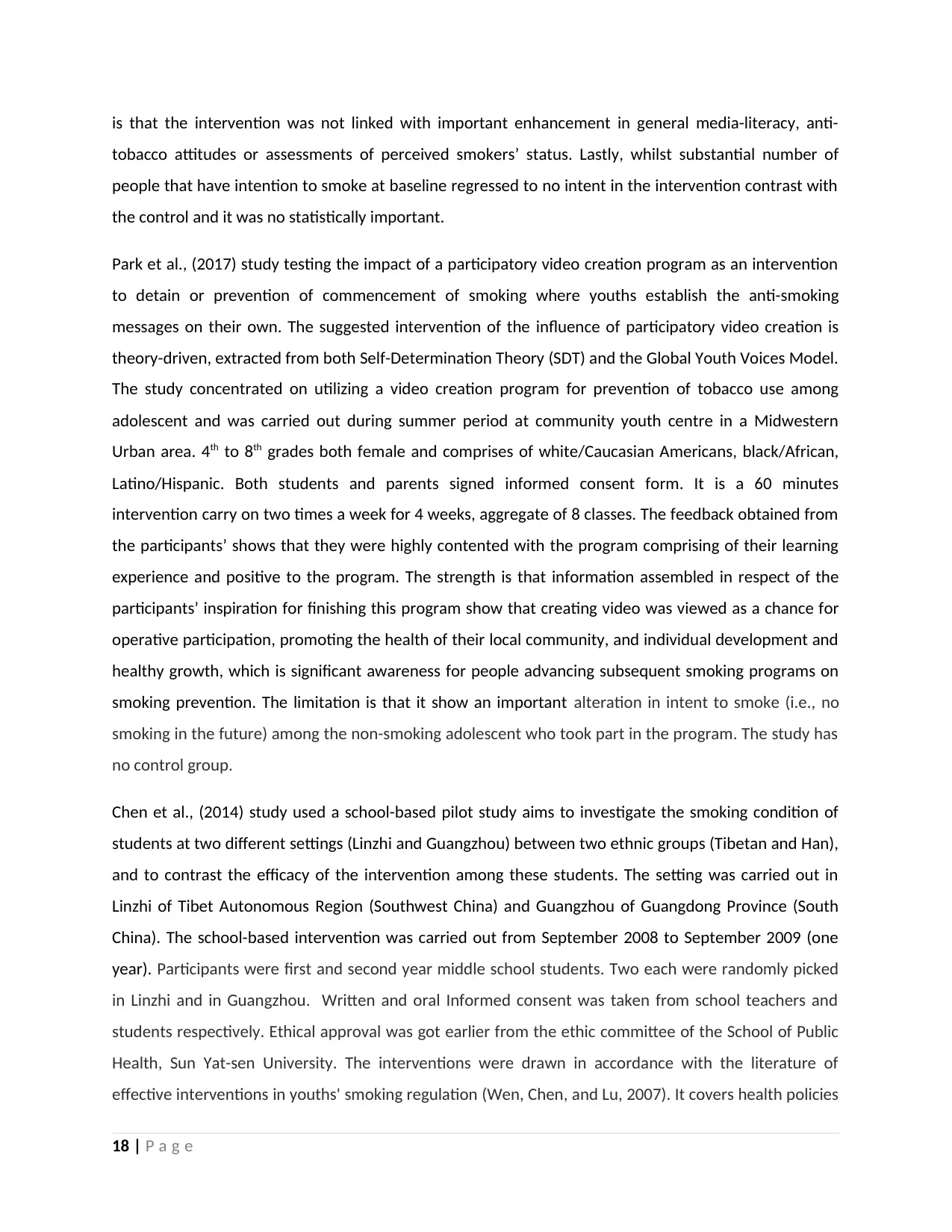
is that the intervention was not linked with important enhancement in general media-literacy, anti-
tobacco attitudes or assessments of perceived smokers’ status. Lastly, whilst substantial number of
people that have intention to smoke at baseline regressed to no intent in the intervention contrast with
the control and it was no statistically important.
Park et al., (2017) study testing the impact of a participatory video creation program as an intervention
to detain or prevention of commencement of smoking where youths establish the anti-smoking
messages on their own. The suggested intervention of the influence of participatory video creation is
theory-driven, extracted from both Self-Determination Theory (SDT) and the Global Youth Voices Model.
The study concentrated on utilizing a video creation program for prevention of tobacco use among
adolescent and was carried out during summer period at community youth centre in a Midwestern
Urban area. 4th to 8th grades both female and comprises of white/Caucasian Americans, black/African,
Latino/Hispanic. Both students and parents signed informed consent form. It is a 60 minutes
intervention carry on two times a week for 4 weeks, aggregate of 8 classes. The feedback obtained from
the participants’ shows that they were highly contented with the program comprising of their learning
experience and positive to the program. The strength is that information assembled in respect of the
participants’ inspiration for finishing this program show that creating video was viewed as a chance for
operative participation, promoting the health of their local community, and individual development and
healthy growth, which is significant awareness for people advancing subsequent smoking programs on
smoking prevention. The limitation is that it show an important alteration in intent to smoke (i.e., no
smoking in the future) among the non-smoking adolescent who took part in the program. The study has
no control group.
Chen et al., (2014) study used a school-based pilot study aims to investigate the smoking condition of
students at two different settings (Linzhi and Guangzhou) between two ethnic groups (Tibetan and Han),
and to contrast the efficacy of the intervention among these students. The setting was carried out in
Linzhi of Tibet Autonomous Region (Southwest China) and Guangzhou of Guangdong Province (South
China). The school-based intervention was carried out from September 2008 to September 2009 (one
year). Participants were first and second year middle school students. Two each were randomly picked
in Linzhi and in Guangzhou. Written and oral Informed consent was taken from school teachers and
students respectively. Ethical approval was got earlier from the ethic committee of the School of Public
Health, Sun Yat-sen University. The interventions were drawn in accordance with the literature of
effective interventions in youths' smoking regulation (Wen, Chen, and Lu, 2007). It covers health policies
18 | P a g e
tobacco attitudes or assessments of perceived smokers’ status. Lastly, whilst substantial number of
people that have intention to smoke at baseline regressed to no intent in the intervention contrast with
the control and it was no statistically important.
Park et al., (2017) study testing the impact of a participatory video creation program as an intervention
to detain or prevention of commencement of smoking where youths establish the anti-smoking
messages on their own. The suggested intervention of the influence of participatory video creation is
theory-driven, extracted from both Self-Determination Theory (SDT) and the Global Youth Voices Model.
The study concentrated on utilizing a video creation program for prevention of tobacco use among
adolescent and was carried out during summer period at community youth centre in a Midwestern
Urban area. 4th to 8th grades both female and comprises of white/Caucasian Americans, black/African,
Latino/Hispanic. Both students and parents signed informed consent form. It is a 60 minutes
intervention carry on two times a week for 4 weeks, aggregate of 8 classes. The feedback obtained from
the participants’ shows that they were highly contented with the program comprising of their learning
experience and positive to the program. The strength is that information assembled in respect of the
participants’ inspiration for finishing this program show that creating video was viewed as a chance for
operative participation, promoting the health of their local community, and individual development and
healthy growth, which is significant awareness for people advancing subsequent smoking programs on
smoking prevention. The limitation is that it show an important alteration in intent to smoke (i.e., no
smoking in the future) among the non-smoking adolescent who took part in the program. The study has
no control group.
Chen et al., (2014) study used a school-based pilot study aims to investigate the smoking condition of
students at two different settings (Linzhi and Guangzhou) between two ethnic groups (Tibetan and Han),
and to contrast the efficacy of the intervention among these students. The setting was carried out in
Linzhi of Tibet Autonomous Region (Southwest China) and Guangzhou of Guangdong Province (South
China). The school-based intervention was carried out from September 2008 to September 2009 (one
year). Participants were first and second year middle school students. Two each were randomly picked
in Linzhi and in Guangzhou. Written and oral Informed consent was taken from school teachers and
students respectively. Ethical approval was got earlier from the ethic committee of the School of Public
Health, Sun Yat-sen University. The interventions were drawn in accordance with the literature of
effective interventions in youths' smoking regulation (Wen, Chen, and Lu, 2007). It covers health policies
18 | P a g e
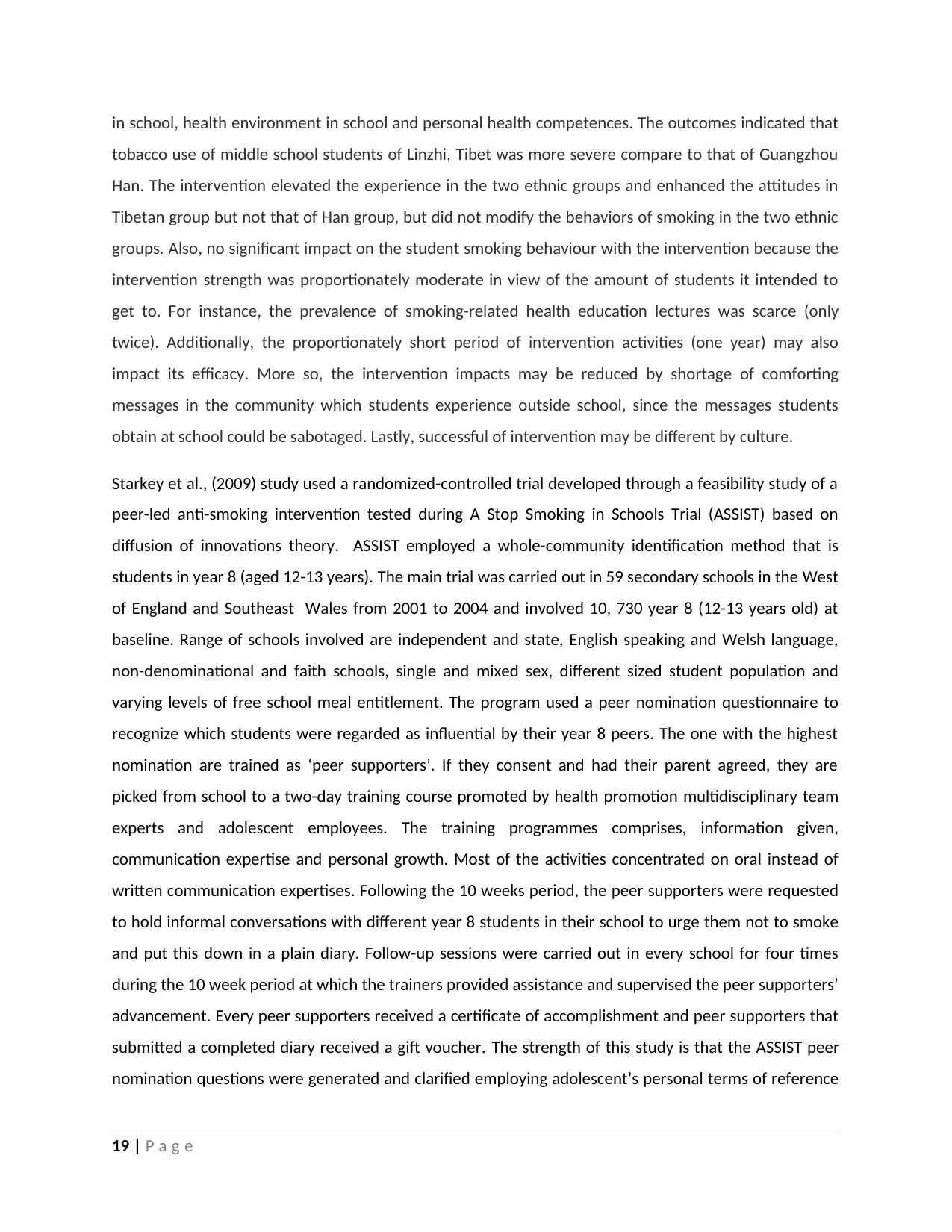
in school, health environment in school and personal health competences. The outcomes indicated that
tobacco use of middle school students of Linzhi, Tibet was more severe compare to that of Guangzhou
Han. The intervention elevated the experience in the two ethnic groups and enhanced the attitudes in
Tibetan group but not that of Han group, but did not modify the behaviors of smoking in the two ethnic
groups. Also, no significant impact on the student smoking behaviour with the intervention because the
intervention strength was proportionately moderate in view of the amount of students it intended to
get to. For instance, the prevalence of smoking-related health education lectures was scarce (only
twice). Additionally, the proportionately short period of intervention activities (one year) may also
impact its efficacy. More so, the intervention impacts may be reduced by shortage of comforting
messages in the community which students experience outside school, since the messages students
obtain at school could be sabotaged. Lastly, successful of intervention may be different by culture.
Starkey et al., (2009) study used a randomized-controlled trial developed through a feasibility study of a
peer-led anti-smoking intervention tested during A Stop Smoking in Schools Trial (ASSIST) based on
diffusion of innovations theory. ASSIST employed a whole-community identification method that is
students in year 8 (aged 12-13 years). The main trial was carried out in 59 secondary schools in the West
of England and Southeast Wales from 2001 to 2004 and involved 10, 730 year 8 (12-13 years old) at
baseline. Range of schools involved are independent and state, English speaking and Welsh language,
non-denominational and faith schools, single and mixed sex, different sized student population and
varying levels of free school meal entitlement. The program used a peer nomination questionnaire to
recognize which students were regarded as influential by their year 8 peers. The one with the highest
nomination are trained as ‘peer supporters’. If they consent and had their parent agreed, they are
picked from school to a two-day training course promoted by health promotion multidisciplinary team
experts and adolescent employees. The training programmes comprises, information given,
communication expertise and personal growth. Most of the activities concentrated on oral instead of
written communication expertises. Following the 10 weeks period, the peer supporters were requested
to hold informal conversations with different year 8 students in their school to urge them not to smoke
and put this down in a plain diary. Follow-up sessions were carried out in every school for four times
during the 10 week period at which the trainers provided assistance and supervised the peer supporters’
advancement. Every peer supporters received a certificate of accomplishment and peer supporters that
submitted a completed diary received a gift voucher. The strength of this study is that the ASSIST peer
nomination questions were generated and clarified employing adolescent’s personal terms of reference
19 | P a g e
tobacco use of middle school students of Linzhi, Tibet was more severe compare to that of Guangzhou
Han. The intervention elevated the experience in the two ethnic groups and enhanced the attitudes in
Tibetan group but not that of Han group, but did not modify the behaviors of smoking in the two ethnic
groups. Also, no significant impact on the student smoking behaviour with the intervention because the
intervention strength was proportionately moderate in view of the amount of students it intended to
get to. For instance, the prevalence of smoking-related health education lectures was scarce (only
twice). Additionally, the proportionately short period of intervention activities (one year) may also
impact its efficacy. More so, the intervention impacts may be reduced by shortage of comforting
messages in the community which students experience outside school, since the messages students
obtain at school could be sabotaged. Lastly, successful of intervention may be different by culture.
Starkey et al., (2009) study used a randomized-controlled trial developed through a feasibility study of a
peer-led anti-smoking intervention tested during A Stop Smoking in Schools Trial (ASSIST) based on
diffusion of innovations theory. ASSIST employed a whole-community identification method that is
students in year 8 (aged 12-13 years). The main trial was carried out in 59 secondary schools in the West
of England and Southeast Wales from 2001 to 2004 and involved 10, 730 year 8 (12-13 years old) at
baseline. Range of schools involved are independent and state, English speaking and Welsh language,
non-denominational and faith schools, single and mixed sex, different sized student population and
varying levels of free school meal entitlement. The program used a peer nomination questionnaire to
recognize which students were regarded as influential by their year 8 peers. The one with the highest
nomination are trained as ‘peer supporters’. If they consent and had their parent agreed, they are
picked from school to a two-day training course promoted by health promotion multidisciplinary team
experts and adolescent employees. The training programmes comprises, information given,
communication expertise and personal growth. Most of the activities concentrated on oral instead of
written communication expertises. Following the 10 weeks period, the peer supporters were requested
to hold informal conversations with different year 8 students in their school to urge them not to smoke
and put this down in a plain diary. Follow-up sessions were carried out in every school for four times
during the 10 week period at which the trainers provided assistance and supervised the peer supporters’
advancement. Every peer supporters received a certificate of accomplishment and peer supporters that
submitted a completed diary received a gift voucher. The strength of this study is that the ASSIST peer
nomination questions were generated and clarified employing adolescent’s personal terms of reference
19 | P a g e
Secure Best Marks with AI Grader
Need help grading? Try our AI Grader for instant feedback on your assignments.
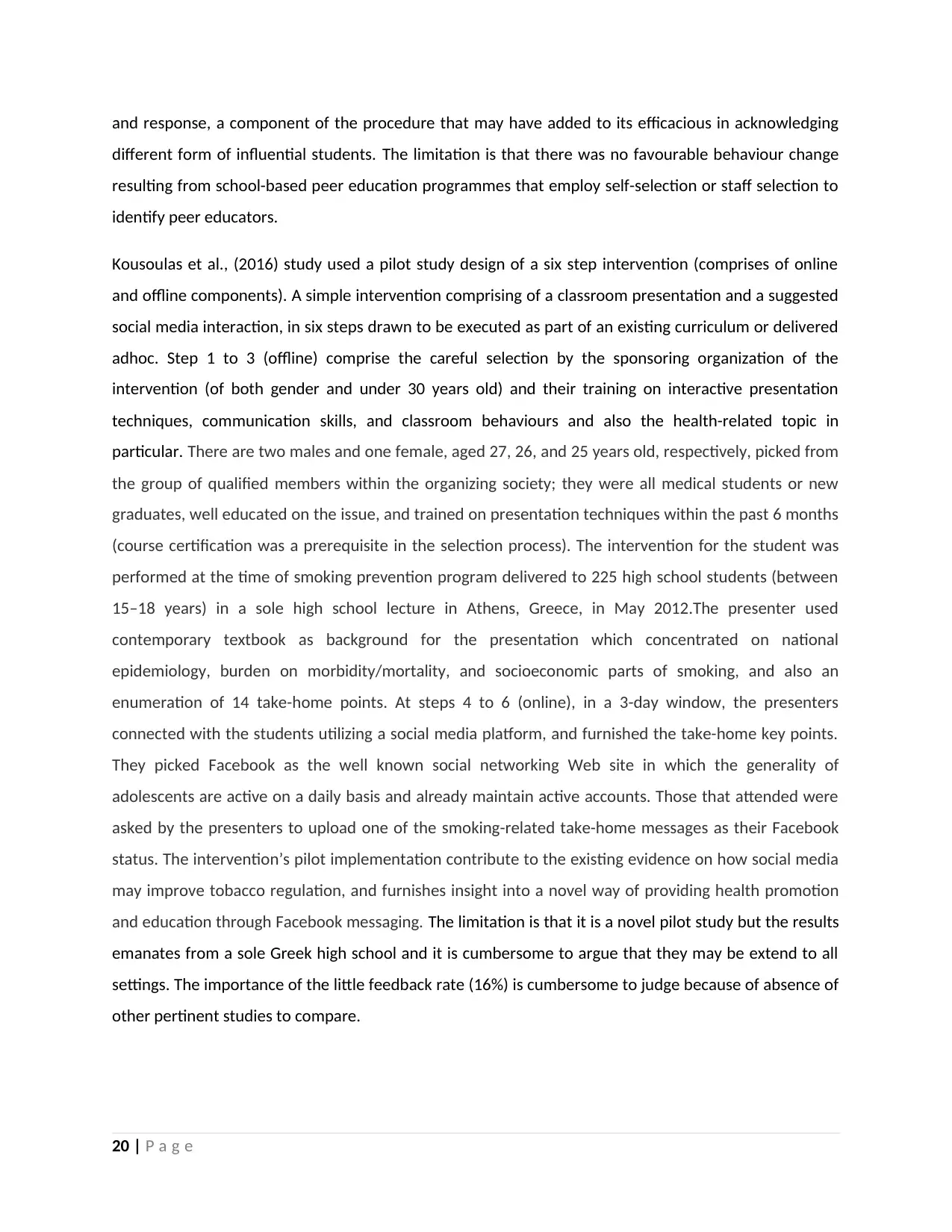
and response, a component of the procedure that may have added to its efficacious in acknowledging
different form of influential students. The limitation is that there was no favourable behaviour change
resulting from school-based peer education programmes that employ self-selection or staff selection to
identify peer educators.
Kousoulas et al., (2016) study used a pilot study design of a six step intervention (comprises of online
and offline components). A simple intervention comprising of a classroom presentation and a suggested
social media interaction, in six steps drawn to be executed as part of an existing curriculum or delivered
adhoc. Step 1 to 3 (offline) comprise the careful selection by the sponsoring organization of the
intervention (of both gender and under 30 years old) and their training on interactive presentation
techniques, communication skills, and classroom behaviours and also the health-related topic in
particular. There are two males and one female, aged 27, 26, and 25 years old, respectively, picked from
the group of qualified members within the organizing society; they were all medical students or new
graduates, well educated on the issue, and trained on presentation techniques within the past 6 months
(course certification was a prerequisite in the selection process). The intervention for the student was
performed at the time of smoking prevention program delivered to 225 high school students (between
15–18 years) in a sole high school lecture in Athens, Greece, in May 2012.The presenter used
contemporary textbook as background for the presentation which concentrated on national
epidemiology, burden on morbidity/mortality, and socioeconomic parts of smoking, and also an
enumeration of 14 take-home points. At steps 4 to 6 (online), in a 3-day window, the presenters
connected with the students utilizing a social media platform, and furnished the take-home key points.
They picked Facebook as the well known social networking Web site in which the generality of
adolescents are active on a daily basis and already maintain active accounts. Those that attended were
asked by the presenters to upload one of the smoking-related take-home messages as their Facebook
status. The intervention’s pilot implementation contribute to the existing evidence on how social media
may improve tobacco regulation, and furnishes insight into a novel way of providing health promotion
and education through Facebook messaging. The limitation is that it is a novel pilot study but the results
emanates from a sole Greek high school and it is cumbersome to argue that they may be extend to all
settings. The importance of the little feedback rate (16%) is cumbersome to judge because of absence of
other pertinent studies to compare.
20 | P a g e
different form of influential students. The limitation is that there was no favourable behaviour change
resulting from school-based peer education programmes that employ self-selection or staff selection to
identify peer educators.
Kousoulas et al., (2016) study used a pilot study design of a six step intervention (comprises of online
and offline components). A simple intervention comprising of a classroom presentation and a suggested
social media interaction, in six steps drawn to be executed as part of an existing curriculum or delivered
adhoc. Step 1 to 3 (offline) comprise the careful selection by the sponsoring organization of the
intervention (of both gender and under 30 years old) and their training on interactive presentation
techniques, communication skills, and classroom behaviours and also the health-related topic in
particular. There are two males and one female, aged 27, 26, and 25 years old, respectively, picked from
the group of qualified members within the organizing society; they were all medical students or new
graduates, well educated on the issue, and trained on presentation techniques within the past 6 months
(course certification was a prerequisite in the selection process). The intervention for the student was
performed at the time of smoking prevention program delivered to 225 high school students (between
15–18 years) in a sole high school lecture in Athens, Greece, in May 2012.The presenter used
contemporary textbook as background for the presentation which concentrated on national
epidemiology, burden on morbidity/mortality, and socioeconomic parts of smoking, and also an
enumeration of 14 take-home points. At steps 4 to 6 (online), in a 3-day window, the presenters
connected with the students utilizing a social media platform, and furnished the take-home key points.
They picked Facebook as the well known social networking Web site in which the generality of
adolescents are active on a daily basis and already maintain active accounts. Those that attended were
asked by the presenters to upload one of the smoking-related take-home messages as their Facebook
status. The intervention’s pilot implementation contribute to the existing evidence on how social media
may improve tobacco regulation, and furnishes insight into a novel way of providing health promotion
and education through Facebook messaging. The limitation is that it is a novel pilot study but the results
emanates from a sole Greek high school and it is cumbersome to argue that they may be extend to all
settings. The importance of the little feedback rate (16%) is cumbersome to judge because of absence of
other pertinent studies to compare.
20 | P a g e
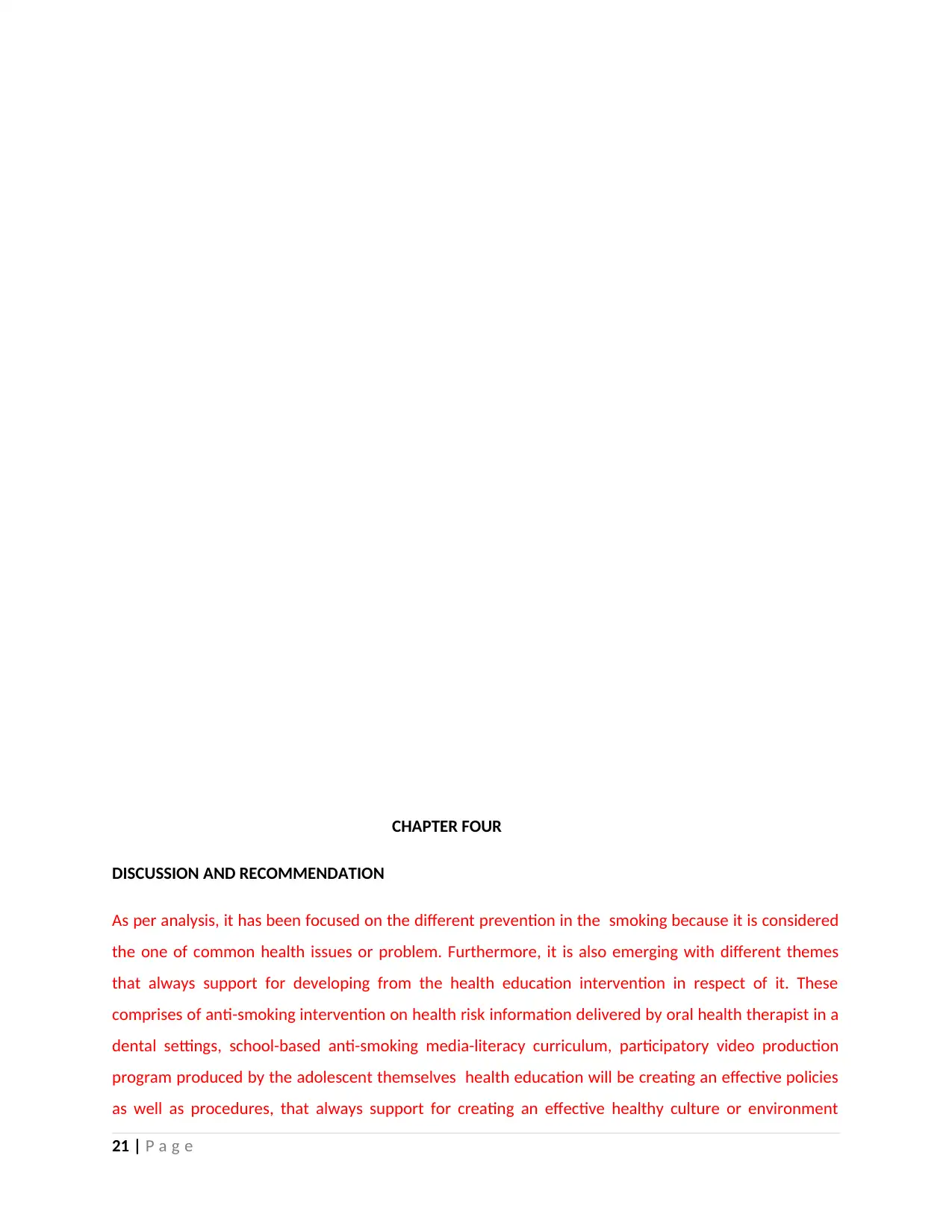
CHAPTER FOUR
DISCUSSION AND RECOMMENDATION
As per analysis, it has been focused on the different prevention in the smoking because it is considered
the one of common health issues or problem. Furthermore, it is also emerging with different themes
that always support for developing from the health education intervention in respect of it. These
comprises of anti-smoking intervention on health risk information delivered by oral health therapist in a
dental settings, school-based anti-smoking media-literacy curriculum, participatory video production
program produced by the adolescent themselves health education will be creating an effective policies
as well as procedures, that always support for creating an effective healthy culture or environment
21 | P a g e
DISCUSSION AND RECOMMENDATION
As per analysis, it has been focused on the different prevention in the smoking because it is considered
the one of common health issues or problem. Furthermore, it is also emerging with different themes
that always support for developing from the health education intervention in respect of it. These
comprises of anti-smoking intervention on health risk information delivered by oral health therapist in a
dental settings, school-based anti-smoking media-literacy curriculum, participatory video production
program produced by the adolescent themselves health education will be creating an effective policies
as well as procedures, that always support for creating an effective healthy culture or environment
21 | P a g e
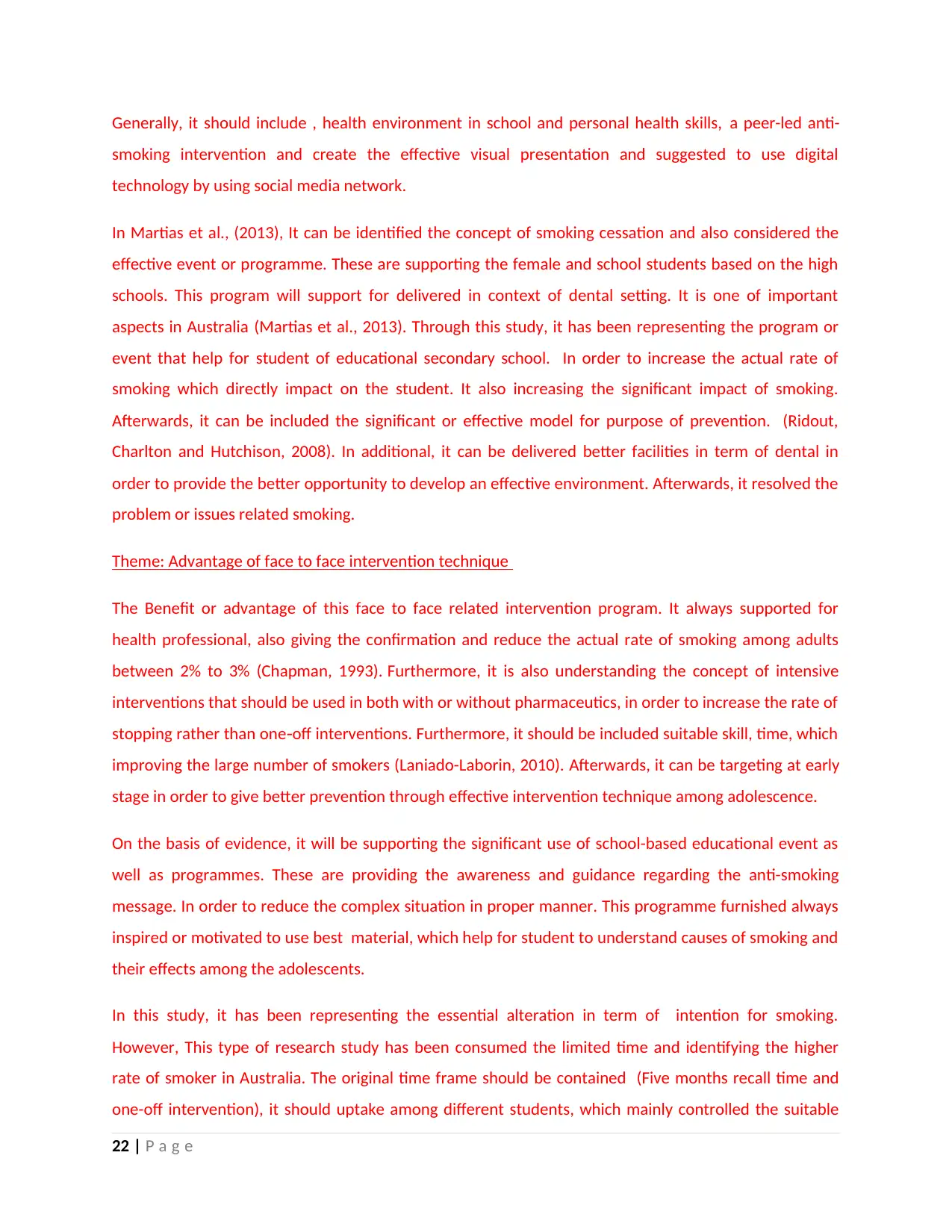
Generally, it should include , health environment in school and personal health skills, a peer-led anti-
smoking intervention and create the effective visual presentation and suggested to use digital
technology by using social media network.
In Martias et al., (2013), It can be identified the concept of smoking cessation and also considered the
effective event or programme. These are supporting the female and school students based on the high
schools. This program will support for delivered in context of dental setting. It is one of important
aspects in Australia (Martias et al., 2013). Through this study, it has been representing the program or
event that help for student of educational secondary school. In order to increase the actual rate of
smoking which directly impact on the student. It also increasing the significant impact of smoking.
Afterwards, it can be included the significant or effective model for purpose of prevention. (Ridout,
Charlton and Hutchison, 2008). In additional, it can be delivered better facilities in term of dental in
order to provide the better opportunity to develop an effective environment. Afterwards, it resolved the
problem or issues related smoking.
Theme: Advantage of face to face intervention technique
The Benefit or advantage of this face to face related intervention program. It always supported for
health professional, also giving the confirmation and reduce the actual rate of smoking among adults
between 2% to 3% (Chapman, 1993). Furthermore, it is also understanding the concept of intensive
interventions that should be used in both with or without pharmaceutics, in order to increase the rate of
stopping rather than one off interventions. Furthermore, it should be included suitable skill, time, which‐
improving the large number of smokers (Laniado-Laborin, 2010). Afterwards, it can be targeting at early
stage in order to give better prevention through effective intervention technique among adolescence.
On the basis of evidence, it will be supporting the significant use of school-based educational event as
well as programmes. These are providing the awareness and guidance regarding the anti-smoking
message. In order to reduce the complex situation in proper manner. This programme furnished always
inspired or motivated to use best material, which help for student to understand causes of smoking and
their effects among the adolescents.
In this study, it has been representing the essential alteration in term of intention for smoking.
However, This type of research study has been consumed the limited time and identifying the higher
rate of smoker in Australia. The original time frame should be contained (Five months recall time and
one-off intervention), it should uptake among different students, which mainly controlled the suitable
22 | P a g e
smoking intervention and create the effective visual presentation and suggested to use digital
technology by using social media network.
In Martias et al., (2013), It can be identified the concept of smoking cessation and also considered the
effective event or programme. These are supporting the female and school students based on the high
schools. This program will support for delivered in context of dental setting. It is one of important
aspects in Australia (Martias et al., 2013). Through this study, it has been representing the program or
event that help for student of educational secondary school. In order to increase the actual rate of
smoking which directly impact on the student. It also increasing the significant impact of smoking.
Afterwards, it can be included the significant or effective model for purpose of prevention. (Ridout,
Charlton and Hutchison, 2008). In additional, it can be delivered better facilities in term of dental in
order to provide the better opportunity to develop an effective environment. Afterwards, it resolved the
problem or issues related smoking.
Theme: Advantage of face to face intervention technique
The Benefit or advantage of this face to face related intervention program. It always supported for
health professional, also giving the confirmation and reduce the actual rate of smoking among adults
between 2% to 3% (Chapman, 1993). Furthermore, it is also understanding the concept of intensive
interventions that should be used in both with or without pharmaceutics, in order to increase the rate of
stopping rather than one off interventions. Furthermore, it should be included suitable skill, time, which‐
improving the large number of smokers (Laniado-Laborin, 2010). Afterwards, it can be targeting at early
stage in order to give better prevention through effective intervention technique among adolescence.
On the basis of evidence, it will be supporting the significant use of school-based educational event as
well as programmes. These are providing the awareness and guidance regarding the anti-smoking
message. In order to reduce the complex situation in proper manner. This programme furnished always
inspired or motivated to use best material, which help for student to understand causes of smoking and
their effects among the adolescents.
In this study, it has been representing the essential alteration in term of intention for smoking.
However, This type of research study has been consumed the limited time and identifying the higher
rate of smoker in Australia. The original time frame should be contained (Five months recall time and
one-off intervention), it should uptake among different students, which mainly controlled the suitable
22 | P a g e
Paraphrase This Document
Need a fresh take? Get an instant paraphrase of this document with our AI Paraphraser
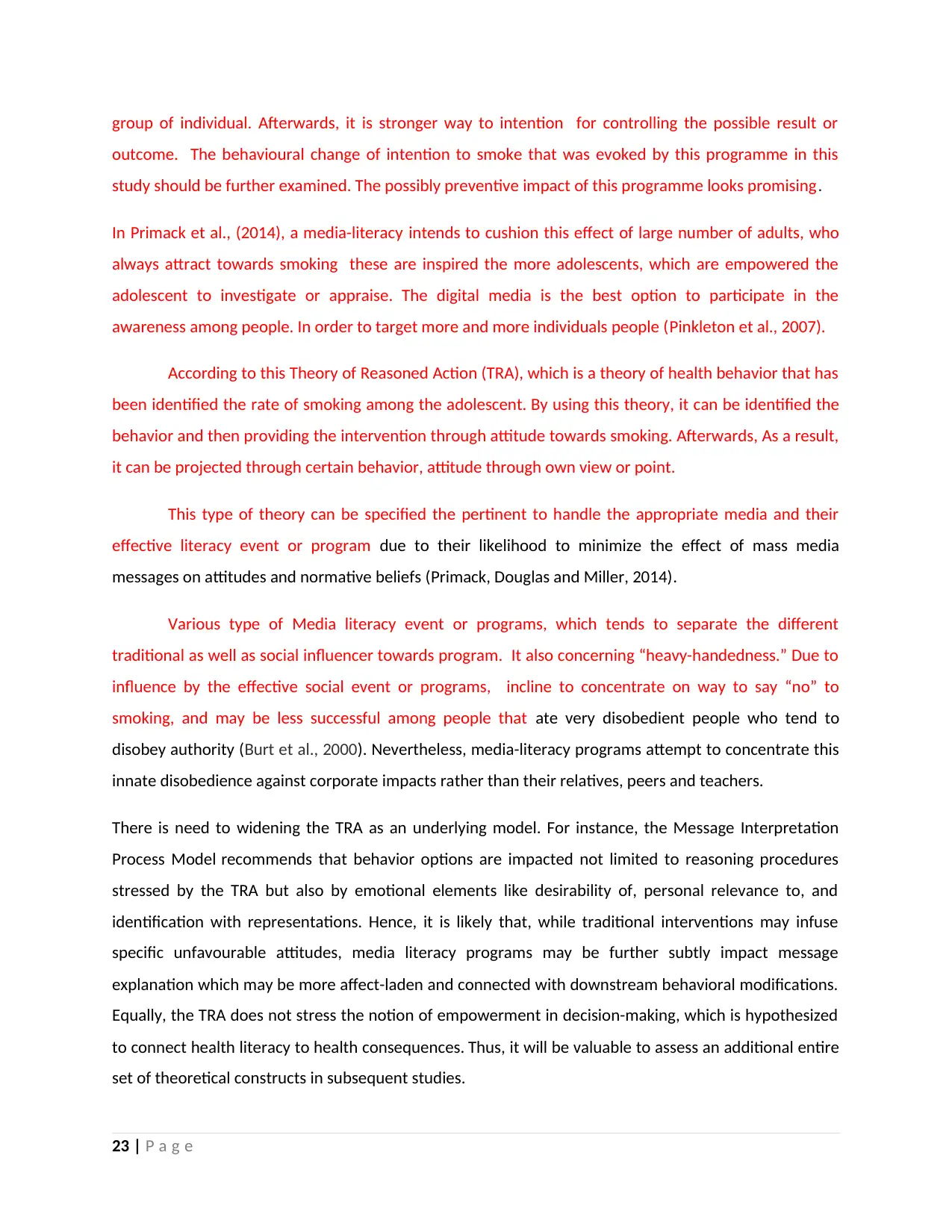
group of individual. Afterwards, it is stronger way to intention for controlling the possible result or
outcome. The behavioural change of intention to smoke that was evoked by this programme in this
study should be further examined. The possibly preventive impact of this programme looks promising.
In Primack et al., (2014), a media-literacy intends to cushion this effect of large number of adults, who
always attract towards smoking these are inspired the more adolescents, which are empowered the
adolescent to investigate or appraise. The digital media is the best option to participate in the
awareness among people. In order to target more and more individuals people (Pinkleton et al., 2007).
According to this Theory of Reasoned Action (TRA), which is a theory of health behavior that has
been identified the rate of smoking among the adolescent. By using this theory, it can be identified the
behavior and then providing the intervention through attitude towards smoking. Afterwards, As a result,
it can be projected through certain behavior, attitude through own view or point.
This type of theory can be specified the pertinent to handle the appropriate media and their
effective literacy event or program due to their likelihood to minimize the effect of mass media
messages on attitudes and normative beliefs (Primack, Douglas and Miller, 2014).
Various type of Media literacy event or programs, which tends to separate the different
traditional as well as social influencer towards program. It also concerning “heavy-handedness.” Due to
influence by the effective social event or programs, incline to concentrate on way to say “no” to
smoking, and may be less successful among people that ate very disobedient people who tend to
disobey authority (Burt et al., 2000). Nevertheless, media-literacy programs attempt to concentrate this
innate disobedience against corporate impacts rather than their relatives, peers and teachers.
There is need to widening the TRA as an underlying model. For instance, the Message Interpretation
Process Model recommends that behavior options are impacted not limited to reasoning procedures
stressed by the TRA but also by emotional elements like desirability of, personal relevance to, and
identification with representations. Hence, it is likely that, while traditional interventions may infuse
specific unfavourable attitudes, media literacy programs may be further subtly impact message
explanation which may be more affect-laden and connected with downstream behavioral modifications.
Equally, the TRA does not stress the notion of empowerment in decision-making, which is hypothesized
to connect health literacy to health consequences. Thus, it will be valuable to assess an additional entire
set of theoretical constructs in subsequent studies.
23 | P a g e
outcome. The behavioural change of intention to smoke that was evoked by this programme in this
study should be further examined. The possibly preventive impact of this programme looks promising.
In Primack et al., (2014), a media-literacy intends to cushion this effect of large number of adults, who
always attract towards smoking these are inspired the more adolescents, which are empowered the
adolescent to investigate or appraise. The digital media is the best option to participate in the
awareness among people. In order to target more and more individuals people (Pinkleton et al., 2007).
According to this Theory of Reasoned Action (TRA), which is a theory of health behavior that has
been identified the rate of smoking among the adolescent. By using this theory, it can be identified the
behavior and then providing the intervention through attitude towards smoking. Afterwards, As a result,
it can be projected through certain behavior, attitude through own view or point.
This type of theory can be specified the pertinent to handle the appropriate media and their
effective literacy event or program due to their likelihood to minimize the effect of mass media
messages on attitudes and normative beliefs (Primack, Douglas and Miller, 2014).
Various type of Media literacy event or programs, which tends to separate the different
traditional as well as social influencer towards program. It also concerning “heavy-handedness.” Due to
influence by the effective social event or programs, incline to concentrate on way to say “no” to
smoking, and may be less successful among people that ate very disobedient people who tend to
disobey authority (Burt et al., 2000). Nevertheless, media-literacy programs attempt to concentrate this
innate disobedience against corporate impacts rather than their relatives, peers and teachers.
There is need to widening the TRA as an underlying model. For instance, the Message Interpretation
Process Model recommends that behavior options are impacted not limited to reasoning procedures
stressed by the TRA but also by emotional elements like desirability of, personal relevance to, and
identification with representations. Hence, it is likely that, while traditional interventions may infuse
specific unfavourable attitudes, media literacy programs may be further subtly impact message
explanation which may be more affect-laden and connected with downstream behavioral modifications.
Equally, the TRA does not stress the notion of empowerment in decision-making, which is hypothesized
to connect health literacy to health consequences. Thus, it will be valuable to assess an additional entire
set of theoretical constructs in subsequent studies.
23 | P a g e
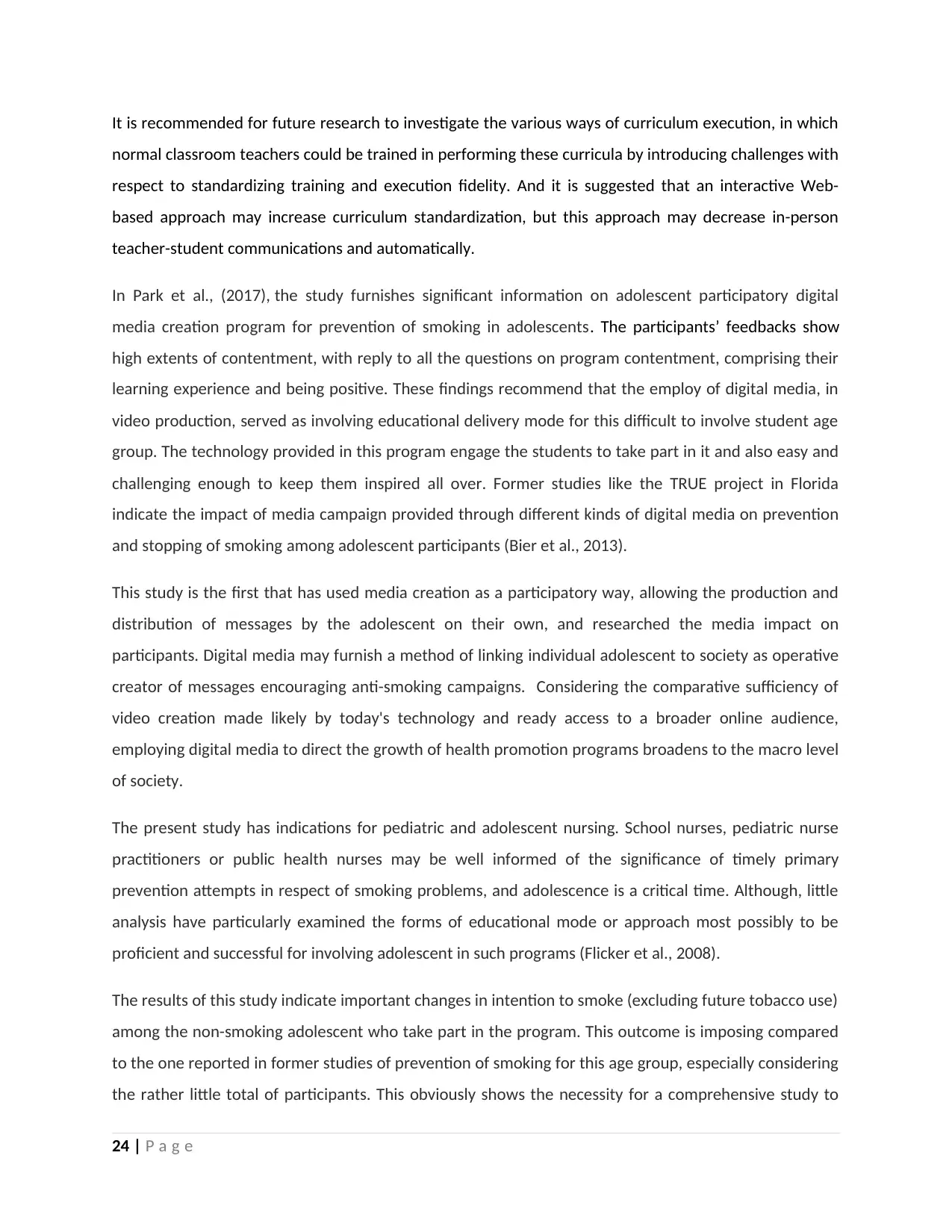
It is recommended for future research to investigate the various ways of curriculum execution, in which
normal classroom teachers could be trained in performing these curricula by introducing challenges with
respect to standardizing training and execution fidelity. And it is suggested that an interactive Web-
based approach may increase curriculum standardization, but this approach may decrease in-person
teacher-student communications and automatically.
In Park et al., (2017), the study furnishes significant information on adolescent participatory digital
media creation program for prevention of smoking in adolescents. The participants’ feedbacks show
high extents of contentment, with reply to all the questions on program contentment, comprising their
learning experience and being positive. These findings recommend that the employ of digital media, in
video production, served as involving educational delivery mode for this difficult to involve student age
group. The technology provided in this program engage the students to take part in it and also easy and
challenging enough to keep them inspired all over. Former studies like the TRUE project in Florida
indicate the impact of media campaign provided through different kinds of digital media on prevention
and stopping of smoking among adolescent participants (Bier et al., 2013).
This study is the first that has used media creation as a participatory way, allowing the production and
distribution of messages by the adolescent on their own, and researched the media impact on
participants. Digital media may furnish a method of linking individual adolescent to society as operative
creator of messages encouraging anti-smoking campaigns. Considering the comparative sufficiency of
video creation made likely by today's technology and ready access to a broader online audience,
employing digital media to direct the growth of health promotion programs broadens to the macro level
of society.
The present study has indications for pediatric and adolescent nursing. School nurses, pediatric nurse
practitioners or public health nurses may be well informed of the significance of timely primary
prevention attempts in respect of smoking problems, and adolescence is a critical time. Although, little
analysis have particularly examined the forms of educational mode or approach most possibly to be
proficient and successful for involving adolescent in such programs (Flicker et al., 2008).
The results of this study indicate important changes in intention to smoke (excluding future tobacco use)
among the non-smoking adolescent who take part in the program. This outcome is imposing compared
to the one reported in former studies of prevention of smoking for this age group, especially considering
the rather little total of participants. This obviously shows the necessity for a comprehensive study to
24 | P a g e
normal classroom teachers could be trained in performing these curricula by introducing challenges with
respect to standardizing training and execution fidelity. And it is suggested that an interactive Web-
based approach may increase curriculum standardization, but this approach may decrease in-person
teacher-student communications and automatically.
In Park et al., (2017), the study furnishes significant information on adolescent participatory digital
media creation program for prevention of smoking in adolescents. The participants’ feedbacks show
high extents of contentment, with reply to all the questions on program contentment, comprising their
learning experience and being positive. These findings recommend that the employ of digital media, in
video production, served as involving educational delivery mode for this difficult to involve student age
group. The technology provided in this program engage the students to take part in it and also easy and
challenging enough to keep them inspired all over. Former studies like the TRUE project in Florida
indicate the impact of media campaign provided through different kinds of digital media on prevention
and stopping of smoking among adolescent participants (Bier et al., 2013).
This study is the first that has used media creation as a participatory way, allowing the production and
distribution of messages by the adolescent on their own, and researched the media impact on
participants. Digital media may furnish a method of linking individual adolescent to society as operative
creator of messages encouraging anti-smoking campaigns. Considering the comparative sufficiency of
video creation made likely by today's technology and ready access to a broader online audience,
employing digital media to direct the growth of health promotion programs broadens to the macro level
of society.
The present study has indications for pediatric and adolescent nursing. School nurses, pediatric nurse
practitioners or public health nurses may be well informed of the significance of timely primary
prevention attempts in respect of smoking problems, and adolescence is a critical time. Although, little
analysis have particularly examined the forms of educational mode or approach most possibly to be
proficient and successful for involving adolescent in such programs (Flicker et al., 2008).
The results of this study indicate important changes in intention to smoke (excluding future tobacco use)
among the non-smoking adolescent who take part in the program. This outcome is imposing compared
to the one reported in former studies of prevention of smoking for this age group, especially considering
the rather little total of participants. This obviously shows the necessity for a comprehensive study to
24 | P a g e
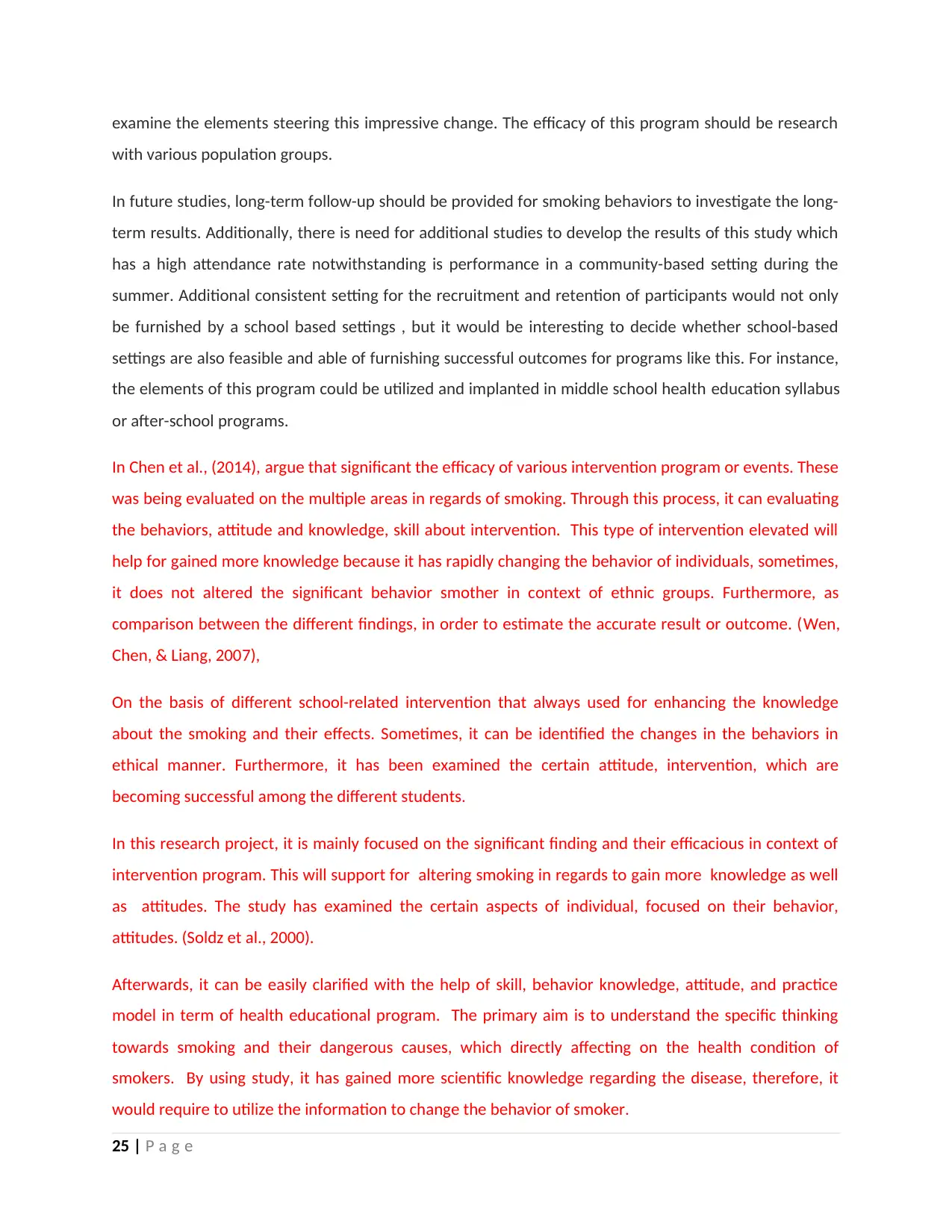
examine the elements steering this impressive change. The efficacy of this program should be research
with various population groups.
In future studies, long-term follow-up should be provided for smoking behaviors to investigate the long-
term results. Additionally, there is need for additional studies to develop the results of this study which
has a high attendance rate notwithstanding is performance in a community-based setting during the
summer. Additional consistent setting for the recruitment and retention of participants would not only
be furnished by a school based settings , but it would be interesting to decide whether school-based
settings are also feasible and able of furnishing successful outcomes for programs like this. For instance,
the elements of this program could be utilized and implanted in middle school health education syllabus
or after-school programs.
In Chen et al., (2014), argue that significant the efficacy of various intervention program or events. These
was being evaluated on the multiple areas in regards of smoking. Through this process, it can evaluating
the behaviors, attitude and knowledge, skill about intervention. This type of intervention elevated will
help for gained more knowledge because it has rapidly changing the behavior of individuals, sometimes,
it does not altered the significant behavior smother in context of ethnic groups. Furthermore, as
comparison between the different findings, in order to estimate the accurate result or outcome. (Wen,
Chen, & Liang, 2007),
On the basis of different school-related intervention that always used for enhancing the knowledge
about the smoking and their effects. Sometimes, it can be identified the changes in the behaviors in
ethical manner. Furthermore, it has been examined the certain attitude, intervention, which are
becoming successful among the different students.
In this research project, it is mainly focused on the significant finding and their efficacious in context of
intervention program. This will support for altering smoking in regards to gain more knowledge as well
as attitudes. The study has examined the certain aspects of individual, focused on their behavior,
attitudes. (Soldz et al., 2000).
Afterwards, it can be easily clarified with the help of skill, behavior knowledge, attitude, and practice
model in term of health educational program. The primary aim is to understand the specific thinking
towards smoking and their dangerous causes, which directly affecting on the health condition of
smokers. By using study, it has gained more scientific knowledge regarding the disease, therefore, it
would require to utilize the information to change the behavior of smoker.
25 | P a g e
with various population groups.
In future studies, long-term follow-up should be provided for smoking behaviors to investigate the long-
term results. Additionally, there is need for additional studies to develop the results of this study which
has a high attendance rate notwithstanding is performance in a community-based setting during the
summer. Additional consistent setting for the recruitment and retention of participants would not only
be furnished by a school based settings , but it would be interesting to decide whether school-based
settings are also feasible and able of furnishing successful outcomes for programs like this. For instance,
the elements of this program could be utilized and implanted in middle school health education syllabus
or after-school programs.
In Chen et al., (2014), argue that significant the efficacy of various intervention program or events. These
was being evaluated on the multiple areas in regards of smoking. Through this process, it can evaluating
the behaviors, attitude and knowledge, skill about intervention. This type of intervention elevated will
help for gained more knowledge because it has rapidly changing the behavior of individuals, sometimes,
it does not altered the significant behavior smother in context of ethnic groups. Furthermore, as
comparison between the different findings, in order to estimate the accurate result or outcome. (Wen,
Chen, & Liang, 2007),
On the basis of different school-related intervention that always used for enhancing the knowledge
about the smoking and their effects. Sometimes, it can be identified the changes in the behaviors in
ethical manner. Furthermore, it has been examined the certain attitude, intervention, which are
becoming successful among the different students.
In this research project, it is mainly focused on the significant finding and their efficacious in context of
intervention program. This will support for altering smoking in regards to gain more knowledge as well
as attitudes. The study has examined the certain aspects of individual, focused on their behavior,
attitudes. (Soldz et al., 2000).
Afterwards, it can be easily clarified with the help of skill, behavior knowledge, attitude, and practice
model in term of health educational program. The primary aim is to understand the specific thinking
towards smoking and their dangerous causes, which directly affecting on the health condition of
smokers. By using study, it has gained more scientific knowledge regarding the disease, therefore, it
would require to utilize the information to change the behavior of smoker.
25 | P a g e
Secure Best Marks with AI Grader
Need help grading? Try our AI Grader for instant feedback on your assignments.
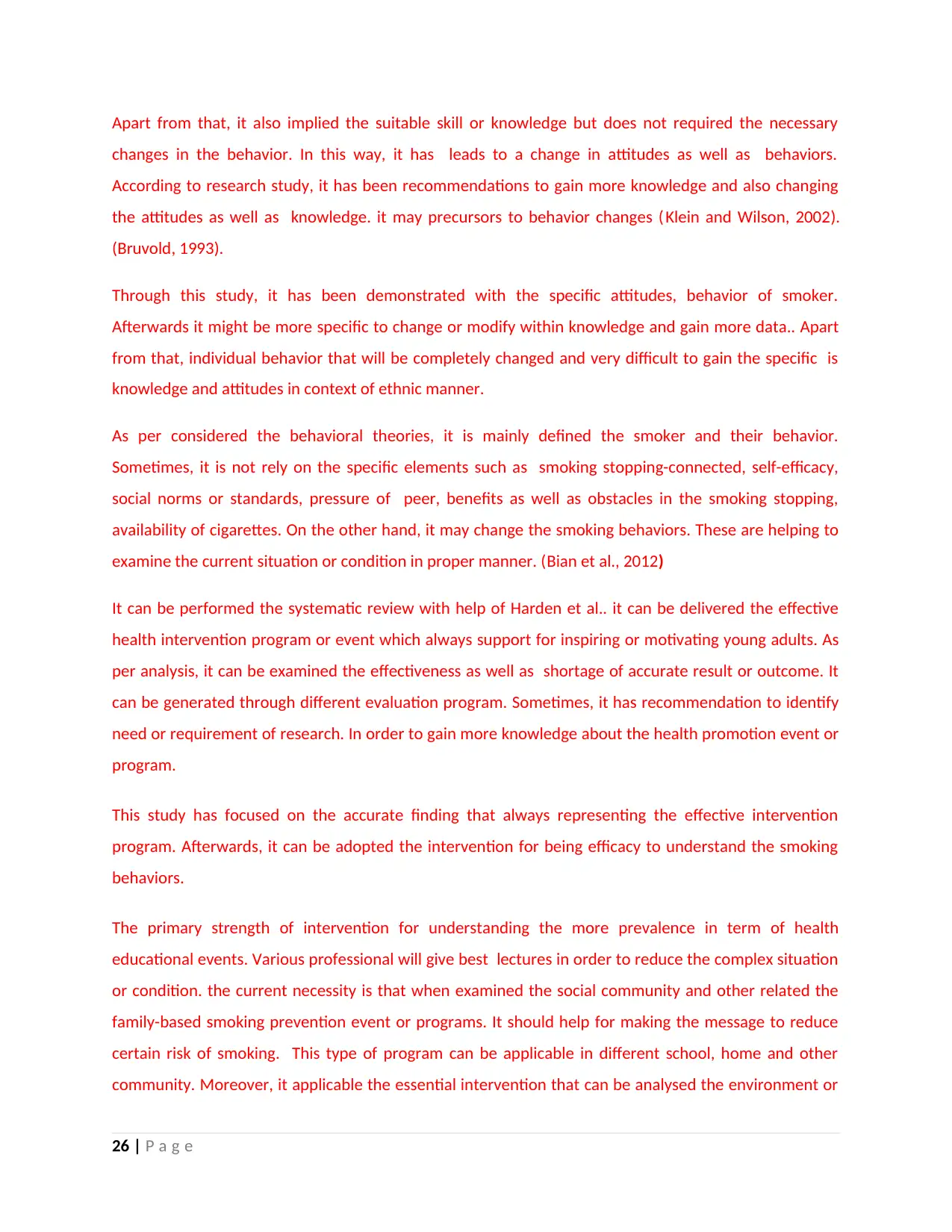
Apart from that, it also implied the suitable skill or knowledge but does not required the necessary
changes in the behavior. In this way, it has leads to a change in attitudes as well as behaviors.
According to research study, it has been recommendations to gain more knowledge and also changing
the attitudes as well as knowledge. it may precursors to behavior changes ( Klein and Wilson, 2002).
(Bruvold, 1993).
Through this study, it has been demonstrated with the specific attitudes, behavior of smoker.
Afterwards it might be more specific to change or modify within knowledge and gain more data.. Apart
from that, individual behavior that will be completely changed and very difficult to gain the specific is
knowledge and attitudes in context of ethnic manner.
As per considered the behavioral theories, it is mainly defined the smoker and their behavior.
Sometimes, it is not rely on the specific elements such as smoking stopping-connected, self-efficacy,
social norms or standards, pressure of peer, benefits as well as obstacles in the smoking stopping,
availability of cigarettes. On the other hand, it may change the smoking behaviors. These are helping to
examine the current situation or condition in proper manner. (Bian et al., 2012)
It can be performed the systematic review with help of Harden et al.. it can be delivered the effective
health intervention program or event which always support for inspiring or motivating young adults. As
per analysis, it can be examined the effectiveness as well as shortage of accurate result or outcome. It
can be generated through different evaluation program. Sometimes, it has recommendation to identify
need or requirement of research. In order to gain more knowledge about the health promotion event or
program.
This study has focused on the accurate finding that always representing the effective intervention
program. Afterwards, it can be adopted the intervention for being efficacy to understand the smoking
behaviors.
The primary strength of intervention for understanding the more prevalence in term of health
educational events. Various professional will give best lectures in order to reduce the complex situation
or condition. the current necessity is that when examined the social community and other related the
family-based smoking prevention event or programs. It should help for making the message to reduce
certain risk of smoking. This type of program can be applicable in different school, home and other
community. Moreover, it applicable the essential intervention that can be analysed the environment or
26 | P a g e
changes in the behavior. In this way, it has leads to a change in attitudes as well as behaviors.
According to research study, it has been recommendations to gain more knowledge and also changing
the attitudes as well as knowledge. it may precursors to behavior changes ( Klein and Wilson, 2002).
(Bruvold, 1993).
Through this study, it has been demonstrated with the specific attitudes, behavior of smoker.
Afterwards it might be more specific to change or modify within knowledge and gain more data.. Apart
from that, individual behavior that will be completely changed and very difficult to gain the specific is
knowledge and attitudes in context of ethnic manner.
As per considered the behavioral theories, it is mainly defined the smoker and their behavior.
Sometimes, it is not rely on the specific elements such as smoking stopping-connected, self-efficacy,
social norms or standards, pressure of peer, benefits as well as obstacles in the smoking stopping,
availability of cigarettes. On the other hand, it may change the smoking behaviors. These are helping to
examine the current situation or condition in proper manner. (Bian et al., 2012)
It can be performed the systematic review with help of Harden et al.. it can be delivered the effective
health intervention program or event which always support for inspiring or motivating young adults. As
per analysis, it can be examined the effectiveness as well as shortage of accurate result or outcome. It
can be generated through different evaluation program. Sometimes, it has recommendation to identify
need or requirement of research. In order to gain more knowledge about the health promotion event or
program.
This study has focused on the accurate finding that always representing the effective intervention
program. Afterwards, it can be adopted the intervention for being efficacy to understand the smoking
behaviors.
The primary strength of intervention for understanding the more prevalence in term of health
educational events. Various professional will give best lectures in order to reduce the complex situation
or condition. the current necessity is that when examined the social community and other related the
family-based smoking prevention event or programs. It should help for making the message to reduce
certain risk of smoking. This type of program can be applicable in different school, home and other
community. Moreover, it applicable the essential intervention that can be analysed the environment or
26 | P a g e
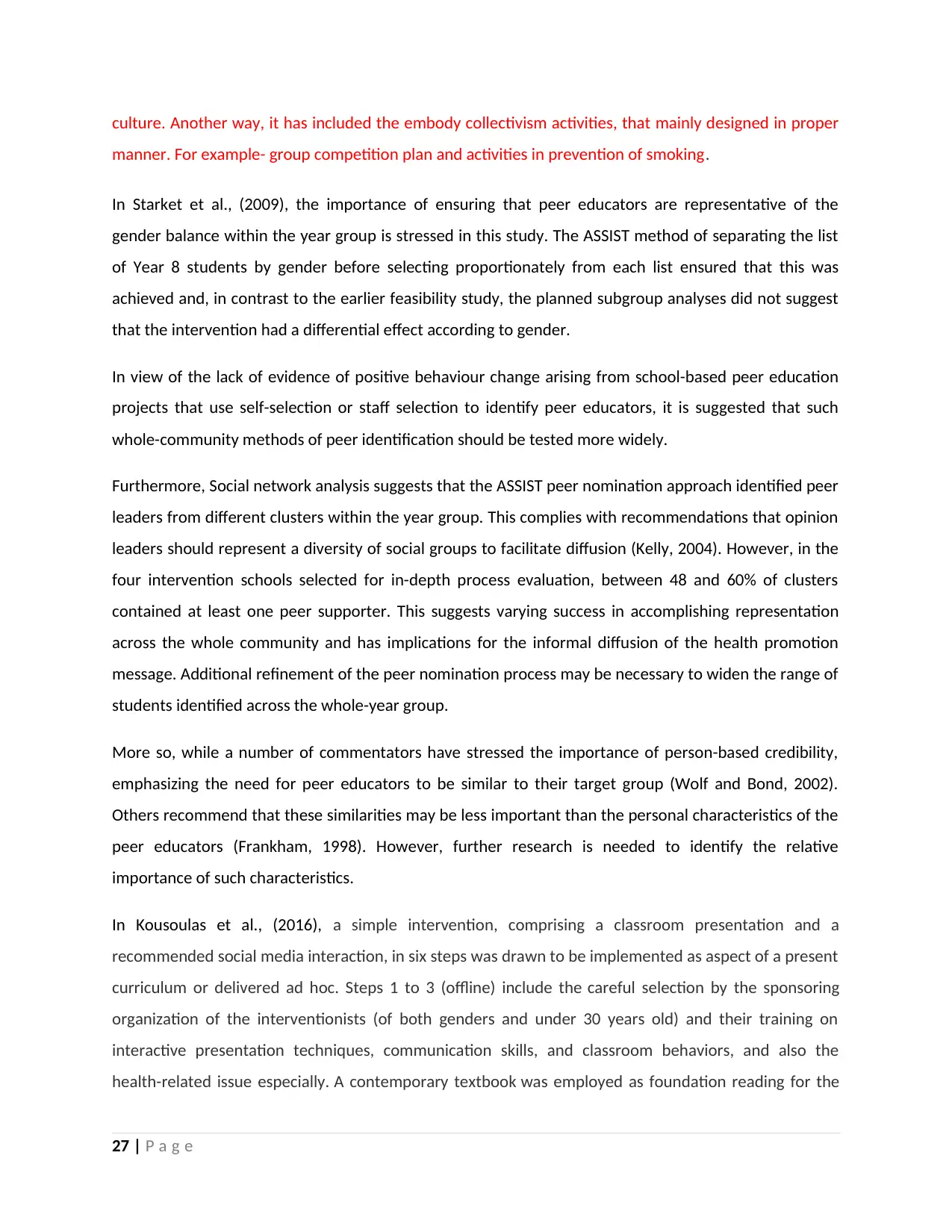
culture. Another way, it has included the embody collectivism activities, that mainly designed in proper
manner. For example- group competition plan and activities in prevention of smoking.
In Starket et al., (2009), the importance of ensuring that peer educators are representative of the
gender balance within the year group is stressed in this study. The ASSIST method of separating the list
of Year 8 students by gender before selecting proportionately from each list ensured that this was
achieved and, in contrast to the earlier feasibility study, the planned subgroup analyses did not suggest
that the intervention had a differential effect according to gender.
In view of the lack of evidence of positive behaviour change arising from school-based peer education
projects that use self-selection or staff selection to identify peer educators, it is suggested that such
whole-community methods of peer identification should be tested more widely.
Furthermore, Social network analysis suggests that the ASSIST peer nomination approach identified peer
leaders from different clusters within the year group. This complies with recommendations that opinion
leaders should represent a diversity of social groups to facilitate diffusion (Kelly, 2004). However, in the
four intervention schools selected for in-depth process evaluation, between 48 and 60% of clusters
contained at least one peer supporter. This suggests varying success in accomplishing representation
across the whole community and has implications for the informal diffusion of the health promotion
message. Additional refinement of the peer nomination process may be necessary to widen the range of
students identified across the whole-year group.
More so, while a number of commentators have stressed the importance of person-based credibility,
emphasizing the need for peer educators to be similar to their target group (Wolf and Bond, 2002).
Others recommend that these similarities may be less important than the personal characteristics of the
peer educators (Frankham, 1998). However, further research is needed to identify the relative
importance of such characteristics.
In Kousoulas et al., (2016), a simple intervention, comprising a classroom presentation and a
recommended social media interaction, in six steps was drawn to be implemented as aspect of a present
curriculum or delivered ad hoc. Steps 1 to 3 (offline) include the careful selection by the sponsoring
organization of the interventionists (of both genders and under 30 years old) and their training on
interactive presentation techniques, communication skills, and classroom behaviors, and also the
health-related issue especially. A contemporary textbook was employed as foundation reading for the
27 | P a g e
manner. For example- group competition plan and activities in prevention of smoking.
In Starket et al., (2009), the importance of ensuring that peer educators are representative of the
gender balance within the year group is stressed in this study. The ASSIST method of separating the list
of Year 8 students by gender before selecting proportionately from each list ensured that this was
achieved and, in contrast to the earlier feasibility study, the planned subgroup analyses did not suggest
that the intervention had a differential effect according to gender.
In view of the lack of evidence of positive behaviour change arising from school-based peer education
projects that use self-selection or staff selection to identify peer educators, it is suggested that such
whole-community methods of peer identification should be tested more widely.
Furthermore, Social network analysis suggests that the ASSIST peer nomination approach identified peer
leaders from different clusters within the year group. This complies with recommendations that opinion
leaders should represent a diversity of social groups to facilitate diffusion (Kelly, 2004). However, in the
four intervention schools selected for in-depth process evaluation, between 48 and 60% of clusters
contained at least one peer supporter. This suggests varying success in accomplishing representation
across the whole community and has implications for the informal diffusion of the health promotion
message. Additional refinement of the peer nomination process may be necessary to widen the range of
students identified across the whole-year group.
More so, while a number of commentators have stressed the importance of person-based credibility,
emphasizing the need for peer educators to be similar to their target group (Wolf and Bond, 2002).
Others recommend that these similarities may be less important than the personal characteristics of the
peer educators (Frankham, 1998). However, further research is needed to identify the relative
importance of such characteristics.
In Kousoulas et al., (2016), a simple intervention, comprising a classroom presentation and a
recommended social media interaction, in six steps was drawn to be implemented as aspect of a present
curriculum or delivered ad hoc. Steps 1 to 3 (offline) include the careful selection by the sponsoring
organization of the interventionists (of both genders and under 30 years old) and their training on
interactive presentation techniques, communication skills, and classroom behaviors, and also the
health-related issue especially. A contemporary textbook was employed as foundation reading for the
27 | P a g e
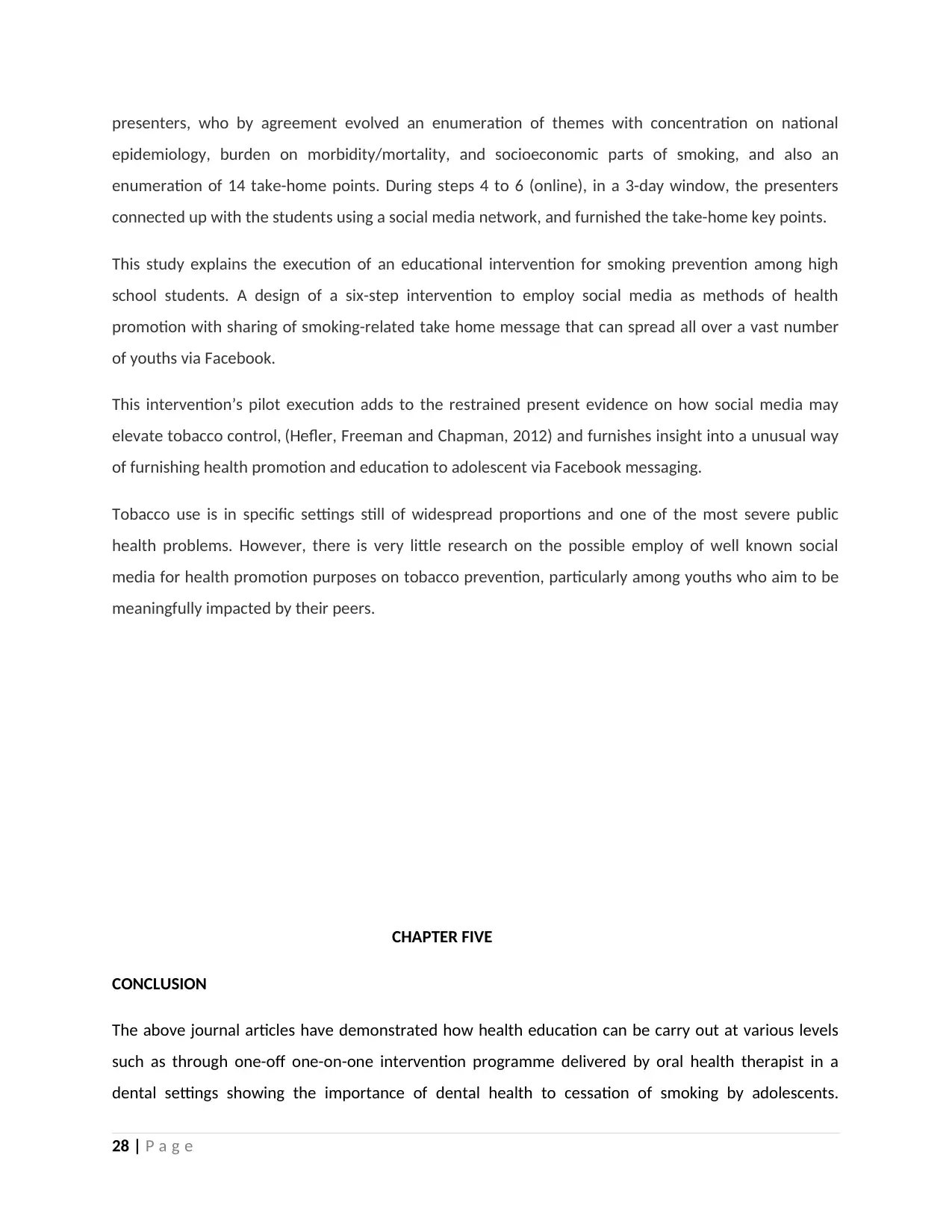
presenters, who by agreement evolved an enumeration of themes with concentration on national
epidemiology, burden on morbidity/mortality, and socioeconomic parts of smoking, and also an
enumeration of 14 take-home points. During steps 4 to 6 (online), in a 3-day window, the presenters
connected up with the students using a social media network, and furnished the take-home key points.
This study explains the execution of an educational intervention for smoking prevention among high
school students. A design of a six-step intervention to employ social media as methods of health
promotion with sharing of smoking-related take home message that can spread all over a vast number
of youths via Facebook.
This intervention’s pilot execution adds to the restrained present evidence on how social media may
elevate tobacco control, (Hefler, Freeman and Chapman, 2012) and furnishes insight into a unusual way
of furnishing health promotion and education to adolescent via Facebook messaging.
Tobacco use is in specific settings still of widespread proportions and one of the most severe public
health problems. However, there is very little research on the possible employ of well known social
media for health promotion purposes on tobacco prevention, particularly among youths who aim to be
meaningfully impacted by their peers.
CHAPTER FIVE
CONCLUSION
The above journal articles have demonstrated how health education can be carry out at various levels
such as through one-off one-on-one intervention programme delivered by oral health therapist in a
dental settings showing the importance of dental health to cessation of smoking by adolescents.
28 | P a g e
epidemiology, burden on morbidity/mortality, and socioeconomic parts of smoking, and also an
enumeration of 14 take-home points. During steps 4 to 6 (online), in a 3-day window, the presenters
connected up with the students using a social media network, and furnished the take-home key points.
This study explains the execution of an educational intervention for smoking prevention among high
school students. A design of a six-step intervention to employ social media as methods of health
promotion with sharing of smoking-related take home message that can spread all over a vast number
of youths via Facebook.
This intervention’s pilot execution adds to the restrained present evidence on how social media may
elevate tobacco control, (Hefler, Freeman and Chapman, 2012) and furnishes insight into a unusual way
of furnishing health promotion and education to adolescent via Facebook messaging.
Tobacco use is in specific settings still of widespread proportions and one of the most severe public
health problems. However, there is very little research on the possible employ of well known social
media for health promotion purposes on tobacco prevention, particularly among youths who aim to be
meaningfully impacted by their peers.
CHAPTER FIVE
CONCLUSION
The above journal articles have demonstrated how health education can be carry out at various levels
such as through one-off one-on-one intervention programme delivered by oral health therapist in a
dental settings showing the importance of dental health to cessation of smoking by adolescents.
28 | P a g e
Paraphrase This Document
Need a fresh take? Get an instant paraphrase of this document with our AI Paraphraser

Additionally, media-literacy curriculum intervention also shows the significance of health education
taught in school-based in respect of prevention of smoking in youth. This is seen to be more effective
among those rebellious youth than the traditional social influences program that tends to concentrate
on saying NO to smoking because focussing the intervention on media exposure robustly linked with
yielded results. Furthermore, a participatory video produced by the youth themselves to prevent
starting of smoking among adolescents. In addition, digital media are exceptionally effective and view as
suitable for educational mode because they are possible to attract youth’s attention and inspire them as
active learner (Benneth, 2008). More so, school-based intervention program on attitudes and behaviour
towards smoking which see the intervention program based on health education on health policies in
school, health environment in school and personal health skills. A peer-led anti-smoking intervention
carried out in a community involving a large number of schools and a classroom presentation and
suggested social media interaction all demonstrated how health education has been used through
multiple-channel and multiple campaign to prevent smoking in adolescents.
All these health educations are not alone without being based on different theories of key health
promotion ranges from different theories that help for performing the actions towards health condition
of employee. Action, a widely applied theory of health behaviour that has been utilized to predicted
attitudes and behaviour towards smoking in adolescents. As per discussion, it has identified the features
and examine the background with the help of different theories it can be assertion that examine the
current aspects of behavioural intention is the most meaningful element of behaviour. The TRA and TPB
allege that individuals consider the results of their actions before going on or abstain from any particular
behaviour (Sharma, 2016). These two theories stresses the role of thoughts in decision making about
involving in behaviour and they states that an individual’s intention is decided by two antecedents,
including personal factors and social influences. The TPB include a third predictor, that of control over
the behaviour.
Also, Diffusion of innovations theory has been used as a significant to understanding on how opinions
and practices spread throughout a community. The self-determination Theory and the Global Youth
Voices model were all applied to various health education interventions in this research.
It is pertinent to note that for health education to be effective a single intervention cannot be sufficient
to avert smoking in adolescents because of the multifactorial nature of the health issues. This is shown
in all of the journal articles because they all have one or two limitations and further research is still
required in most of the interventions used.
29 | P a g e
taught in school-based in respect of prevention of smoking in youth. This is seen to be more effective
among those rebellious youth than the traditional social influences program that tends to concentrate
on saying NO to smoking because focussing the intervention on media exposure robustly linked with
yielded results. Furthermore, a participatory video produced by the youth themselves to prevent
starting of smoking among adolescents. In addition, digital media are exceptionally effective and view as
suitable for educational mode because they are possible to attract youth’s attention and inspire them as
active learner (Benneth, 2008). More so, school-based intervention program on attitudes and behaviour
towards smoking which see the intervention program based on health education on health policies in
school, health environment in school and personal health skills. A peer-led anti-smoking intervention
carried out in a community involving a large number of schools and a classroom presentation and
suggested social media interaction all demonstrated how health education has been used through
multiple-channel and multiple campaign to prevent smoking in adolescents.
All these health educations are not alone without being based on different theories of key health
promotion ranges from different theories that help for performing the actions towards health condition
of employee. Action, a widely applied theory of health behaviour that has been utilized to predicted
attitudes and behaviour towards smoking in adolescents. As per discussion, it has identified the features
and examine the background with the help of different theories it can be assertion that examine the
current aspects of behavioural intention is the most meaningful element of behaviour. The TRA and TPB
allege that individuals consider the results of their actions before going on or abstain from any particular
behaviour (Sharma, 2016). These two theories stresses the role of thoughts in decision making about
involving in behaviour and they states that an individual’s intention is decided by two antecedents,
including personal factors and social influences. The TPB include a third predictor, that of control over
the behaviour.
Also, Diffusion of innovations theory has been used as a significant to understanding on how opinions
and practices spread throughout a community. The self-determination Theory and the Global Youth
Voices model were all applied to various health education interventions in this research.
It is pertinent to note that for health education to be effective a single intervention cannot be sufficient
to avert smoking in adolescents because of the multifactorial nature of the health issues. This is shown
in all of the journal articles because they all have one or two limitations and further research is still
required in most of the interventions used.
29 | P a g e

APPENDIX
CASP
30 | P a g e
CASP
30 | P a g e
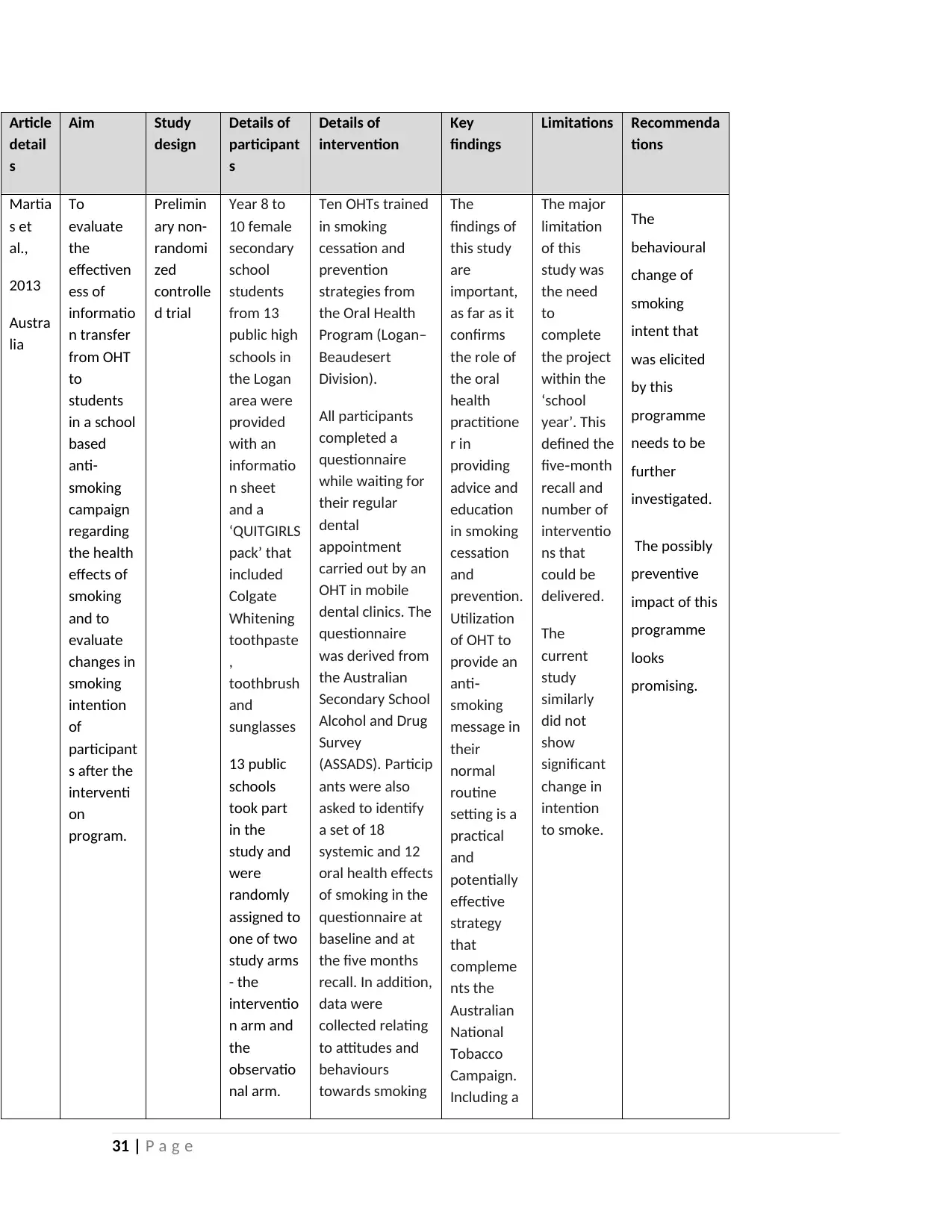
Article
detail
s
Aim Study
design
Details of
participant
s
Details of
intervention
Key
findings
Limitations Recommenda
tions
Martia
s et
al.,
2013
Austra
lia
To
evaluate
the
effectiven
ess of
informatio
n transfer
from OHT
to
students
in a school
based
anti-
smoking
campaign
regarding
the health
effects of
smoking
and to
evaluate
changes in
smoking
intention
of
participant
s after the
interventi
on
program.
Prelimin
ary non-
randomi
zed
controlle
d trial
Year 8 to
10 female
secondary
school
students
from 13
public high
schools in
the Logan
area were
provided
with an
informatio
n sheet
and a
‘QUITGIRLS
pack’ that
included
Colgate
Whitening
toothpaste
,
toothbrush
and
sunglasses
13 public
schools
took part
in the
study and
were
randomly
assigned to
one of two
study arms
- the
interventio
n arm and
the
observatio
nal arm.
Ten OHTs trained
in smoking
cessation and
prevention
strategies from
the Oral Health
Program (Logan–
Beaudesert
Division).
All participants
completed a
questionnaire
while waiting for
their regular
dental
appointment
carried out by an
OHT in mobile
dental clinics. The
questionnaire
was derived from
the Australian
Secondary School
Alcohol and Drug
Survey
(ASSADS). Particip
ants were also
asked to identify
a set of 18
systemic and 12
oral health effects
of smoking in the
questionnaire at
baseline and at
the five months
recall. In addition,
data were
collected relating
to attitudes and
behaviours
towards smoking
The
findings of
this study
are
important,
as far as it
confirms
the role of
the oral
health
practitione
r in
providing
advice and
education
in smoking
cessation
and
prevention.
Utilization
of OHT to
provide an
anti‐
smoking
message in
their
normal
routine
setting is a
practical
and
potentially
effective
strategy
that
compleme
nts the
Australian
National
Tobacco
Campaign.
Including a
The major
limitation
of this
study was
the need
to
complete
the project
within the
‘school
year’. This
defined the
five month‐
recall and
number of
interventio
ns that
could be
delivered.
The
current
study
similarly
did not
show
significant
change in
intention
to smoke.
The
behavioural
change of
smoking
intent that
was elicited
by this
programme
needs to be
further
investigated.
The possibly
preventive
impact of this
programme
looks
promising.
31 | P a g e
detail
s
Aim Study
design
Details of
participant
s
Details of
intervention
Key
findings
Limitations Recommenda
tions
Martia
s et
al.,
2013
Austra
lia
To
evaluate
the
effectiven
ess of
informatio
n transfer
from OHT
to
students
in a school
based
anti-
smoking
campaign
regarding
the health
effects of
smoking
and to
evaluate
changes in
smoking
intention
of
participant
s after the
interventi
on
program.
Prelimin
ary non-
randomi
zed
controlle
d trial
Year 8 to
10 female
secondary
school
students
from 13
public high
schools in
the Logan
area were
provided
with an
informatio
n sheet
and a
‘QUITGIRLS
pack’ that
included
Colgate
Whitening
toothpaste
,
toothbrush
and
sunglasses
13 public
schools
took part
in the
study and
were
randomly
assigned to
one of two
study arms
- the
interventio
n arm and
the
observatio
nal arm.
Ten OHTs trained
in smoking
cessation and
prevention
strategies from
the Oral Health
Program (Logan–
Beaudesert
Division).
All participants
completed a
questionnaire
while waiting for
their regular
dental
appointment
carried out by an
OHT in mobile
dental clinics. The
questionnaire
was derived from
the Australian
Secondary School
Alcohol and Drug
Survey
(ASSADS). Particip
ants were also
asked to identify
a set of 18
systemic and 12
oral health effects
of smoking in the
questionnaire at
baseline and at
the five months
recall. In addition,
data were
collected relating
to attitudes and
behaviours
towards smoking
The
findings of
this study
are
important,
as far as it
confirms
the role of
the oral
health
practitione
r in
providing
advice and
education
in smoking
cessation
and
prevention.
Utilization
of OHT to
provide an
anti‐
smoking
message in
their
normal
routine
setting is a
practical
and
potentially
effective
strategy
that
compleme
nts the
Australian
National
Tobacco
Campaign.
Including a
The major
limitation
of this
study was
the need
to
complete
the project
within the
‘school
year’. This
defined the
five month‐
recall and
number of
interventio
ns that
could be
delivered.
The
current
study
similarly
did not
show
significant
change in
intention
to smoke.
The
behavioural
change of
smoking
intent that
was elicited
by this
programme
needs to be
further
investigated.
The possibly
preventive
impact of this
programme
looks
promising.
31 | P a g e
Secure Best Marks with AI Grader
Need help grading? Try our AI Grader for instant feedback on your assignments.
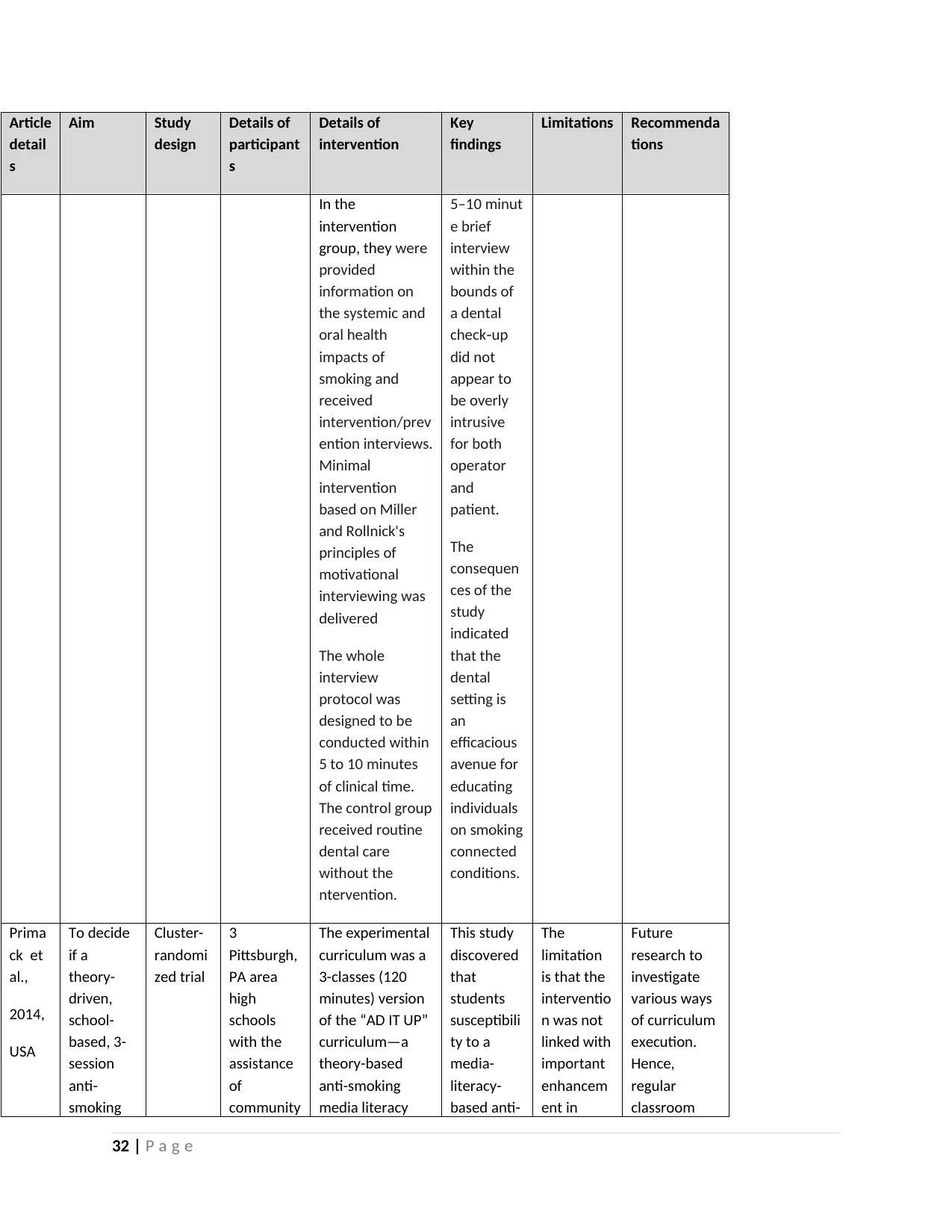
Article
detail
s
Aim Study
design
Details of
participant
s
Details of
intervention
Key
findings
Limitations Recommenda
tions
In the
intervention
group, they were
provided
information on
the systemic and
oral health
impacts of
smoking and
received
intervention/prev
ention interviews.
Minimal
intervention
based on Miller
and Rollnick's
principles of
motivational
interviewing was
delivered
The whole
interview
protocol was
designed to be
conducted within
5 to 10 minutes
of clinical time.
The control group
received routine
dental care
without the
ntervention.
5–10 minut
e brief
interview
within the
bounds of
a dental
check up‐
did not
appear to
be overly
intrusive
for both
operator
and
patient.
The
consequen
ces of the
study
indicated
that the
dental
setting is
an
efficacious
avenue for
educating
individuals
on smoking
connected
conditions.
Prima
ck et
al.,
2014,
USA
To decide
if a
theory-
driven,
school-
based, 3-
session
anti-
smoking
Cluster-
randomi
zed trial
3
Pittsburgh,
PA area
high
schools
with the
assistance
of
community
The experimental
curriculum was a
3-classes (120
minutes) version
of the “AD IT UP”
curriculum—a
theory-based
anti-smoking
media literacy
This study
discovered
that
students
susceptibili
ty to a
media-
literacy-
based anti-
The
limitation
is that the
interventio
n was not
linked with
important
enhancem
ent in
Future
research to
investigate
various ways
of curriculum
execution.
Hence,
regular
classroom
32 | P a g e
detail
s
Aim Study
design
Details of
participant
s
Details of
intervention
Key
findings
Limitations Recommenda
tions
In the
intervention
group, they were
provided
information on
the systemic and
oral health
impacts of
smoking and
received
intervention/prev
ention interviews.
Minimal
intervention
based on Miller
and Rollnick's
principles of
motivational
interviewing was
delivered
The whole
interview
protocol was
designed to be
conducted within
5 to 10 minutes
of clinical time.
The control group
received routine
dental care
without the
ntervention.
5–10 minut
e brief
interview
within the
bounds of
a dental
check up‐
did not
appear to
be overly
intrusive
for both
operator
and
patient.
The
consequen
ces of the
study
indicated
that the
dental
setting is
an
efficacious
avenue for
educating
individuals
on smoking
connected
conditions.
Prima
ck et
al.,
2014,
USA
To decide
if a
theory-
driven,
school-
based, 3-
session
anti-
smoking
Cluster-
randomi
zed trial
3
Pittsburgh,
PA area
high
schools
with the
assistance
of
community
The experimental
curriculum was a
3-classes (120
minutes) version
of the “AD IT UP”
curriculum—a
theory-based
anti-smoking
media literacy
This study
discovered
that
students
susceptibili
ty to a
media-
literacy-
based anti-
The
limitation
is that the
interventio
n was not
linked with
important
enhancem
ent in
Future
research to
investigate
various ways
of curriculum
execution.
Hence,
regular
classroom
32 | P a g e
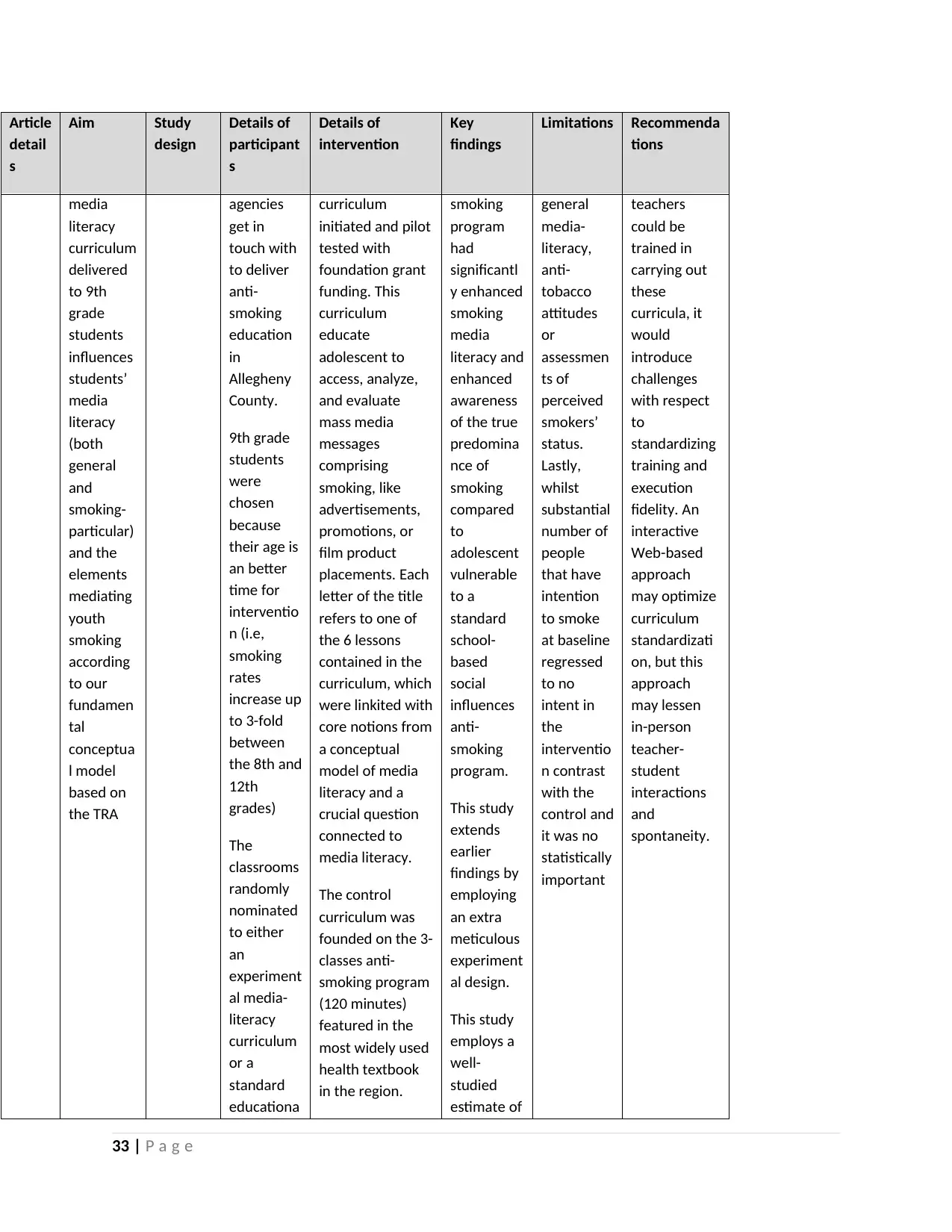
Article
detail
s
Aim Study
design
Details of
participant
s
Details of
intervention
Key
findings
Limitations Recommenda
tions
media
literacy
curriculum
delivered
to 9th
grade
students
influences
students’
media
literacy
(both
general
and
smoking-
particular)
and the
elements
mediating
youth
smoking
according
to our
fundamen
tal
conceptua
l model
based on
the TRA
agencies
get in
touch with
to deliver
anti-
smoking
education
in
Allegheny
County.
9th grade
students
were
chosen
because
their age is
an better
time for
interventio
n (i.e,
smoking
rates
increase up
to 3-fold
between
the 8th and
12th
grades)
The
classrooms
randomly
nominated
to either
an
experiment
al media-
literacy
curriculum
or a
standard
educationa
curriculum
initiated and pilot
tested with
foundation grant
funding. This
curriculum
educate
adolescent to
access, analyze,
and evaluate
mass media
messages
comprising
smoking, like
advertisements,
promotions, or
film product
placements. Each
letter of the title
refers to one of
the 6 lessons
contained in the
curriculum, which
were linkited with
core notions from
a conceptual
model of media
literacy and a
crucial question
connected to
media literacy.
The control
curriculum was
founded on the 3-
classes anti-
smoking program
(120 minutes)
featured in the
most widely used
health textbook
in the region.
smoking
program
had
significantl
y enhanced
smoking
media
literacy and
enhanced
awareness
of the true
predomina
nce of
smoking
compared
to
adolescent
vulnerable
to a
standard
school-
based
social
influences
anti-
smoking
program.
This study
extends
earlier
findings by
employing
an extra
meticulous
experiment
al design.
This study
employs a
well-
studied
estimate of
general
media-
literacy,
anti-
tobacco
attitudes
or
assessmen
ts of
perceived
smokers’
status.
Lastly,
whilst
substantial
number of
people
that have
intention
to smoke
at baseline
regressed
to no
intent in
the
interventio
n contrast
with the
control and
it was no
statistically
important
teachers
could be
trained in
carrying out
these
curricula, it
would
introduce
challenges
with respect
to
standardizing
training and
execution
fidelity. An
interactive
Web-based
approach
may optimize
curriculum
standardizati
on, but this
approach
may lessen
in-person
teacher-
student
interactions
and
spontaneity.
33 | P a g e
detail
s
Aim Study
design
Details of
participant
s
Details of
intervention
Key
findings
Limitations Recommenda
tions
media
literacy
curriculum
delivered
to 9th
grade
students
influences
students’
media
literacy
(both
general
and
smoking-
particular)
and the
elements
mediating
youth
smoking
according
to our
fundamen
tal
conceptua
l model
based on
the TRA
agencies
get in
touch with
to deliver
anti-
smoking
education
in
Allegheny
County.
9th grade
students
were
chosen
because
their age is
an better
time for
interventio
n (i.e,
smoking
rates
increase up
to 3-fold
between
the 8th and
12th
grades)
The
classrooms
randomly
nominated
to either
an
experiment
al media-
literacy
curriculum
or a
standard
educationa
curriculum
initiated and pilot
tested with
foundation grant
funding. This
curriculum
educate
adolescent to
access, analyze,
and evaluate
mass media
messages
comprising
smoking, like
advertisements,
promotions, or
film product
placements. Each
letter of the title
refers to one of
the 6 lessons
contained in the
curriculum, which
were linkited with
core notions from
a conceptual
model of media
literacy and a
crucial question
connected to
media literacy.
The control
curriculum was
founded on the 3-
classes anti-
smoking program
(120 minutes)
featured in the
most widely used
health textbook
in the region.
smoking
program
had
significantl
y enhanced
smoking
media
literacy and
enhanced
awareness
of the true
predomina
nce of
smoking
compared
to
adolescent
vulnerable
to a
standard
school-
based
social
influences
anti-
smoking
program.
This study
extends
earlier
findings by
employing
an extra
meticulous
experiment
al design.
This study
employs a
well-
studied
estimate of
general
media-
literacy,
anti-
tobacco
attitudes
or
assessmen
ts of
perceived
smokers’
status.
Lastly,
whilst
substantial
number of
people
that have
intention
to smoke
at baseline
regressed
to no
intent in
the
interventio
n contrast
with the
control and
it was no
statistically
important
teachers
could be
trained in
carrying out
these
curricula, it
would
introduce
challenges
with respect
to
standardizing
training and
execution
fidelity. An
interactive
Web-based
approach
may optimize
curriculum
standardizati
on, but this
approach
may lessen
in-person
teacher-
student
interactions
and
spontaneity.
33 | P a g e
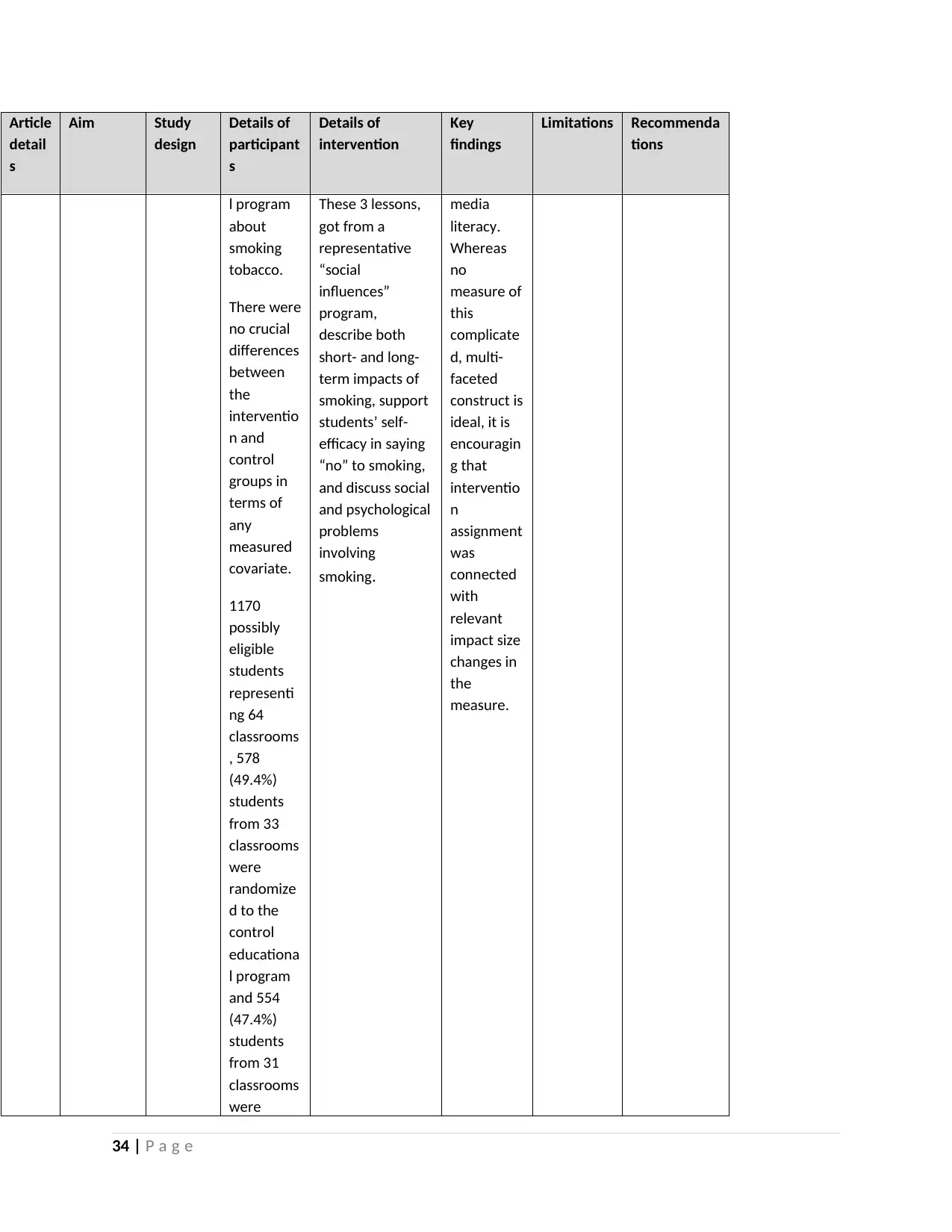
Article
detail
s
Aim Study
design
Details of
participant
s
Details of
intervention
Key
findings
Limitations Recommenda
tions
l program
about
smoking
tobacco.
There were
no crucial
differences
between
the
interventio
n and
control
groups in
terms of
any
measured
covariate.
1170
possibly
eligible
students
representi
ng 64
classrooms
, 578
(49.4%)
students
from 33
classrooms
were
randomize
d to the
control
educationa
l program
and 554
(47.4%)
students
from 31
classrooms
were
These 3 lessons,
got from a
representative
“social
influences”
program,
describe both
short- and long-
term impacts of
smoking, support
students’ self-
efficacy in saying
“no” to smoking,
and discuss social
and psychological
problems
involving
smoking.
media
literacy.
Whereas
no
measure of
this
complicate
d, multi-
faceted
construct is
ideal, it is
encouragin
g that
interventio
n
assignment
was
connected
with
relevant
impact size
changes in
the
measure.
34 | P a g e
detail
s
Aim Study
design
Details of
participant
s
Details of
intervention
Key
findings
Limitations Recommenda
tions
l program
about
smoking
tobacco.
There were
no crucial
differences
between
the
interventio
n and
control
groups in
terms of
any
measured
covariate.
1170
possibly
eligible
students
representi
ng 64
classrooms
, 578
(49.4%)
students
from 33
classrooms
were
randomize
d to the
control
educationa
l program
and 554
(47.4%)
students
from 31
classrooms
were
These 3 lessons,
got from a
representative
“social
influences”
program,
describe both
short- and long-
term impacts of
smoking, support
students’ self-
efficacy in saying
“no” to smoking,
and discuss social
and psychological
problems
involving
smoking.
media
literacy.
Whereas
no
measure of
this
complicate
d, multi-
faceted
construct is
ideal, it is
encouragin
g that
interventio
n
assignment
was
connected
with
relevant
impact size
changes in
the
measure.
34 | P a g e
Paraphrase This Document
Need a fresh take? Get an instant paraphrase of this document with our AI Paraphraser
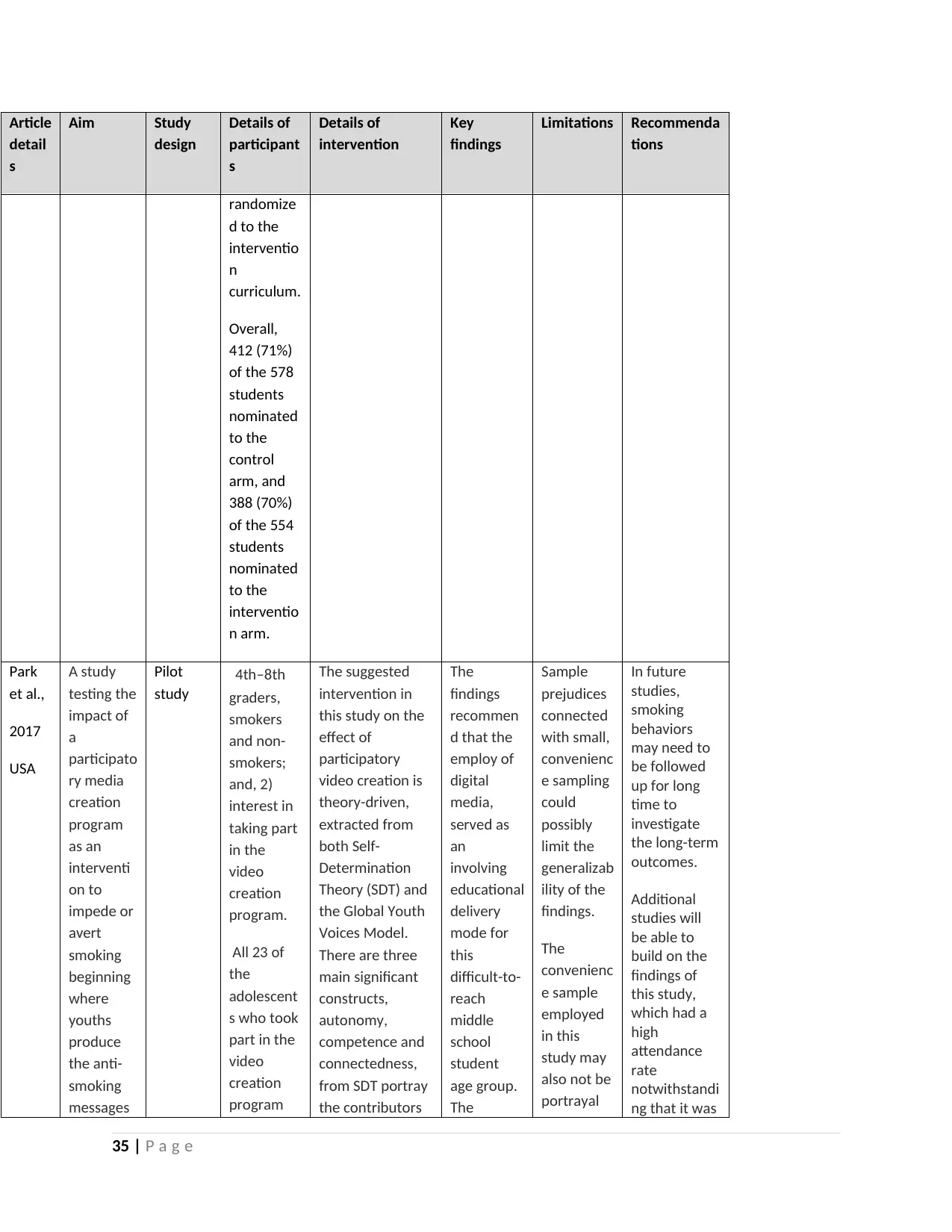
Article
detail
s
Aim Study
design
Details of
participant
s
Details of
intervention
Key
findings
Limitations Recommenda
tions
randomize
d to the
interventio
n
curriculum.
Overall,
412 (71%)
of the 578
students
nominated
to the
control
arm, and
388 (70%)
of the 554
students
nominated
to the
interventio
n arm.
Park
et al.,
2017
USA
A study
testing the
impact of
a
participato
ry media
creation
program
as an
interventi
on to
impede or
avert
smoking
beginning
where
youths
produce
the anti-
smoking
messages
Pilot
study
4th–8th
graders,
smokers
and non-
smokers;
and, 2)
interest in
taking part
in the
video
creation
program.
All 23 of
the
adolescent
s who took
part in the
video
creation
program
The suggested
intervention in
this study on the
effect of
participatory
video creation is
theory-driven,
extracted from
both Self-
Determination
Theory (SDT) and
the Global Youth
Voices Model.
There are three
main significant
constructs,
autonomy,
competence and
connectedness,
from SDT portray
the contributors
The
findings
recommen
d that the
employ of
digital
media,
served as
an
involving
educational
delivery
mode for
this
difficult-to-
reach
middle
school
student
age group.
The
Sample
prejudices
connected
with small,
convenienc
e sampling
could
possibly
limit the
generalizab
ility of the
findings.
The
convenienc
e sample
employed
in this
study may
also not be
portrayal
In future
studies,
smoking
behaviors
may need to
be followed
up for long
time to
investigate
the long-term
outcomes.
Additional
studies will
be able to
build on the
findings of
this study,
which had a
high
attendance
rate
notwithstandi
ng that it was
35 | P a g e
detail
s
Aim Study
design
Details of
participant
s
Details of
intervention
Key
findings
Limitations Recommenda
tions
randomize
d to the
interventio
n
curriculum.
Overall,
412 (71%)
of the 578
students
nominated
to the
control
arm, and
388 (70%)
of the 554
students
nominated
to the
interventio
n arm.
Park
et al.,
2017
USA
A study
testing the
impact of
a
participato
ry media
creation
program
as an
interventi
on to
impede or
avert
smoking
beginning
where
youths
produce
the anti-
smoking
messages
Pilot
study
4th–8th
graders,
smokers
and non-
smokers;
and, 2)
interest in
taking part
in the
video
creation
program.
All 23 of
the
adolescent
s who took
part in the
video
creation
program
The suggested
intervention in
this study on the
effect of
participatory
video creation is
theory-driven,
extracted from
both Self-
Determination
Theory (SDT) and
the Global Youth
Voices Model.
There are three
main significant
constructs,
autonomy,
competence and
connectedness,
from SDT portray
the contributors
The
findings
recommen
d that the
employ of
digital
media,
served as
an
involving
educational
delivery
mode for
this
difficult-to-
reach
middle
school
student
age group.
The
Sample
prejudices
connected
with small,
convenienc
e sampling
could
possibly
limit the
generalizab
ility of the
findings.
The
convenienc
e sample
employed
in this
study may
also not be
portrayal
In future
studies,
smoking
behaviors
may need to
be followed
up for long
time to
investigate
the long-term
outcomes.
Additional
studies will
be able to
build on the
findings of
this study,
which had a
high
attendance
rate
notwithstandi
ng that it was
35 | P a g e
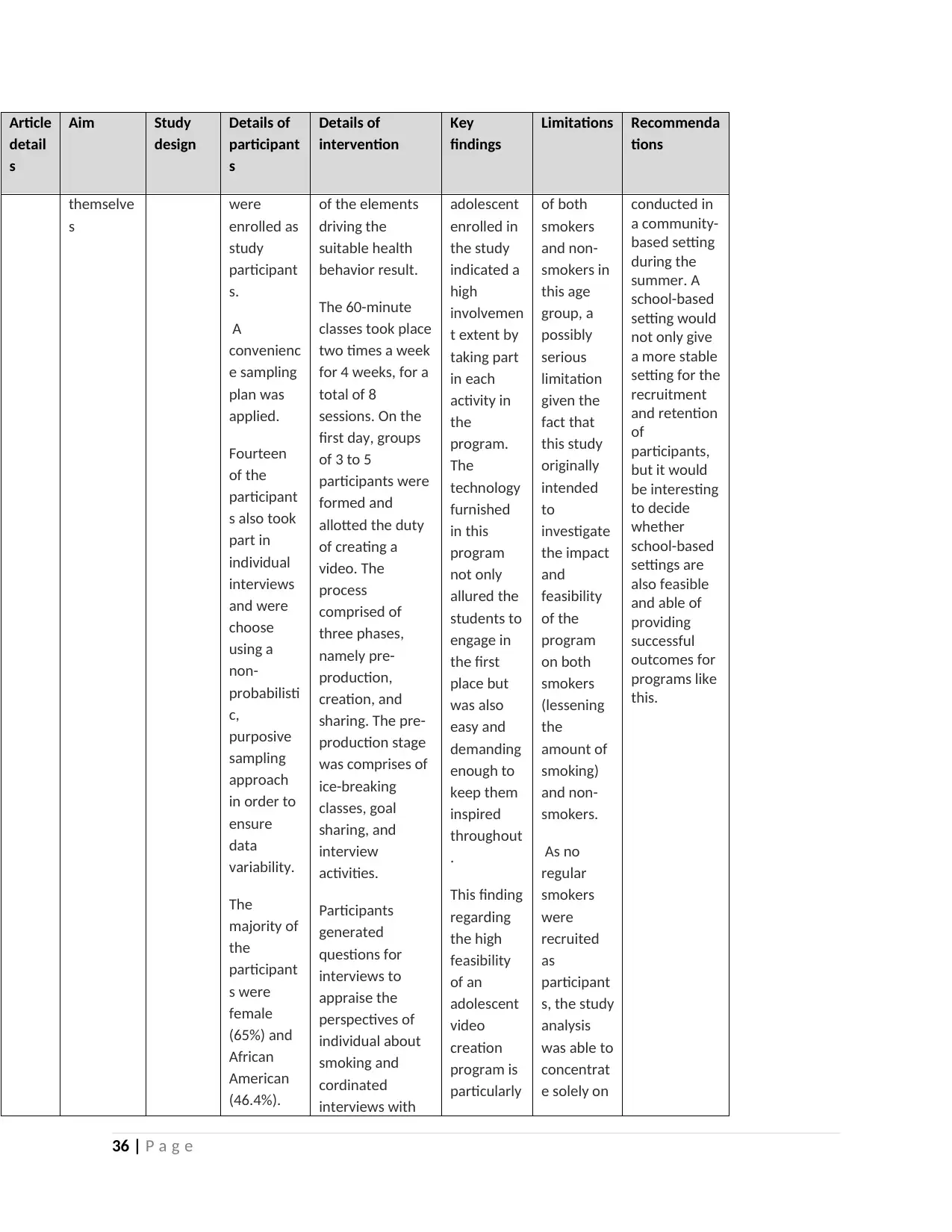
Article
detail
s
Aim Study
design
Details of
participant
s
Details of
intervention
Key
findings
Limitations Recommenda
tions
themselve
s
were
enrolled as
study
participant
s.
A
convenienc
e sampling
plan was
applied.
Fourteen
of the
participant
s also took
part in
individual
interviews
and were
choose
using a
non-
probabilisti
c,
purposive
sampling
approach
in order to
ensure
data
variability.
The
majority of
the
participant
s were
female
(65%) and
African
American
(46.4%).
of the elements
driving the
suitable health
behavior result.
The 60-minute
classes took place
two times a week
for 4 weeks, for a
total of 8
sessions. On the
first day, groups
of 3 to 5
participants were
formed and
allotted the duty
of creating a
video. The
process
comprised of
three phases,
namely pre-
production,
creation, and
sharing. The pre-
production stage
was comprises of
ice-breaking
classes, goal
sharing, and
interview
activities.
Participants
generated
questions for
interviews to
appraise the
perspectives of
individual about
smoking and
cordinated
interviews with
adolescent
enrolled in
the study
indicated a
high
involvemen
t extent by
taking part
in each
activity in
the
program.
The
technology
furnished
in this
program
not only
allured the
students to
engage in
the first
place but
was also
easy and
demanding
enough to
keep them
inspired
throughout
.
This finding
regarding
the high
feasibility
of an
adolescent
video
creation
program is
particularly
of both
smokers
and non-
smokers in
this age
group, a
possibly
serious
limitation
given the
fact that
this study
originally
intended
to
investigate
the impact
and
feasibility
of the
program
on both
smokers
(lessening
the
amount of
smoking)
and non-
smokers.
As no
regular
smokers
were
recruited
as
participant
s, the study
analysis
was able to
concentrat
e solely on
conducted in
a community-
based setting
during the
summer. A
school-based
setting would
not only give
a more stable
setting for the
recruitment
and retention
of
participants,
but it would
be interesting
to decide
whether
school-based
settings are
also feasible
and able of
providing
successful
outcomes for
programs like
this.
36 | P a g e
detail
s
Aim Study
design
Details of
participant
s
Details of
intervention
Key
findings
Limitations Recommenda
tions
themselve
s
were
enrolled as
study
participant
s.
A
convenienc
e sampling
plan was
applied.
Fourteen
of the
participant
s also took
part in
individual
interviews
and were
choose
using a
non-
probabilisti
c,
purposive
sampling
approach
in order to
ensure
data
variability.
The
majority of
the
participant
s were
female
(65%) and
African
American
(46.4%).
of the elements
driving the
suitable health
behavior result.
The 60-minute
classes took place
two times a week
for 4 weeks, for a
total of 8
sessions. On the
first day, groups
of 3 to 5
participants were
formed and
allotted the duty
of creating a
video. The
process
comprised of
three phases,
namely pre-
production,
creation, and
sharing. The pre-
production stage
was comprises of
ice-breaking
classes, goal
sharing, and
interview
activities.
Participants
generated
questions for
interviews to
appraise the
perspectives of
individual about
smoking and
cordinated
interviews with
adolescent
enrolled in
the study
indicated a
high
involvemen
t extent by
taking part
in each
activity in
the
program.
The
technology
furnished
in this
program
not only
allured the
students to
engage in
the first
place but
was also
easy and
demanding
enough to
keep them
inspired
throughout
.
This finding
regarding
the high
feasibility
of an
adolescent
video
creation
program is
particularly
of both
smokers
and non-
smokers in
this age
group, a
possibly
serious
limitation
given the
fact that
this study
originally
intended
to
investigate
the impact
and
feasibility
of the
program
on both
smokers
(lessening
the
amount of
smoking)
and non-
smokers.
As no
regular
smokers
were
recruited
as
participant
s, the study
analysis
was able to
concentrat
e solely on
conducted in
a community-
based setting
during the
summer. A
school-based
setting would
not only give
a more stable
setting for the
recruitment
and retention
of
participants,
but it would
be interesting
to decide
whether
school-based
settings are
also feasible
and able of
providing
successful
outcomes for
programs like
this.
36 | P a g e
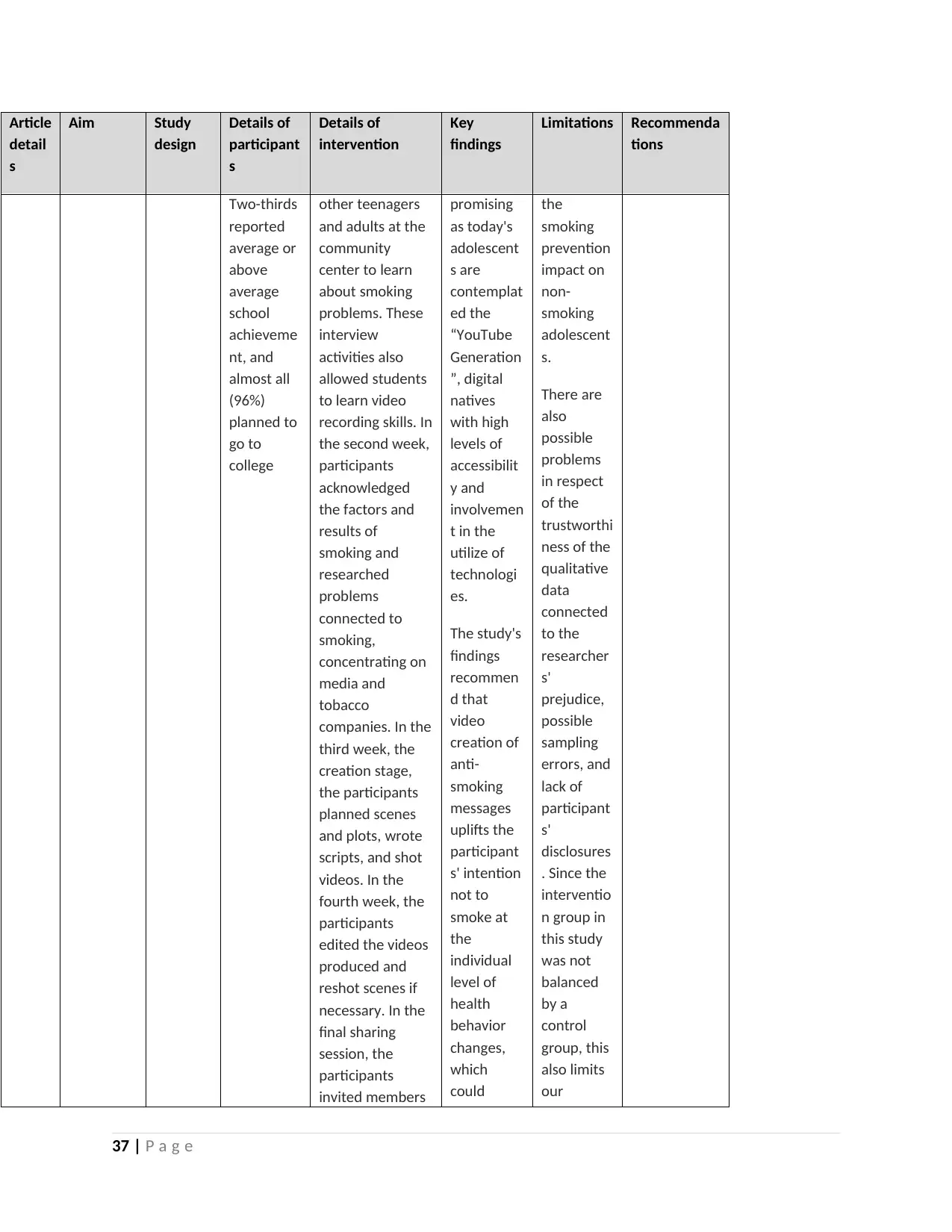
Article
detail
s
Aim Study
design
Details of
participant
s
Details of
intervention
Key
findings
Limitations Recommenda
tions
Two-thirds
reported
average or
above
average
school
achieveme
nt, and
almost all
(96%)
planned to
go to
college
other teenagers
and adults at the
community
center to learn
about smoking
problems. These
interview
activities also
allowed students
to learn video
recording skills. In
the second week,
participants
acknowledged
the factors and
results of
smoking and
researched
problems
connected to
smoking,
concentrating on
media and
tobacco
companies. In the
third week, the
creation stage,
the participants
planned scenes
and plots, wrote
scripts, and shot
videos. In the
fourth week, the
participants
edited the videos
produced and
reshot scenes if
necessary. In the
final sharing
session, the
participants
invited members
promising
as today's
adolescent
s are
contemplat
ed the
“YouTube
Generation
”, digital
natives
with high
levels of
accessibilit
y and
involvemen
t in the
utilize of
technologi
es.
The study's
findings
recommen
d that
video
creation of
anti-
smoking
messages
uplifts the
participant
s' intention
not to
smoke at
the
individual
level of
health
behavior
changes,
which
could
the
smoking
prevention
impact on
non-
smoking
adolescent
s.
There are
also
possible
problems
in respect
of the
trustworthi
ness of the
qualitative
data
connected
to the
researcher
s'
prejudice,
possible
sampling
errors, and
lack of
participant
s'
disclosures
. Since the
interventio
n group in
this study
was not
balanced
by a
control
group, this
also limits
our
37 | P a g e
detail
s
Aim Study
design
Details of
participant
s
Details of
intervention
Key
findings
Limitations Recommenda
tions
Two-thirds
reported
average or
above
average
school
achieveme
nt, and
almost all
(96%)
planned to
go to
college
other teenagers
and adults at the
community
center to learn
about smoking
problems. These
interview
activities also
allowed students
to learn video
recording skills. In
the second week,
participants
acknowledged
the factors and
results of
smoking and
researched
problems
connected to
smoking,
concentrating on
media and
tobacco
companies. In the
third week, the
creation stage,
the participants
planned scenes
and plots, wrote
scripts, and shot
videos. In the
fourth week, the
participants
edited the videos
produced and
reshot scenes if
necessary. In the
final sharing
session, the
participants
invited members
promising
as today's
adolescent
s are
contemplat
ed the
“YouTube
Generation
”, digital
natives
with high
levels of
accessibilit
y and
involvemen
t in the
utilize of
technologi
es.
The study's
findings
recommen
d that
video
creation of
anti-
smoking
messages
uplifts the
participant
s' intention
not to
smoke at
the
individual
level of
health
behavior
changes,
which
could
the
smoking
prevention
impact on
non-
smoking
adolescent
s.
There are
also
possible
problems
in respect
of the
trustworthi
ness of the
qualitative
data
connected
to the
researcher
s'
prejudice,
possible
sampling
errors, and
lack of
participant
s'
disclosures
. Since the
interventio
n group in
this study
was not
balanced
by a
control
group, this
also limits
our
37 | P a g e
Secure Best Marks with AI Grader
Need help grading? Try our AI Grader for instant feedback on your assignments.
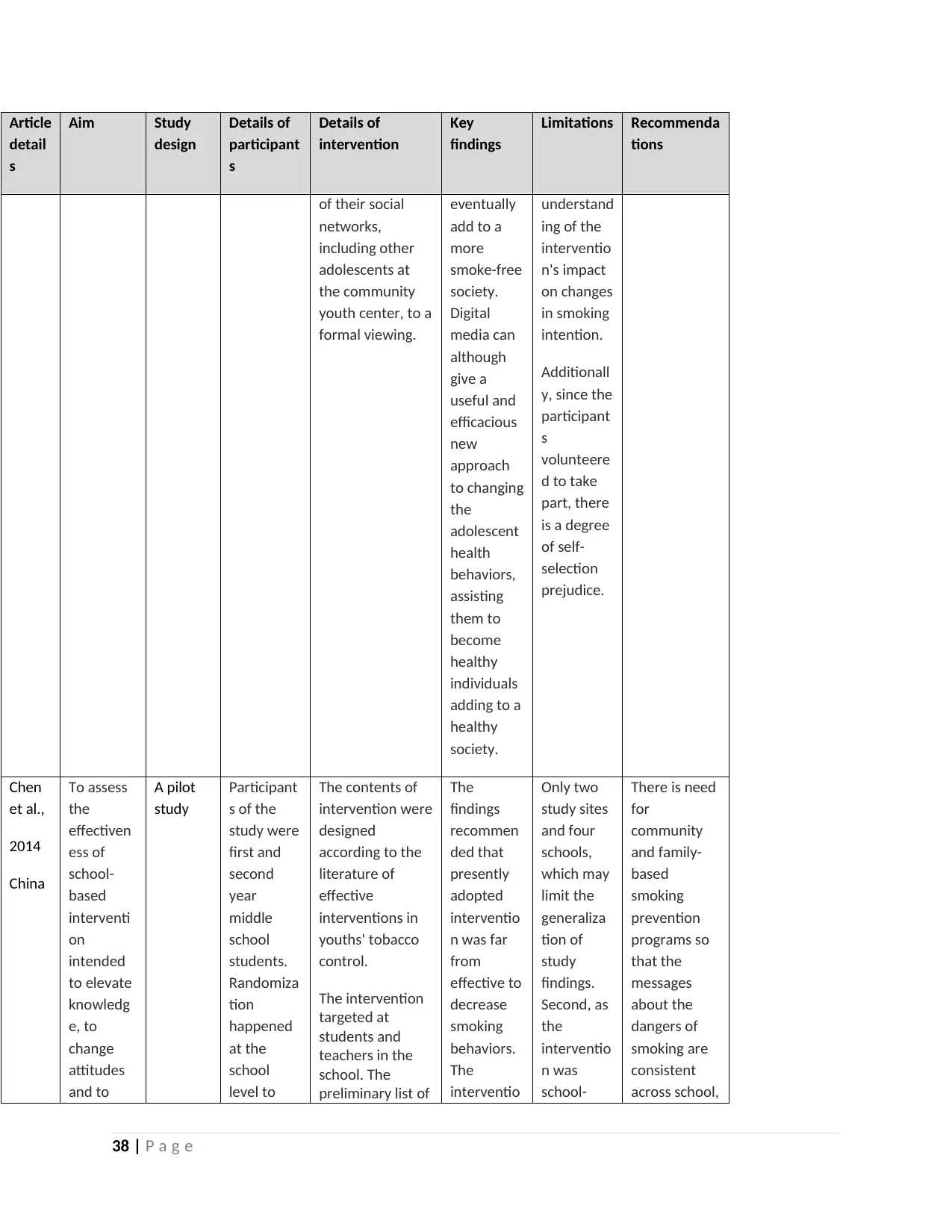
Article
detail
s
Aim Study
design
Details of
participant
s
Details of
intervention
Key
findings
Limitations Recommenda
tions
of their social
networks,
including other
adolescents at
the community
youth center, to a
formal viewing.
eventually
add to a
more
smoke-free
society.
Digital
media can
although
give a
useful and
efficacious
new
approach
to changing
the
adolescent
health
behaviors,
assisting
them to
become
healthy
individuals
adding to a
healthy
society.
understand
ing of the
interventio
n's impact
on changes
in smoking
intention.
Additionall
y, since the
participant
s
volunteere
d to take
part, there
is a degree
of self-
selection
prejudice.
Chen
et al.,
2014
China
To assess
the
effectiven
ess of
school-
based
interventi
on
intended
to elevate
knowledg
e, to
change
attitudes
and to
A pilot
study
Participant
s of the
study were
first and
second
year
middle
school
students.
Randomiza
tion
happened
at the
school
level to
The contents of
intervention were
designed
according to the
literature of
effective
interventions in
youths' tobacco
control.
The intervention
targeted at
students and
teachers in the
school. The
preliminary list of
The
findings
recommen
ded that
presently
adopted
interventio
n was far
from
effective to
decrease
smoking
behaviors.
The
interventio
Only two
study sites
and four
schools,
which may
limit the
generaliza
tion of
study
findings.
Second, as
the
interventio
n was
school-
There is need
for
community
and family-
based
smoking
prevention
programs so
that the
messages
about the
dangers of
smoking are
consistent
across school,
38 | P a g e
detail
s
Aim Study
design
Details of
participant
s
Details of
intervention
Key
findings
Limitations Recommenda
tions
of their social
networks,
including other
adolescents at
the community
youth center, to a
formal viewing.
eventually
add to a
more
smoke-free
society.
Digital
media can
although
give a
useful and
efficacious
new
approach
to changing
the
adolescent
health
behaviors,
assisting
them to
become
healthy
individuals
adding to a
healthy
society.
understand
ing of the
interventio
n's impact
on changes
in smoking
intention.
Additionall
y, since the
participant
s
volunteere
d to take
part, there
is a degree
of self-
selection
prejudice.
Chen
et al.,
2014
China
To assess
the
effectiven
ess of
school-
based
interventi
on
intended
to elevate
knowledg
e, to
change
attitudes
and to
A pilot
study
Participant
s of the
study were
first and
second
year
middle
school
students.
Randomiza
tion
happened
at the
school
level to
The contents of
intervention were
designed
according to the
literature of
effective
interventions in
youths' tobacco
control.
The intervention
targeted at
students and
teachers in the
school. The
preliminary list of
The
findings
recommen
ded that
presently
adopted
interventio
n was far
from
effective to
decrease
smoking
behaviors.
The
interventio
Only two
study sites
and four
schools,
which may
limit the
generaliza
tion of
study
findings.
Second, as
the
interventio
n was
school-
There is need
for
community
and family-
based
smoking
prevention
programs so
that the
messages
about the
dangers of
smoking are
consistent
across school,
38 | P a g e
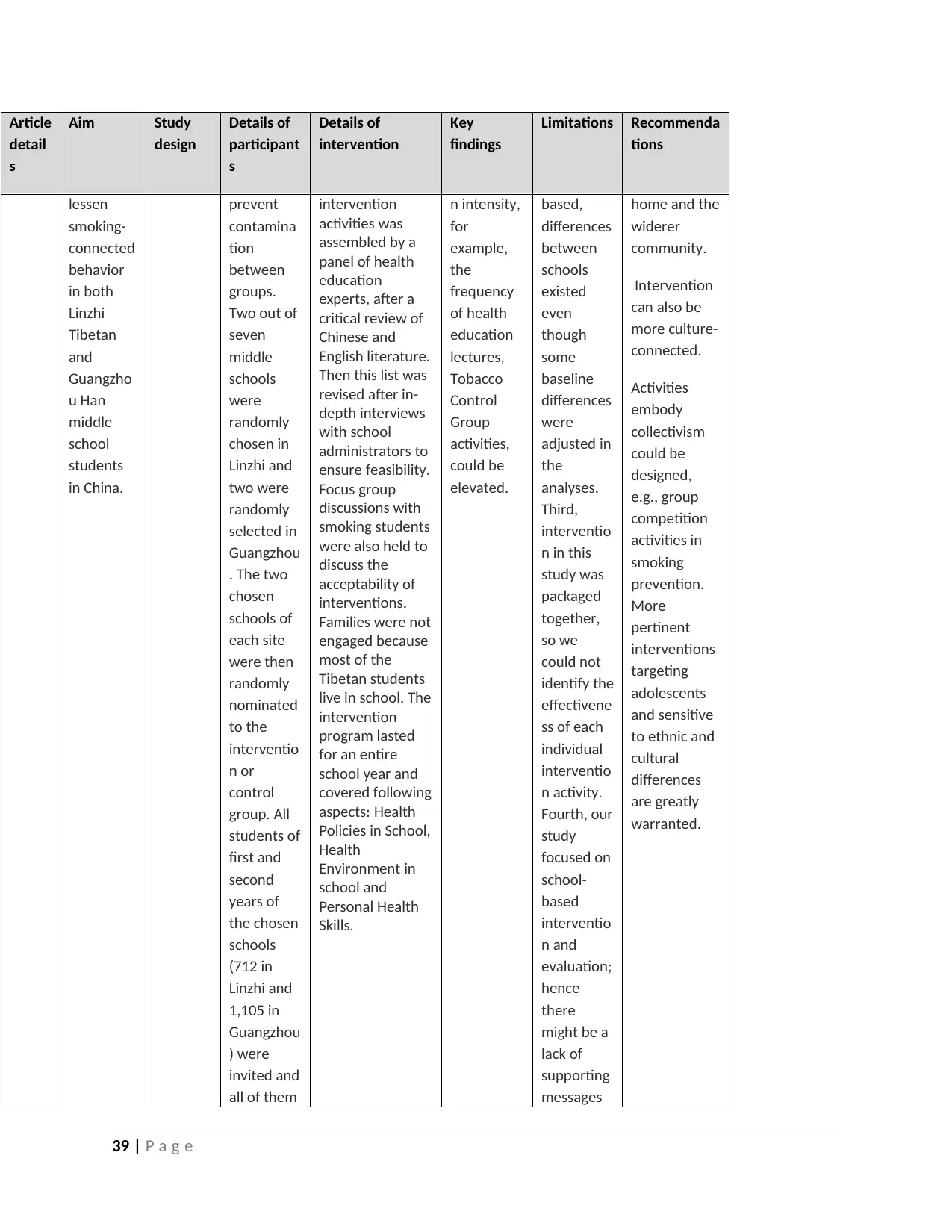
Article
detail
s
Aim Study
design
Details of
participant
s
Details of
intervention
Key
findings
Limitations Recommenda
tions
lessen
smoking-
connected
behavior
in both
Linzhi
Tibetan
and
Guangzho
u Han
middle
school
students
in China.
prevent
contamina
tion
between
groups.
Two out of
seven
middle
schools
were
randomly
chosen in
Linzhi and
two were
randomly
selected in
Guangzhou
. The two
chosen
schools of
each site
were then
randomly
nominated
to the
interventio
n or
control
group. All
students of
first and
second
years of
the chosen
schools
(712 in
Linzhi and
1,105 in
Guangzhou
) were
invited and
all of them
intervention
activities was
assembled by a
panel of health
education
experts, after a
critical review of
Chinese and
English literature.
Then this list was
revised after in-
depth interviews
with school
administrators to
ensure feasibility.
Focus group
discussions with
smoking students
were also held to
discuss the
acceptability of
interventions.
Families were not
engaged because
most of the
Tibetan students
live in school. The
intervention
program lasted
for an entire
school year and
covered following
aspects: Health
Policies in School,
Health
Environment in
school and
Personal Health
Skills.
n intensity,
for
example,
the
frequency
of health
education
lectures,
Tobacco
Control
Group
activities,
could be
elevated.
based,
differences
between
schools
existed
even
though
some
baseline
differences
were
adjusted in
the
analyses.
Third,
interventio
n in this
study was
packaged
together,
so we
could not
identify the
effectivene
ss of each
individual
interventio
n activity.
Fourth, our
study
focused on
school-
based
interventio
n and
evaluation;
hence
there
might be a
lack of
supporting
messages
home and the
widerer
community.
Intervention
can also be
more culture-
connected.
Activities
embody
collectivism
could be
designed,
e.g., group
competition
activities in
smoking
prevention.
More
pertinent
interventions
targeting
adolescents
and sensitive
to ethnic and
cultural
differences
are greatly
warranted.
39 | P a g e
detail
s
Aim Study
design
Details of
participant
s
Details of
intervention
Key
findings
Limitations Recommenda
tions
lessen
smoking-
connected
behavior
in both
Linzhi
Tibetan
and
Guangzho
u Han
middle
school
students
in China.
prevent
contamina
tion
between
groups.
Two out of
seven
middle
schools
were
randomly
chosen in
Linzhi and
two were
randomly
selected in
Guangzhou
. The two
chosen
schools of
each site
were then
randomly
nominated
to the
interventio
n or
control
group. All
students of
first and
second
years of
the chosen
schools
(712 in
Linzhi and
1,105 in
Guangzhou
) were
invited and
all of them
intervention
activities was
assembled by a
panel of health
education
experts, after a
critical review of
Chinese and
English literature.
Then this list was
revised after in-
depth interviews
with school
administrators to
ensure feasibility.
Focus group
discussions with
smoking students
were also held to
discuss the
acceptability of
interventions.
Families were not
engaged because
most of the
Tibetan students
live in school. The
intervention
program lasted
for an entire
school year and
covered following
aspects: Health
Policies in School,
Health
Environment in
school and
Personal Health
Skills.
n intensity,
for
example,
the
frequency
of health
education
lectures,
Tobacco
Control
Group
activities,
could be
elevated.
based,
differences
between
schools
existed
even
though
some
baseline
differences
were
adjusted in
the
analyses.
Third,
interventio
n in this
study was
packaged
together,
so we
could not
identify the
effectivene
ss of each
individual
interventio
n activity.
Fourth, our
study
focused on
school-
based
interventio
n and
evaluation;
hence
there
might be a
lack of
supporting
messages
home and the
widerer
community.
Intervention
can also be
more culture-
connected.
Activities
embody
collectivism
could be
designed,
e.g., group
competition
activities in
smoking
prevention.
More
pertinent
interventions
targeting
adolescents
and sensitive
to ethnic and
cultural
differences
are greatly
warranted.
39 | P a g e
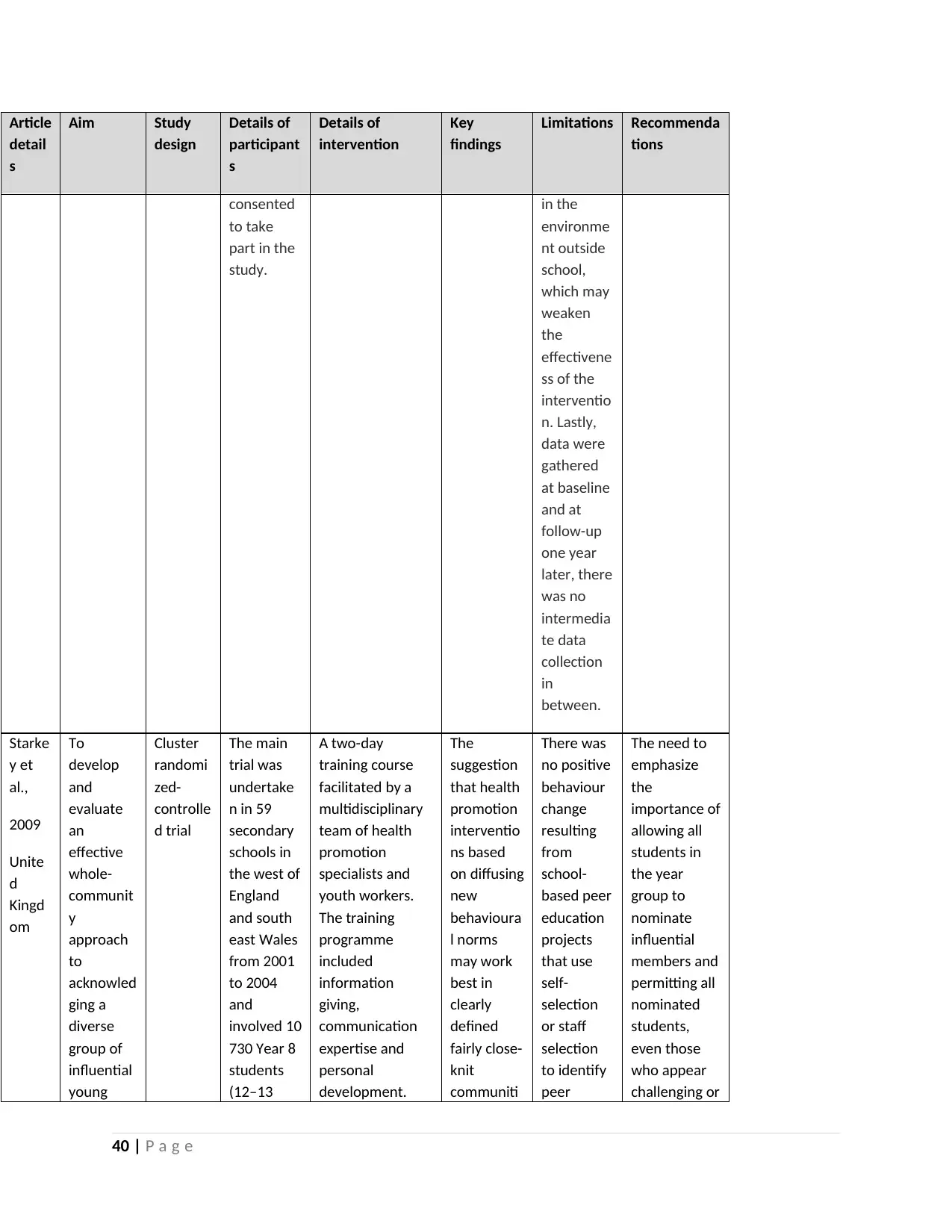
Article
detail
s
Aim Study
design
Details of
participant
s
Details of
intervention
Key
findings
Limitations Recommenda
tions
consented
to take
part in the
study.
in the
environme
nt outside
school,
which may
weaken
the
effectivene
ss of the
interventio
n. Lastly,
data were
gathered
at baseline
and at
follow-up
one year
later, there
was no
intermedia
te data
collection
in
between.
Starke
y et
al.,
2009
Unite
d
Kingd
om
To
develop
and
evaluate
an
effective
whole-
communit
y
approach
to
acknowled
ging a
diverse
group of
influential
young
Cluster
randomi
zed-
controlle
d trial
The main
trial was
undertake
n in 59
secondary
schools in
the west of
England
and south
east Wales
from 2001
to 2004
and
involved 10
730 Year 8
students
(12–13
A two-day
training course
facilitated by a
multidisciplinary
team of health
promotion
specialists and
youth workers.
The training
programme
included
information
giving,
communication
expertise and
personal
development.
The
suggestion
that health
promotion
interventio
ns based
on diffusing
new
behavioura
l norms
may work
best in
clearly
defined
fairly close-
knit
communiti
There was
no positive
behaviour
change
resulting
from
school-
based peer
education
projects
that use
self-
selection
or staff
selection
to identify
peer
The need to
emphasize
the
importance of
allowing all
students in
the year
group to
nominate
influential
members and
permitting all
nominated
students,
even those
who appear
challenging or
40 | P a g e
detail
s
Aim Study
design
Details of
participant
s
Details of
intervention
Key
findings
Limitations Recommenda
tions
consented
to take
part in the
study.
in the
environme
nt outside
school,
which may
weaken
the
effectivene
ss of the
interventio
n. Lastly,
data were
gathered
at baseline
and at
follow-up
one year
later, there
was no
intermedia
te data
collection
in
between.
Starke
y et
al.,
2009
Unite
d
Kingd
om
To
develop
and
evaluate
an
effective
whole-
communit
y
approach
to
acknowled
ging a
diverse
group of
influential
young
Cluster
randomi
zed-
controlle
d trial
The main
trial was
undertake
n in 59
secondary
schools in
the west of
England
and south
east Wales
from 2001
to 2004
and
involved 10
730 Year 8
students
(12–13
A two-day
training course
facilitated by a
multidisciplinary
team of health
promotion
specialists and
youth workers.
The training
programme
included
information
giving,
communication
expertise and
personal
development.
The
suggestion
that health
promotion
interventio
ns based
on diffusing
new
behavioura
l norms
may work
best in
clearly
defined
fairly close-
knit
communiti
There was
no positive
behaviour
change
resulting
from
school-
based peer
education
projects
that use
self-
selection
or staff
selection
to identify
peer
The need to
emphasize
the
importance of
allowing all
students in
the year
group to
nominate
influential
members and
permitting all
nominated
students,
even those
who appear
challenging or
40 | P a g e
Paraphrase This Document
Need a fresh take? Get an instant paraphrase of this document with our AI Paraphraser

Article
detail
s
Aim Study
design
Details of
participant
s
Details of
intervention
Key
findings
Limitations Recommenda
tions
people to
effectively
diffuse
health
promotion
messages
among
their
peers.
years old)
at baseline.
A range of
schools
was
represente
d including
the
following:
independe
nt and
state,
Welsh
language
and English
speaking,
non-
denominati
onal and
faith
schools,
mixed and
single-sex,
different-
sized
student
population
s and
varying
levels of
free school
meal
entitlemen
t.
Those in
the control
group (n =
29 schools,
5372
students)
were asked
Bearing in mind
the range of
young people,
and their
eventual role as
peer supporters,
most of the
activities were
concentrated on
oral instead of
written
communication
skills.
During the
following 10
weeks, the peer
supporters were
asked to have
informal
conversations
with other Year 8
students in their
school to
persuade them
not to smoke and
to record brief
details of these
conversations in a
simple diary. Four
follow up classes
were undertaken
in each school
during the 10-
week period, at
which the
trainers offered
support and
monitored the
peer supporters’
progress.
es, where
peer
supporters
are in
regular
contact
with
members
of a more
clearly
defined
and stable
community
.
Carefully
designed
and
developed
peer-led
interventi
ons like
that
employed
by ASSIST
have
potential
for
delivering
efficacious
smoking
preventio
n among
youths.
educators. disaffected,
to be trained
as peer
supporters.
An evaluation
of the wider
Odds ratios
from ASSIST
multi-level
model.
Reprinted
from
Campbell et
al. F. Starkey
et al. 986
execution of
the ASSIST
intervention
is planned,
with fidelity
of execution a
significant
attribute.
Social
network
analysis
recommends
that the
ASSIST peer
nomination
approach
identified
peer leaders
from various
clusters
within the
year group.
This complies
with
suggestions
that opinion
41 | P a g e
detail
s
Aim Study
design
Details of
participant
s
Details of
intervention
Key
findings
Limitations Recommenda
tions
people to
effectively
diffuse
health
promotion
messages
among
their
peers.
years old)
at baseline.
A range of
schools
was
represente
d including
the
following:
independe
nt and
state,
Welsh
language
and English
speaking,
non-
denominati
onal and
faith
schools,
mixed and
single-sex,
different-
sized
student
population
s and
varying
levels of
free school
meal
entitlemen
t.
Those in
the control
group (n =
29 schools,
5372
students)
were asked
Bearing in mind
the range of
young people,
and their
eventual role as
peer supporters,
most of the
activities were
concentrated on
oral instead of
written
communication
skills.
During the
following 10
weeks, the peer
supporters were
asked to have
informal
conversations
with other Year 8
students in their
school to
persuade them
not to smoke and
to record brief
details of these
conversations in a
simple diary. Four
follow up classes
were undertaken
in each school
during the 10-
week period, at
which the
trainers offered
support and
monitored the
peer supporters’
progress.
es, where
peer
supporters
are in
regular
contact
with
members
of a more
clearly
defined
and stable
community
.
Carefully
designed
and
developed
peer-led
interventi
ons like
that
employed
by ASSIST
have
potential
for
delivering
efficacious
smoking
preventio
n among
youths.
educators. disaffected,
to be trained
as peer
supporters.
An evaluation
of the wider
Odds ratios
from ASSIST
multi-level
model.
Reprinted
from
Campbell et
al. F. Starkey
et al. 986
execution of
the ASSIST
intervention
is planned,
with fidelity
of execution a
significant
attribute.
Social
network
analysis
recommends
that the
ASSIST peer
nomination
approach
identified
peer leaders
from various
clusters
within the
year group.
This complies
with
suggestions
that opinion
41 | P a g e
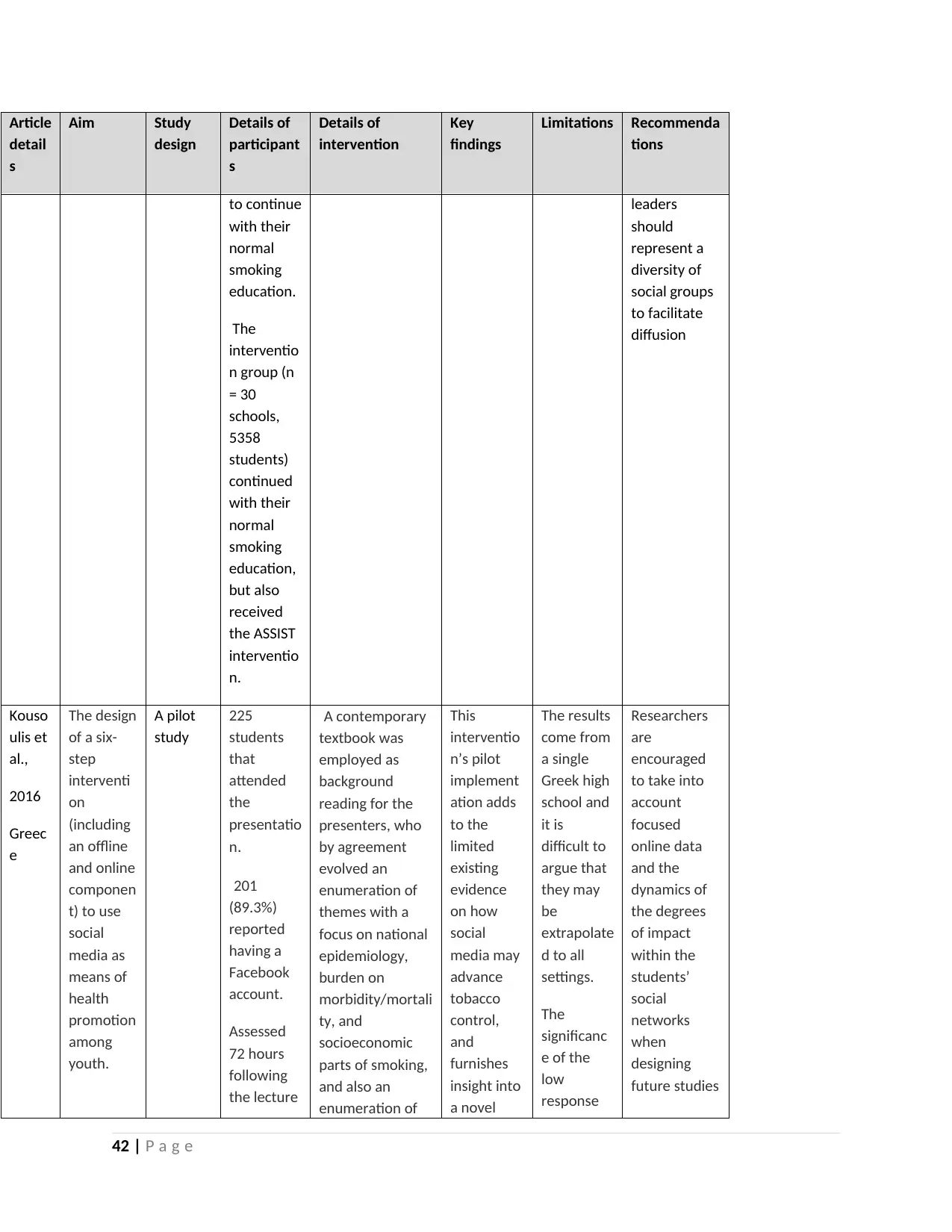
Article
detail
s
Aim Study
design
Details of
participant
s
Details of
intervention
Key
findings
Limitations Recommenda
tions
to continue
with their
normal
smoking
education.
The
interventio
n group (n
= 30
schools,
5358
students)
continued
with their
normal
smoking
education,
but also
received
the ASSIST
interventio
n.
leaders
should
represent a
diversity of
social groups
to facilitate
diffusion
Kouso
ulis et
al.,
2016
Greec
e
The design
of a six-
step
interventi
on
(including
an offline
and online
componen
t) to use
social
media as
means of
health
promotion
among
youth.
A pilot
study
225
students
that
attended
the
presentatio
n.
201
(89.3%)
reported
having a
Facebook
account.
Assessed
72 hours
following
the lecture
A contemporary
textbook was
employed as
background
reading for the
presenters, who
by agreement
evolved an
enumeration of
themes with a
focus on national
epidemiology,
burden on
morbidity/mortali
ty, and
socioeconomic
parts of smoking,
and also an
enumeration of
This
interventio
n’s pilot
implement
ation adds
to the
limited
existing
evidence
on how
social
media may
advance
tobacco
control,
and
furnishes
insight into
a novel
The results
come from
a single
Greek high
school and
it is
difficult to
argue that
they may
be
extrapolate
d to all
settings.
The
significanc
e of the
low
response
Researchers
are
encouraged
to take into
account
focused
online data
and the
dynamics of
the degrees
of impact
within the
students’
social
networks
when
designing
future studies
42 | P a g e
detail
s
Aim Study
design
Details of
participant
s
Details of
intervention
Key
findings
Limitations Recommenda
tions
to continue
with their
normal
smoking
education.
The
interventio
n group (n
= 30
schools,
5358
students)
continued
with their
normal
smoking
education,
but also
received
the ASSIST
interventio
n.
leaders
should
represent a
diversity of
social groups
to facilitate
diffusion
Kouso
ulis et
al.,
2016
Greec
e
The design
of a six-
step
interventi
on
(including
an offline
and online
componen
t) to use
social
media as
means of
health
promotion
among
youth.
A pilot
study
225
students
that
attended
the
presentatio
n.
201
(89.3%)
reported
having a
account.
Assessed
72 hours
following
the lecture
A contemporary
textbook was
employed as
background
reading for the
presenters, who
by agreement
evolved an
enumeration of
themes with a
focus on national
epidemiology,
burden on
morbidity/mortali
ty, and
socioeconomic
parts of smoking,
and also an
enumeration of
This
interventio
n’s pilot
implement
ation adds
to the
limited
existing
evidence
on how
social
media may
advance
tobacco
control,
and
furnishes
insight into
a novel
The results
come from
a single
Greek high
school and
it is
difficult to
argue that
they may
be
extrapolate
d to all
settings.
The
significanc
e of the
low
response
Researchers
are
encouraged
to take into
account
focused
online data
and the
dynamics of
the degrees
of impact
within the
students’
social
networks
when
designing
future studies
42 | P a g e
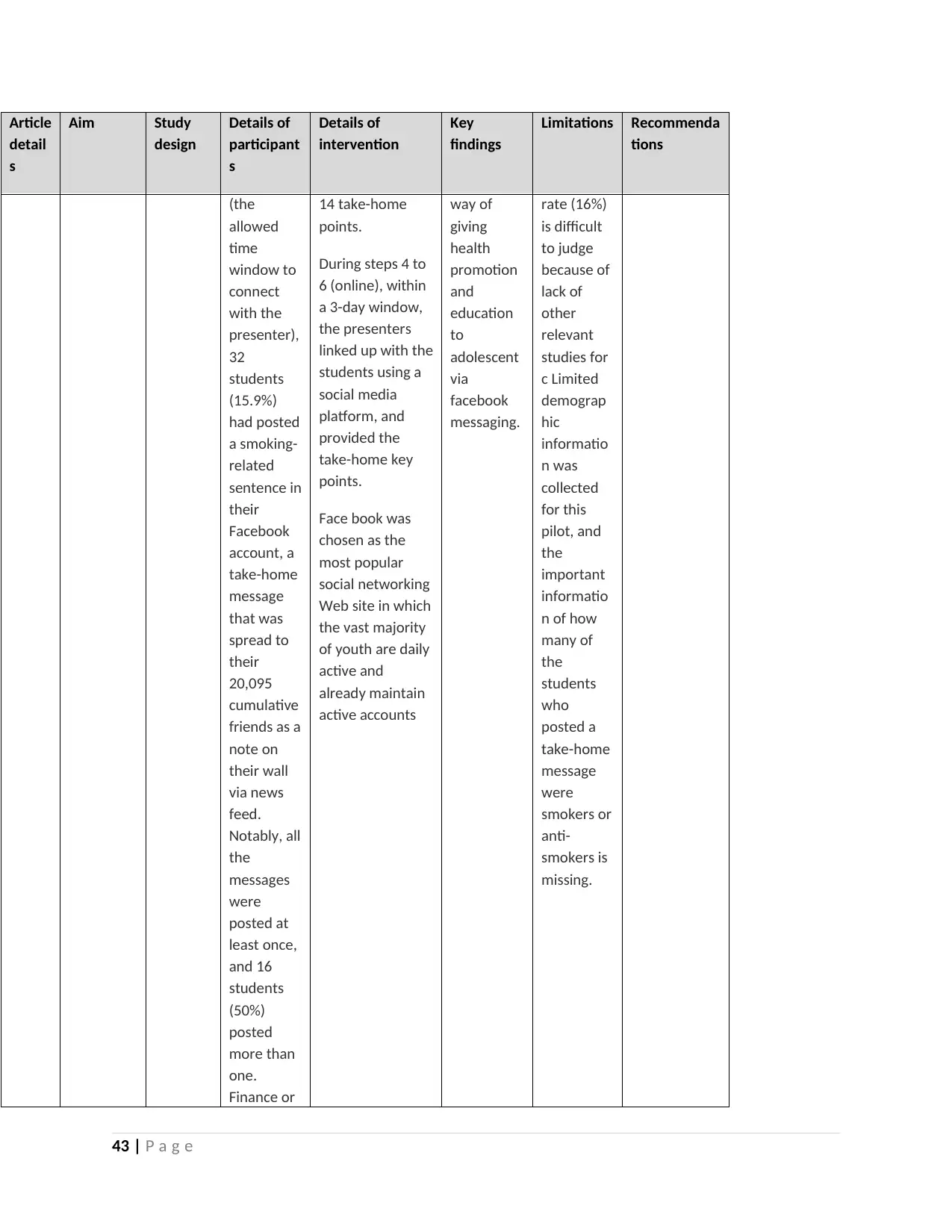
Article
detail
s
Aim Study
design
Details of
participant
s
Details of
intervention
Key
findings
Limitations Recommenda
tions
(the
allowed
time
window to
connect
with the
presenter),
32
students
(15.9%)
had posted
a smoking-
related
sentence in
their
Facebook
account, a
take-home
message
that was
spread to
their
20,095
cumulative
friends as a
note on
their wall
via news
feed.
Notably, all
the
messages
were
posted at
least once,
and 16
students
(50%)
posted
more than
one.
Finance or
14 take-home
points.
During steps 4 to
6 (online), within
a 3-day window,
the presenters
linked up with the
students using a
social media
platform, and
provided the
take-home key
points.
Face book was
chosen as the
most popular
social networking
Web site in which
the vast majority
of youth are daily
active and
already maintain
active accounts
way of
giving
health
promotion
and
education
to
adolescent
via
facebook
messaging.
rate (16%)
is difficult
to judge
because of
lack of
other
relevant
studies for
c Limited
demograp
hic
informatio
n was
collected
for this
pilot, and
the
important
informatio
n of how
many of
the
students
who
posted a
take-home
message
were
smokers or
anti-
smokers is
missing.
43 | P a g e
detail
s
Aim Study
design
Details of
participant
s
Details of
intervention
Key
findings
Limitations Recommenda
tions
(the
allowed
time
window to
connect
with the
presenter),
32
students
(15.9%)
had posted
a smoking-
related
sentence in
their
account, a
take-home
message
that was
spread to
their
20,095
cumulative
friends as a
note on
their wall
via news
feed.
Notably, all
the
messages
were
posted at
least once,
and 16
students
(50%)
posted
more than
one.
Finance or
14 take-home
points.
During steps 4 to
6 (online), within
a 3-day window,
the presenters
linked up with the
students using a
social media
platform, and
provided the
take-home key
points.
Face book was
chosen as the
most popular
social networking
Web site in which
the vast majority
of youth are daily
active and
already maintain
active accounts
way of
giving
health
promotion
and
education
to
adolescent
via
messaging.
rate (16%)
is difficult
to judge
because of
lack of
other
relevant
studies for
c Limited
demograp
hic
informatio
n was
collected
for this
pilot, and
the
important
informatio
n of how
many of
the
students
who
posted a
take-home
message
were
smokers or
anti-
smokers is
missing.
43 | P a g e
Secure Best Marks with AI Grader
Need help grading? Try our AI Grader for instant feedback on your assignments.
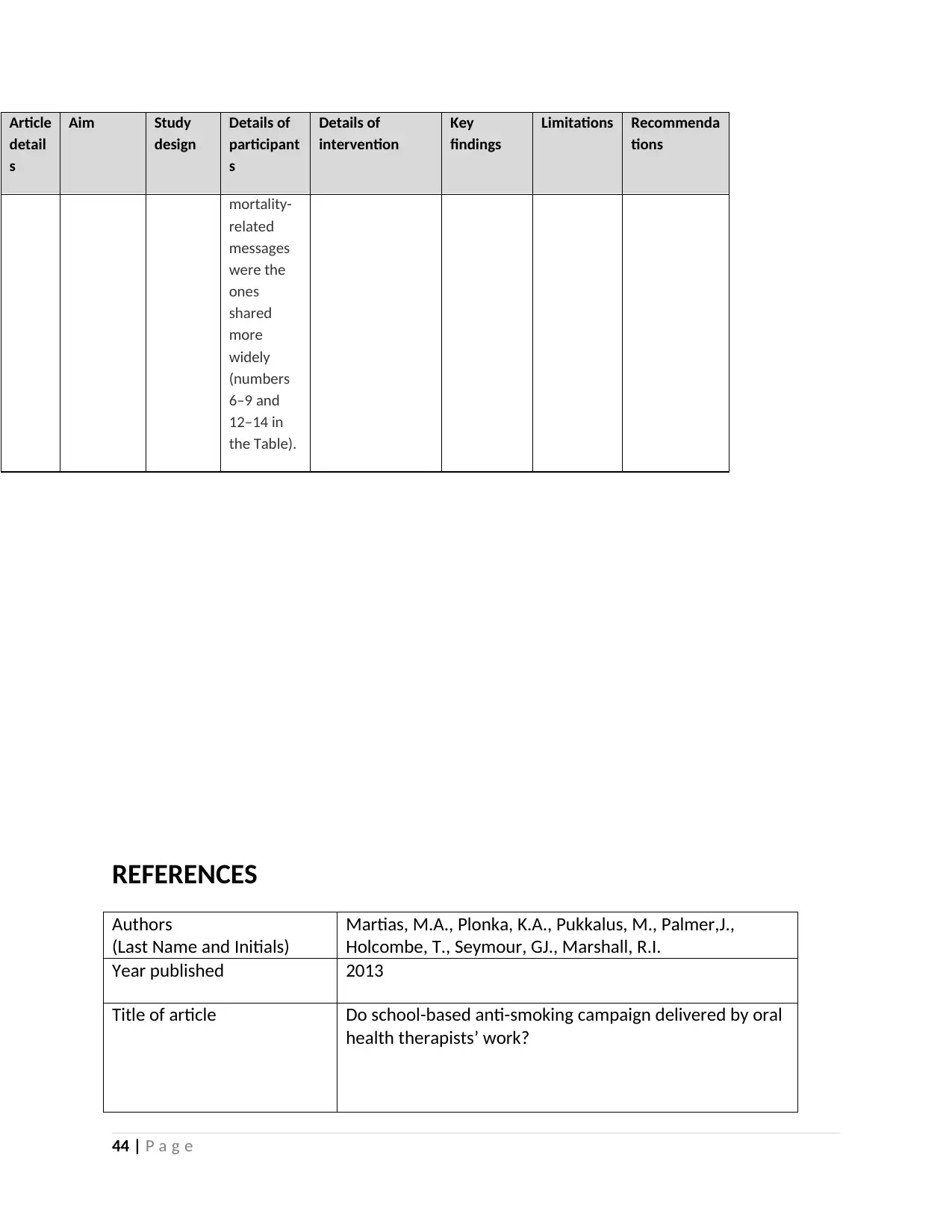
Article
detail
s
Aim Study
design
Details of
participant
s
Details of
intervention
Key
findings
Limitations Recommenda
tions
mortality-
related
messages
were the
ones
shared
more
widely
(numbers
6–9 and
12–14 in
the Table).
REFERENCES
Authors
(Last Name and Initials)
Martias, M.A., Plonka, K.A., Pukkalus, M., Palmer,J.,
Holcombe, T., Seymour, GJ., Marshall, R.I.
Year published 2013
Title of article Do school-based anti-smoking campaign delivered by oral
health therapists’ work?
44 | P a g e
detail
s
Aim Study
design
Details of
participant
s
Details of
intervention
Key
findings
Limitations Recommenda
tions
mortality-
related
messages
were the
ones
shared
more
widely
(numbers
6–9 and
12–14 in
the Table).
REFERENCES
Authors
(Last Name and Initials)
Martias, M.A., Plonka, K.A., Pukkalus, M., Palmer,J.,
Holcombe, T., Seymour, GJ., Marshall, R.I.
Year published 2013
Title of article Do school-based anti-smoking campaign delivered by oral
health therapists’ work?
44 | P a g e
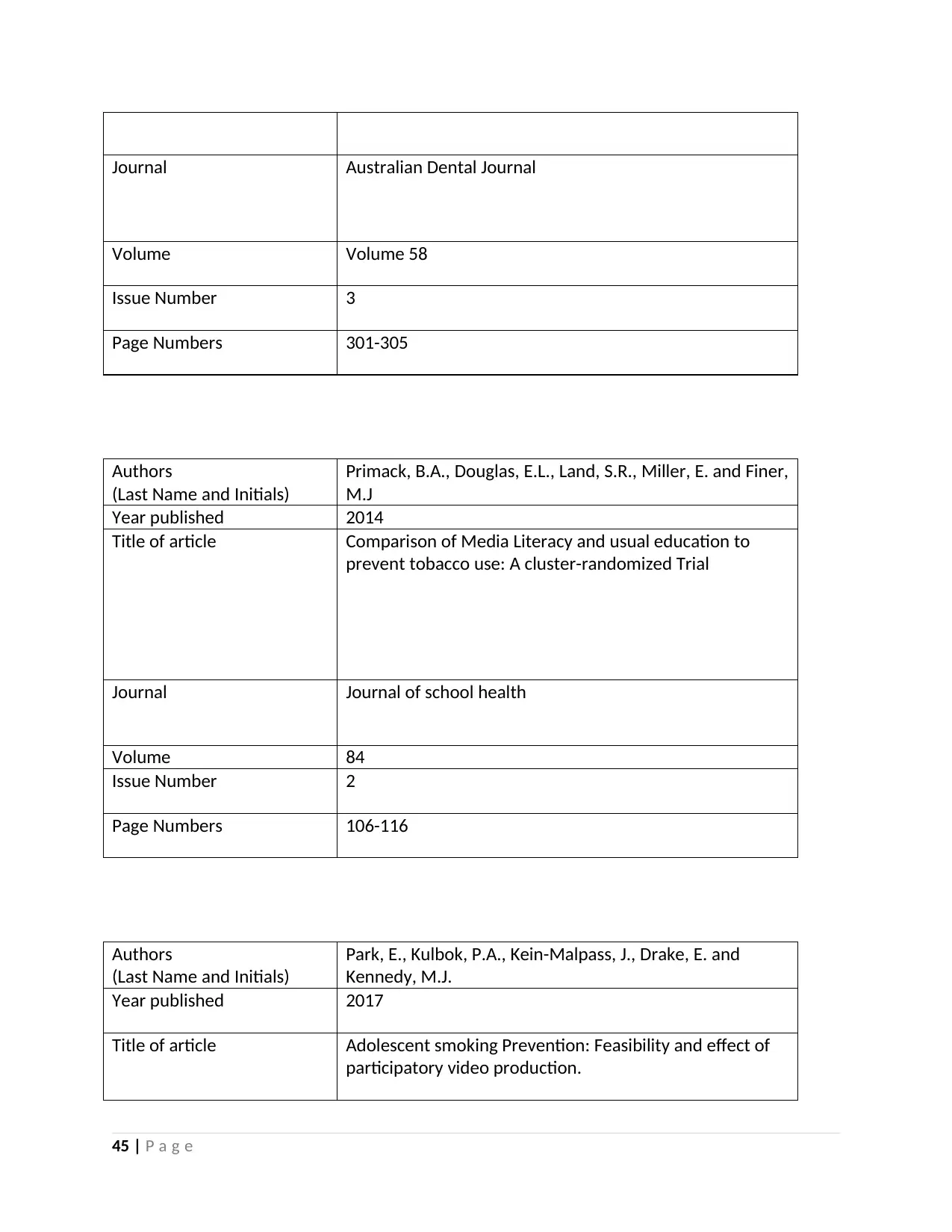
Journal Australian Dental Journal
Volume Volume 58
Issue Number 3
Page Numbers 301-305
Authors
(Last Name and Initials)
Primack, B.A., Douglas, E.L., Land, S.R., Miller, E. and Finer,
M.J
Year published 2014
Title of article Comparison of Media Literacy and usual education to
prevent tobacco use: A cluster-randomized Trial
Journal Journal of school health
Volume 84
Issue Number 2
Page Numbers 106-116
Authors
(Last Name and Initials)
Park, E., Kulbok, P.A., Kein-Malpass, J., Drake, E. and
Kennedy, M.J.
Year published 2017
Title of article Adolescent smoking Prevention: Feasibility and effect of
participatory video production.
45 | P a g e
Volume Volume 58
Issue Number 3
Page Numbers 301-305
Authors
(Last Name and Initials)
Primack, B.A., Douglas, E.L., Land, S.R., Miller, E. and Finer,
M.J
Year published 2014
Title of article Comparison of Media Literacy and usual education to
prevent tobacco use: A cluster-randomized Trial
Journal Journal of school health
Volume 84
Issue Number 2
Page Numbers 106-116
Authors
(Last Name and Initials)
Park, E., Kulbok, P.A., Kein-Malpass, J., Drake, E. and
Kennedy, M.J.
Year published 2017
Title of article Adolescent smoking Prevention: Feasibility and effect of
participatory video production.
45 | P a g e
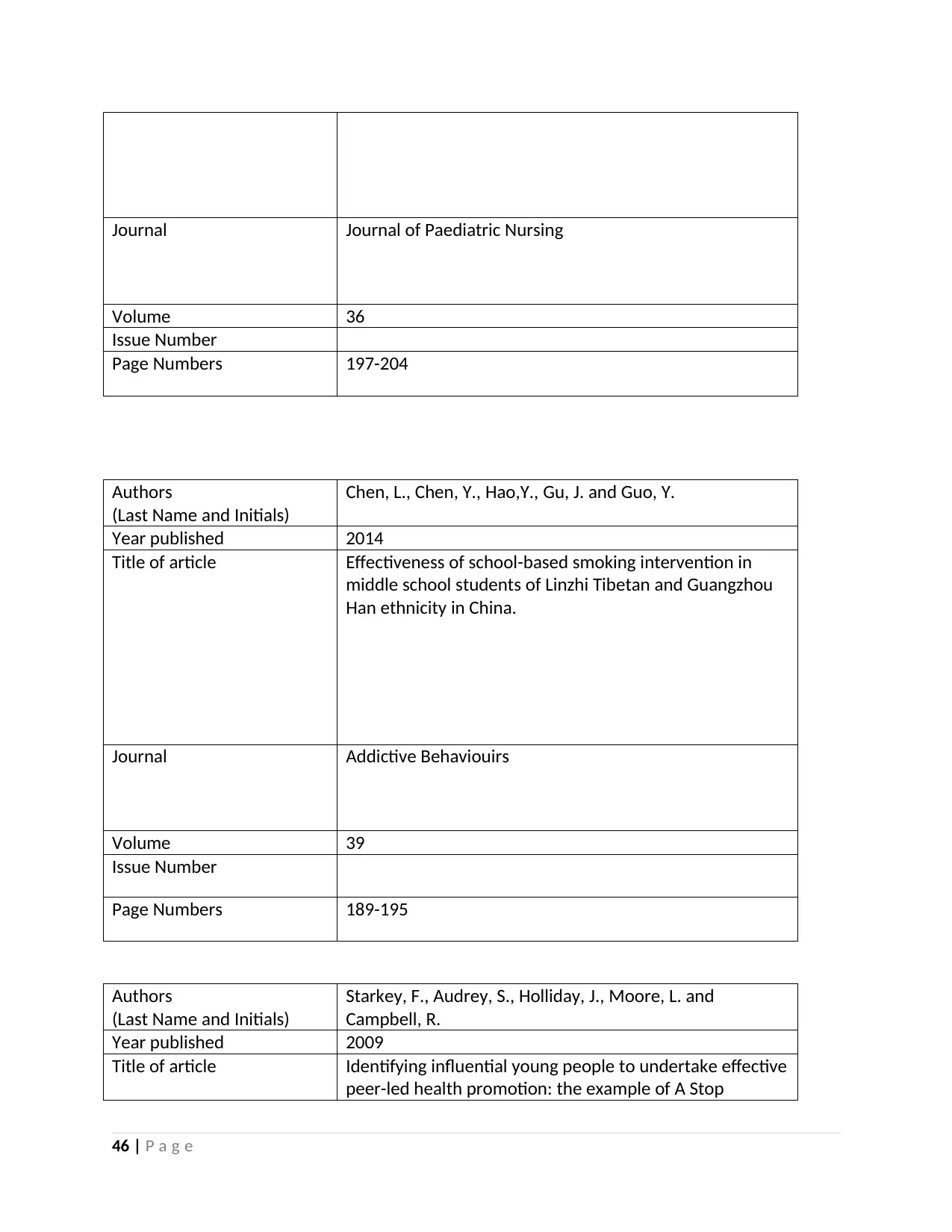
Journal Journal of Paediatric Nursing
Volume 36
Issue Number
Page Numbers 197-204
Authors
(Last Name and Initials)
Chen, L., Chen, Y., Hao,Y., Gu, J. and Guo, Y.
Year published 2014
Title of article Effectiveness of school-based smoking intervention in
middle school students of Linzhi Tibetan and Guangzhou
Han ethnicity in China.
Journal Addictive Behaviouirs
Volume 39
Issue Number
Page Numbers 189-195
Authors
(Last Name and Initials)
Starkey, F., Audrey, S., Holliday, J., Moore, L. and
Campbell, R.
Year published 2009
Title of article Identifying influential young people to undertake effective
peer-led health promotion: the example of A Stop
46 | P a g e
Volume 36
Issue Number
Page Numbers 197-204
Authors
(Last Name and Initials)
Chen, L., Chen, Y., Hao,Y., Gu, J. and Guo, Y.
Year published 2014
Title of article Effectiveness of school-based smoking intervention in
middle school students of Linzhi Tibetan and Guangzhou
Han ethnicity in China.
Journal Addictive Behaviouirs
Volume 39
Issue Number
Page Numbers 189-195
Authors
(Last Name and Initials)
Starkey, F., Audrey, S., Holliday, J., Moore, L. and
Campbell, R.
Year published 2009
Title of article Identifying influential young people to undertake effective
peer-led health promotion: the example of A Stop
46 | P a g e
Paraphrase This Document
Need a fresh take? Get an instant paraphrase of this document with our AI Paraphraser

Smoking In School Trial (ASSIST)
Journal Health Education Research
Volume 25
Issue Number 6
Page Numbers 977-988
Authors
(Last Name and Initials)
Kousoulis, A., Kyinpouropoulos, S.P., Pouli, D.K.,
Economopoulos, K.P. and Vardavas, C.I.
Year published 2016
Title of article From the classroom to Facebook: A Fresh Approach for
Youth Tobacco Prevention
Journal American Journal of Health Promotion
Volume 30
Issue Number 5
Page Numbers 390-393
Aveyard, H. (2018) Doing a Literature Review in Health and Social Care: A Practical Guide. Open
University Press.
47 | P a g e
Journal Health Education Research
Volume 25
Issue Number 6
Page Numbers 977-988
Authors
(Last Name and Initials)
Kousoulis, A., Kyinpouropoulos, S.P., Pouli, D.K.,
Economopoulos, K.P. and Vardavas, C.I.
Year published 2016
Title of article From the classroom to Facebook: A Fresh Approach for
Youth Tobacco Prevention
Journal American Journal of Health Promotion
Volume 30
Issue Number 5
Page Numbers 390-393
Aveyard, H. (2018) Doing a Literature Review in Health and Social Care: A Practical Guide. Open
University Press.
47 | P a g e
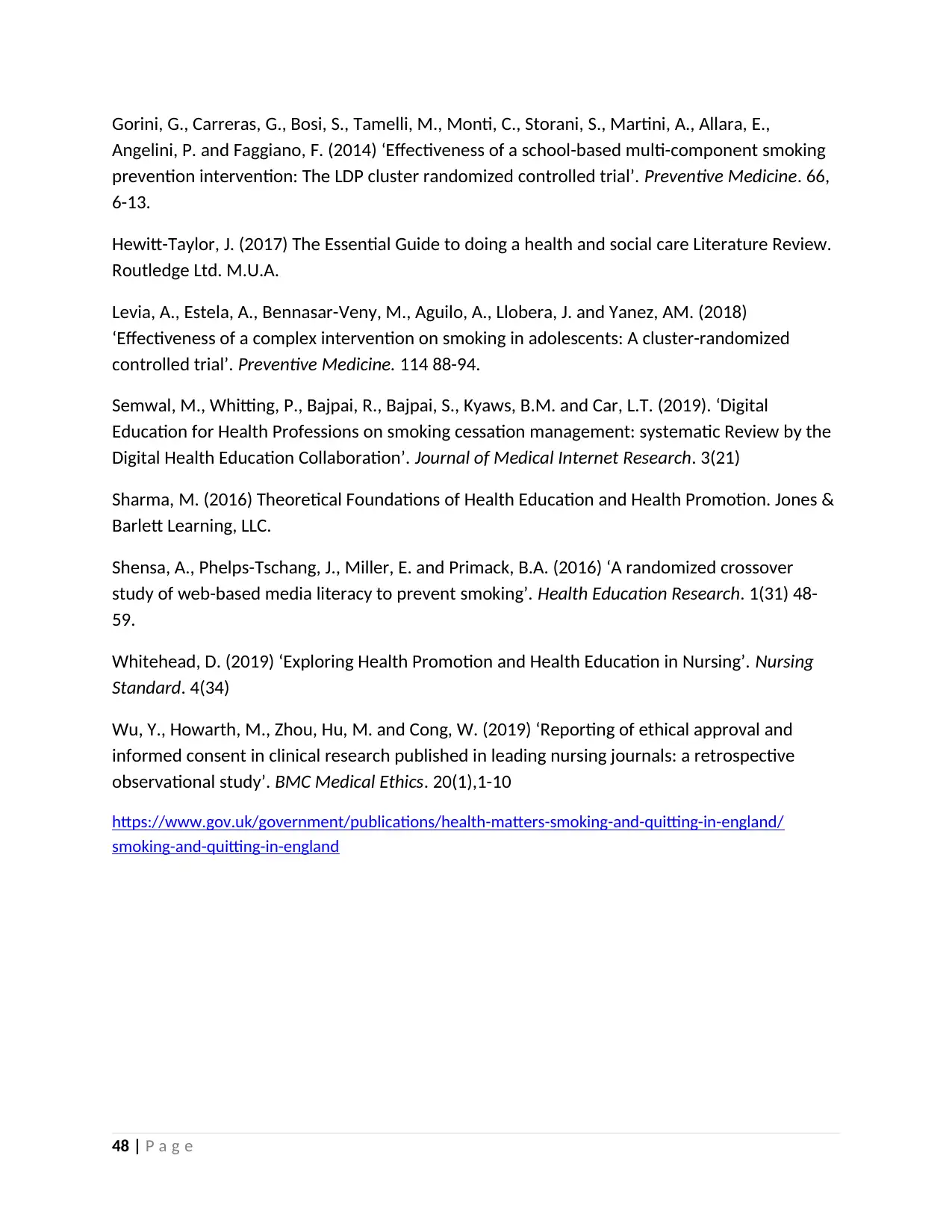
Gorini, G., Carreras, G., Bosi, S., Tamelli, M., Monti, C., Storani, S., Martini, A., Allara, E.,
Angelini, P. and Faggiano, F. (2014) ‘Effectiveness of a school-based multi-component smoking
prevention intervention: The LDP cluster randomized controlled trial’. Preventive Medicine. 66,
6-13.
Hewitt-Taylor, J. (2017) The Essential Guide to doing a health and social care Literature Review.
Routledge Ltd. M.U.A.
Levia, A., Estela, A., Bennasar-Veny, M., Aguilo, A., Llobera, J. and Yanez, AM. (2018)
‘Effectiveness of a complex intervention on smoking in adolescents: A cluster-randomized
controlled trial’. Preventive Medicine. 114 88-94.
Semwal, M., Whitting, P., Bajpai, R., Bajpai, S., Kyaws, B.M. and Car, L.T. (2019). ‘Digital
Education for Health Professions on smoking cessation management: systematic Review by the
Digital Health Education Collaboration’. Journal of Medical Internet Research. 3(21)
Sharma, M. (2016) Theoretical Foundations of Health Education and Health Promotion. Jones &
Barlett Learning, LLC.
Shensa, A., Phelps-Tschang, J., Miller, E. and Primack, B.A. (2016) ‘A randomized crossover
study of web-based media literacy to prevent smoking’. Health Education Research. 1(31) 48-
59.
Whitehead, D. (2019) ‘Exploring Health Promotion and Health Education in Nursing’. Nursing
Standard. 4(34)
Wu, Y., Howarth, M., Zhou, Hu, M. and Cong, W. (2019) ‘Reporting of ethical approval and
informed consent in clinical research published in leading nursing journals: a retrospective
observational study’. BMC Medical Ethics. 20(1),1-10
https://www.gov.uk/government/publications/health-matters-smoking-and-quitting-in-england/
smoking-and-quitting-in-england
48 | P a g e
Angelini, P. and Faggiano, F. (2014) ‘Effectiveness of a school-based multi-component smoking
prevention intervention: The LDP cluster randomized controlled trial’. Preventive Medicine. 66,
6-13.
Hewitt-Taylor, J. (2017) The Essential Guide to doing a health and social care Literature Review.
Routledge Ltd. M.U.A.
Levia, A., Estela, A., Bennasar-Veny, M., Aguilo, A., Llobera, J. and Yanez, AM. (2018)
‘Effectiveness of a complex intervention on smoking in adolescents: A cluster-randomized
controlled trial’. Preventive Medicine. 114 88-94.
Semwal, M., Whitting, P., Bajpai, R., Bajpai, S., Kyaws, B.M. and Car, L.T. (2019). ‘Digital
Education for Health Professions on smoking cessation management: systematic Review by the
Digital Health Education Collaboration’. Journal of Medical Internet Research. 3(21)
Sharma, M. (2016) Theoretical Foundations of Health Education and Health Promotion. Jones &
Barlett Learning, LLC.
Shensa, A., Phelps-Tschang, J., Miller, E. and Primack, B.A. (2016) ‘A randomized crossover
study of web-based media literacy to prevent smoking’. Health Education Research. 1(31) 48-
59.
Whitehead, D. (2019) ‘Exploring Health Promotion and Health Education in Nursing’. Nursing
Standard. 4(34)
Wu, Y., Howarth, M., Zhou, Hu, M. and Cong, W. (2019) ‘Reporting of ethical approval and
informed consent in clinical research published in leading nursing journals: a retrospective
observational study’. BMC Medical Ethics. 20(1),1-10
https://www.gov.uk/government/publications/health-matters-smoking-and-quitting-in-england/
smoking-and-quitting-in-england
48 | P a g e

49 | P a g e
1 out of 49
Your All-in-One AI-Powered Toolkit for Academic Success.
+13062052269
info@desklib.com
Available 24*7 on WhatsApp / Email
![[object Object]](/_next/static/media/star-bottom.7253800d.svg)
Unlock your academic potential
© 2024 | Zucol Services PVT LTD | All rights reserved.
